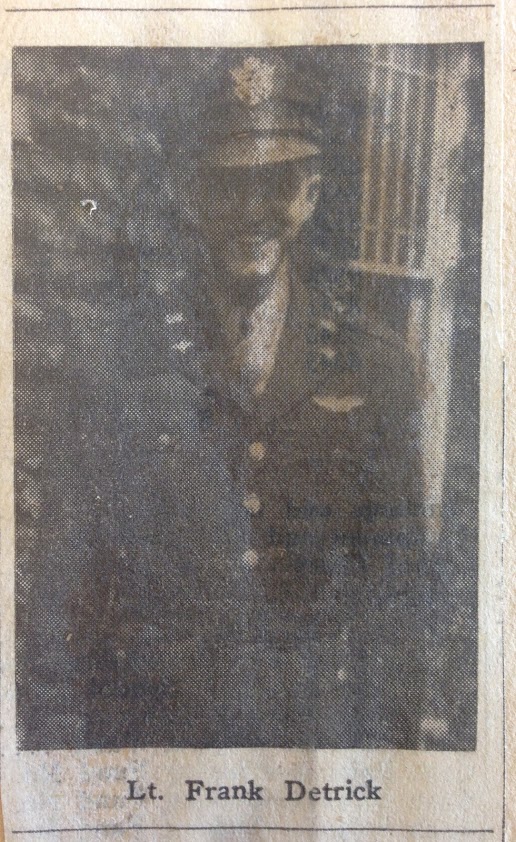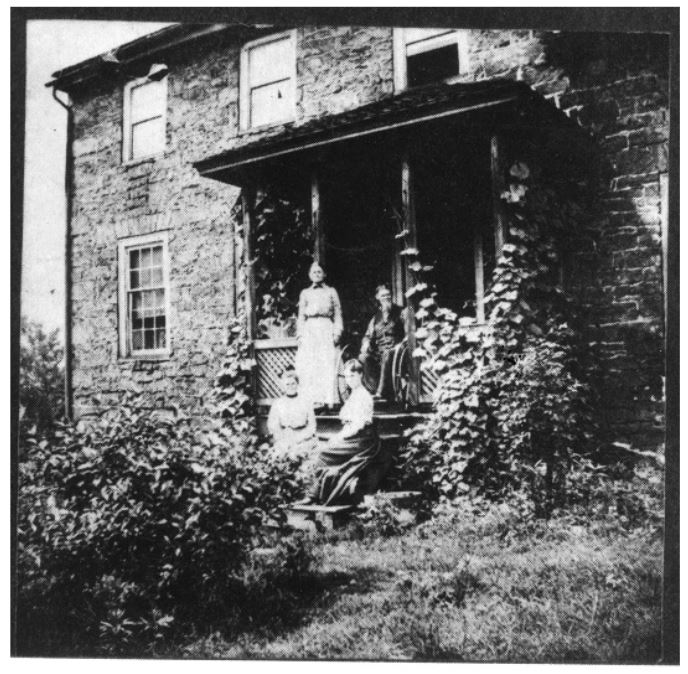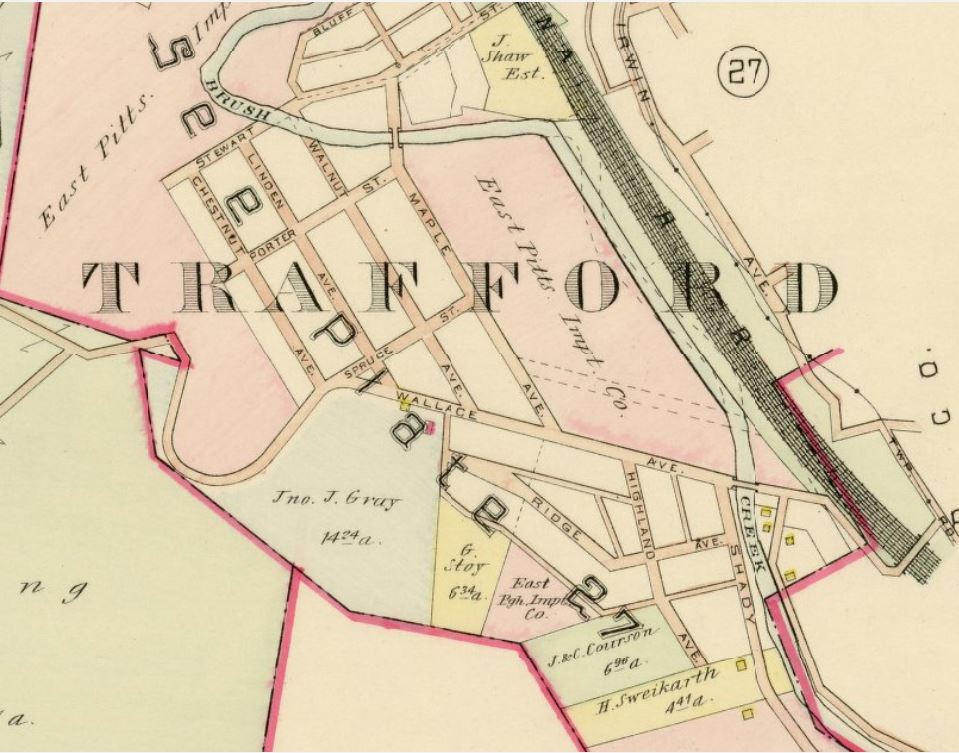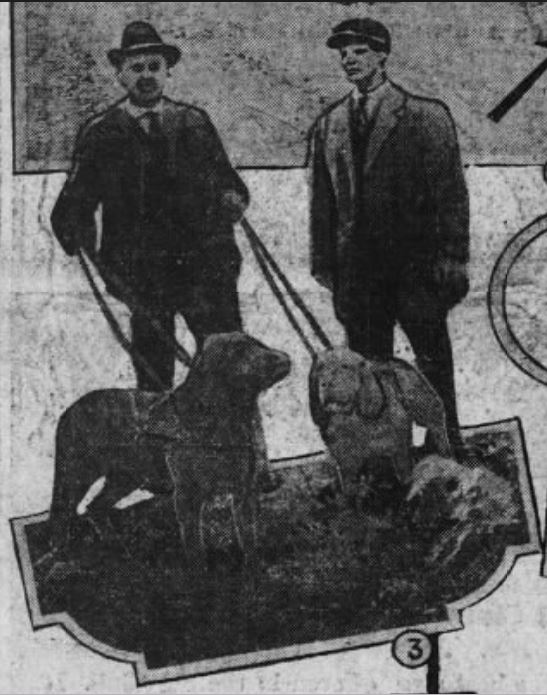#52Ancestors
What is #52Ancestors?
The concept was derived as a personal challenge in the genealogical community to research and write a story, a statement, or share a photo once a week for 52 weeks of the year, about a family ancestor. The "hashtag 52ancestors" is used on social media to share the stories and photos. For the Trafford History website, I plan to share a photo, or write a post, once a week about a person (or family) considered an "Ancestor of Trafford." The point is to challenge the researcher to take the knowledge, facts, or trivia about an ancestor out of the file drawers or photo boxes and share them with others. These photos and articles displayed here can be shared or commented on by following the link for the date it was published on Facebook. If you have a suggestion, or you would like to write an article or post a photo about Trafford or the Early Settlements, please contact us.
Week 52 Published by Andrew Capets December 22, 2019
The final #52ancestors post for 2019 covers the topic of the Trafford High Voltage Laboratory. There are plenty of people still around today who can tell you about attending a Westinghouse Family Day and witnessing this experiment where 3-million volts of electricity would strike a car occupied by one of the Westinghouse employees. This experiment was first undertaken by Westinghouse engineer Dr. Gilbert D McGann (1912-2003).
Week 51 Published by Dan Bugiski December 15, 2019
The Greatest Basketball Game Ever Played in the Trafford High School Gymnasium!
The most unusual, if not the greatest, basketball game ever played in Trafford occurred on January 24, 1961. The game occurred at a time when the major topic of discussion amongst the basketball elites of the world centered on the pace of the game. Most of the top coaches, both high school and college, adhered to the traditional style of play. That is, coaches taught their teams to look for the better shot. By better, I mean closer to the basket regardless of how much time it took. After all, it often made sense that a shot taken closer to the basket was a better shot than one taken from a distance, especially since all field goals at that time counted for two points. High school games tended to be tactical, low scoring games. The 3-point field goal and the shot clock would not be introduced to high school basketball until the late 1980s.
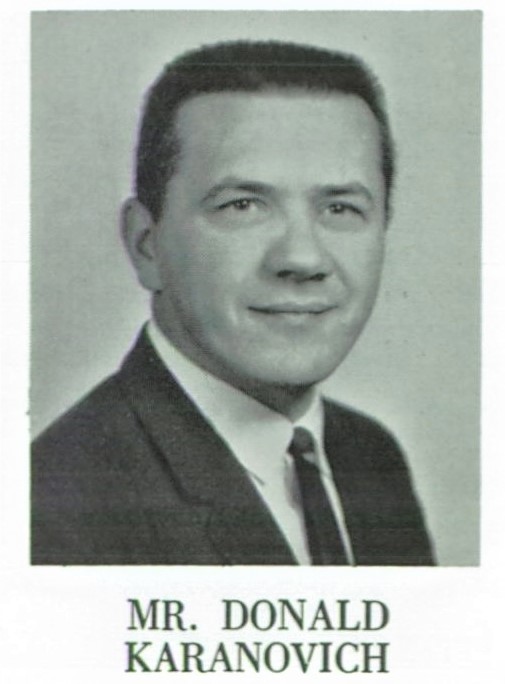 The Trafford head coach at that time was Donald Karanovich (1922-2015), a former University of Pittsburgh football player. Despite not having a basketball background, Karanovich employed strategies that were on the cutting edge. He had to find ways to adapt his team to their opponents. After all, the graduating classes at Trafford High School were quite small, usually only about sixty or less students per grade.
The Trafford head coach at that time was Donald Karanovich (1922-2015), a former University of Pittsburgh football player. Despite not having a basketball background, Karanovich employed strategies that were on the cutting edge. He had to find ways to adapt his team to their opponents. After all, the graduating classes at Trafford High School were quite small, usually only about sixty or less students per grade.
The 1961 Tomahawks, wearing their brown and white uniforms, were loaded with talent, and they knew it. The Trafford team back then reminds me of the movie "Hoosiers." If you’ve seen that movie, you know what I am talking about. Aside from the unusual game itself, the Trafford team was quite uncommon in and of itself, especially for such a small town like Trafford. The starting five was made up of multiple Division I college prospects.
Not to anyone's surprise, Trafford started the season with a loss to Norwin. This was understandable to most at the time because many of the Trafford players, who also happened to be on the undefeated 1960 football team, really didn't have much time to prepare for the upcoming basketball season. What made their first game even more challenging was the fact that Norwin High had about 1500 students in their high school at that time, and the game was played on their court.
After that season opening loss, the Tomahawks ran off a string of wins, losing a couple of games to Edgewood, and one to Sewickley (now Southmoreland High) in a 55-60 upset. That game was played on the road, and it’s uncertain what was said in the locker room at halftime, but after the game rumor had it that Coach Karanovich, always the gentleman, was somewhat angry! He knew he had the thoroughbreds, and he knew that they took the Sewickley team lightly, and he knew his Trafford team did not play well. The next game would have to be different, and oh boy, was it ever!
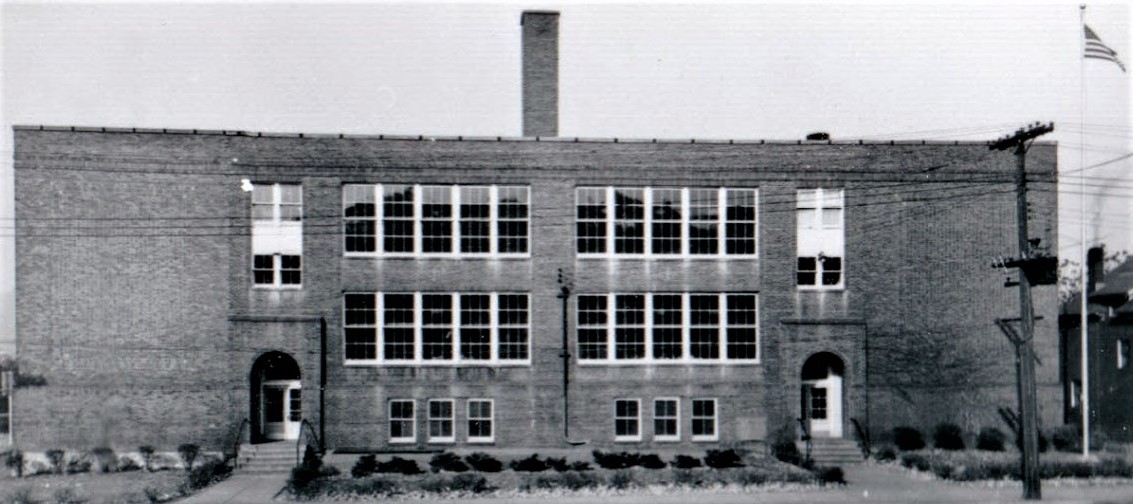
What I remember most about that “Greatest Game” was getting out of school at 3:30 PM, RUNNING home to grab a quick bite to eat and a change of clothing, and then RUNNING back to the high school to arrive there by 4:30 PM just to get a seat. By 5:00 PM the gym was packed, standing room only for a game that did not start until 8:15 PM. The almost four-hour wait was worth it. Little did we know at the time what we were about to witness.
Word was out that Sewickley was upset earlier in the week, and if Trafford could beat their next opponent, Ligonier, it would mean that Trafford would become the section champions. Coach Karanovich shocked the taller and more muscular Ligonier Mounties team by taking advantage of Trafford’s strengths of foot speed and ball handling. The boys wearing brown and white ran their bewildered opponents right out of the gym by employing a strategy that was practically unheard of at that time: A FULL COURT ZONE PRESS!
This was a cutting-edge defense that could be employed only if you had quick players. This type of defense made it difficult for opponents because whoever had the ball always seemed to be double teamed. The opponents were shaken and confused. The speed of the game was insane, to say the least. All ten players on the court ran up and down the court at breakneck speeds. Not a second was wasted: pass, pass, shot, sprint, pass, pass, shot! The Tomahawks forced their will on their opponent, forcing them to play Trafford’s game! You could almost smell the rubber burning off their gym shoes. When the smoke had cleared, Trafford High had 62 points in the first half.
The taller and thicker opponent played quite well, but they had never experienced a game such as this. You could see the look of bewilderment in their eyes and Coach Karanovich wasn't about to let off the gas. The Tomahawks just kept pouring it on. The second half was just as crazy, and when the smoke had cleared, the scoreboard read: TRAFFORD 130 - LIGONIER 81.
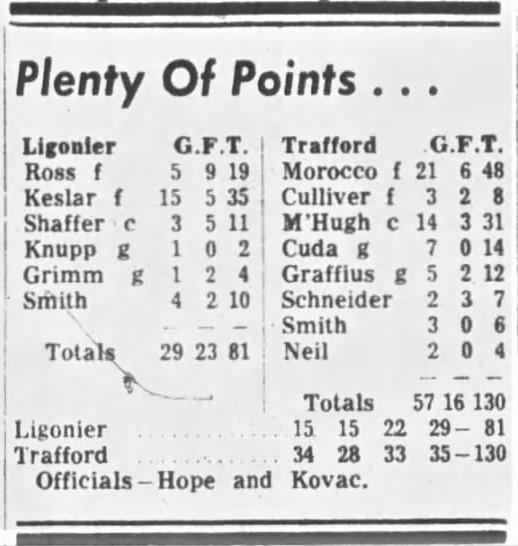 The spectators had just observed the Tomahawks in the greatest game ever played in that old Trafford High School gymnasium. An incredible 211 points were scored in that game. Remember, no shot clock and no three-point shot. High school basketball games at that time lasted 32 minutes which means there was a point scored every 9 seconds! Needless to say, anyone who was at that game never forgot it and they certainly received their money's worth from an admission cost of 25 cents! You had to feel some remorse for the Mounties. They scored 81 points, a lot for that era, but lost by 50 points.
The spectators had just observed the Tomahawks in the greatest game ever played in that old Trafford High School gymnasium. An incredible 211 points were scored in that game. Remember, no shot clock and no three-point shot. High school basketball games at that time lasted 32 minutes which means there was a point scored every 9 seconds! Needless to say, anyone who was at that game never forgot it and they certainly received their money's worth from an admission cost of 25 cents! You had to feel some remorse for the Mounties. They scored 81 points, a lot for that era, but lost by 50 points.
Four-year starter Tony Morocco scored a whopping 48 points in that game, which was reported in the Latrobe Bulletin newspaper as a single game scoring record for Trafford High School. While school stats no longer exist, Morocco is considered to be the all-time leading scorer from Trafford High. Senior player Tim McHugh scored 31 points and junior Vic Cuda scored 14. Even the opposing team’s Joe Keslar had an impressive 35-point game trying to keep up with the Tomahawks.
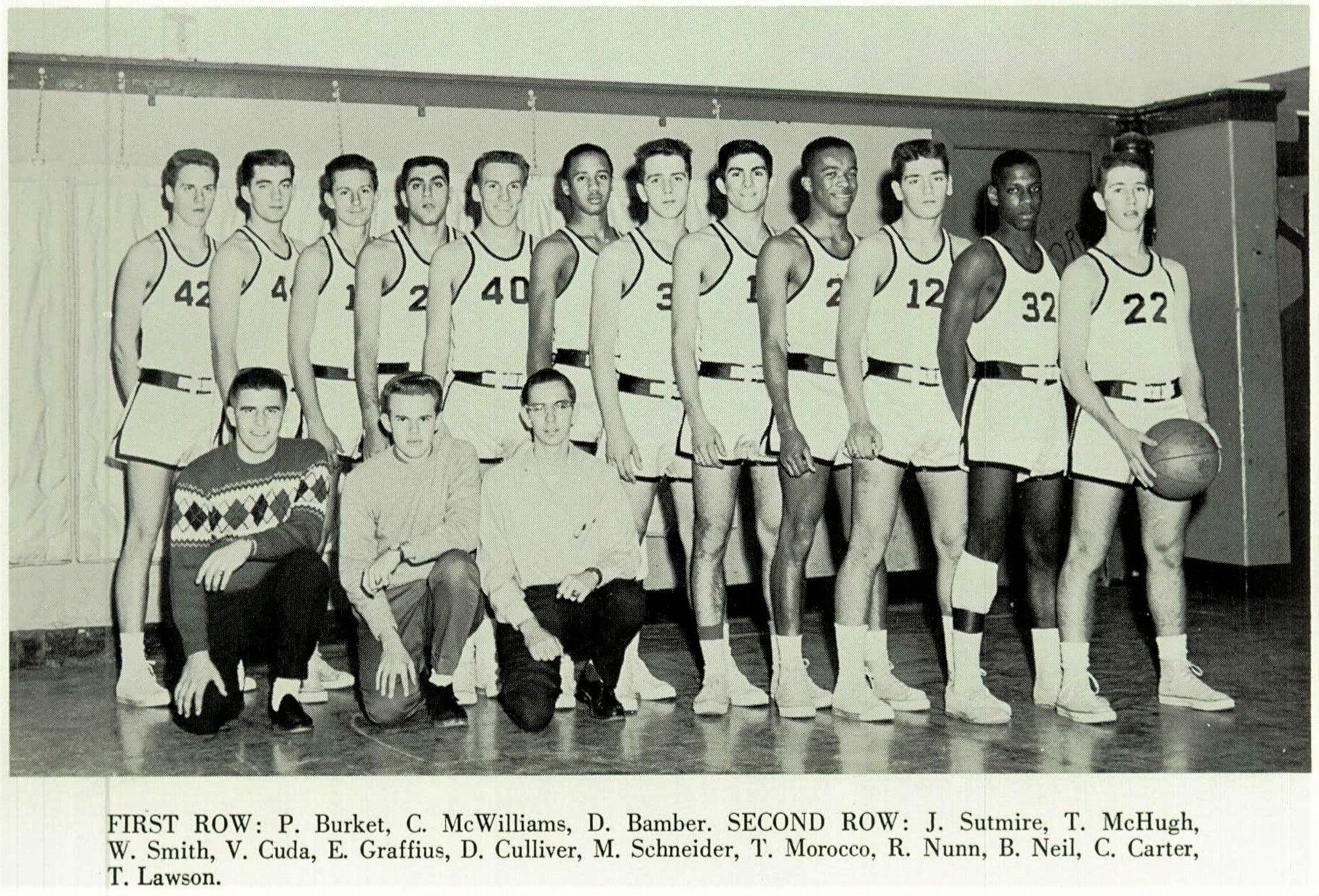
Consider this fact, several athletes on this one small town high school team received scholarships to play in top college programs following graduation. Morocco and teammate David Culliver were both named to the 1961 Post-Gazette’s All-WPIAL Quints team. Morocco was recruited by multiple Division I college schools and landed at top ranked Wichita State and played alongside future NBA player Dave Stallworth. While Morocco initially started at Wichita State, he later transferred to Youngstown State where he joined his former Trafford teammate Culliver who was later named to the YSU Athletics Hall of Fame. Culliver still ranks 10th on their all-time basketball scoring list.
Vic Cuda was a natural athlete, playing both basketball and football, and went on to set a Westmoreland County tournament scoring record the next year in a playoff game against East Huntington with an impressive 43 points. Even with this level of basketball skill, Cuda signed an ACC contract to play football at Clemson University. Marty Schneider, a 2019 Penn-Trafford Warrior Football HOF inductee, also attended Clemson to play football, making it a total of four Division I athletes on this one team. That's how good they were.
The Trafford team of 1961 went on to play in the state playoffs, competing in front of 4,800 fans at the Pitt Field House, only to lose to the eventual Pennsylvania State Champion Fort Cherry Rangers by a score of 55-52. One of the players on that opposing team happened to be future professional football player and NFL coach Marty Schottenheimer.
It has been 58 years since that game was played. I live in Arizona now, but I often think how lucky I was to grow up in Trafford and experience the GREATEST GAME EVER PLAYED in the Trafford High School Gym! -- Dan Bugiski, Trafford High Class of 1964.
Week 50 Published by Andrew Capets - December 8, 2019
Clarence Verner Lloyd was a 22-year-old clerk working at the Westinghouse Foundry in 1910 when he was courting his 17-year-old neighbor, Mabel Hird, who was then working as a stenographer. The couple married in 1911 and lived along Seventh Street Extension where Clarence started his floral business in 1913. This 1915 Hopkins Company map illustrates 7.41 acres of property owned by Mable’s father, James Hird, and her husband Clarence Lloyd. Only the outline of present-day Hird Road can be seen sketched on the map.
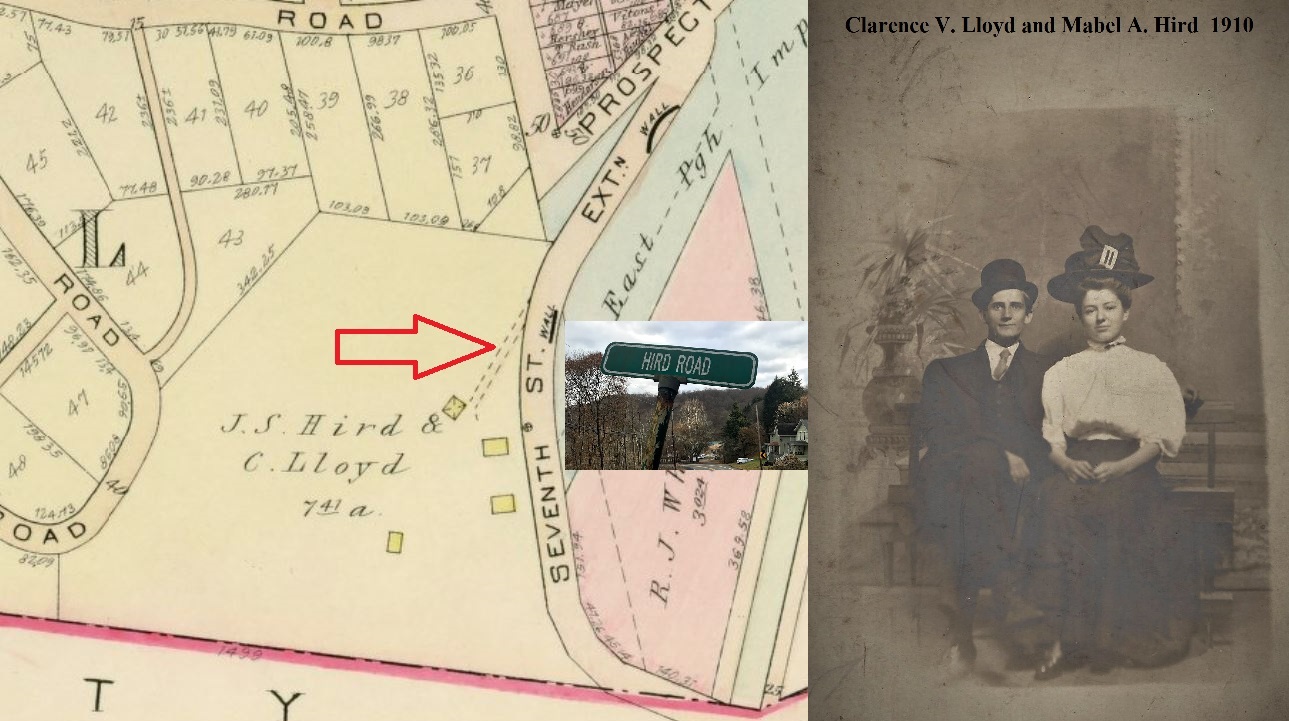
In June 1916, the Lloyds entered into a contract with the Trafford Oil & Gas Company to drill for natural gas, and in July 1916, a timber derrick was built on the property, right out in front of the Lloyd home. At one time there were three derricks built on the property, two are believed to have been owned by the Philadelphia Oil Company, one being built at the corner of Seventh Street Ext and Hird Road, and the other being constructed father back off the road as seen in the photo taken by Charles Vitous.
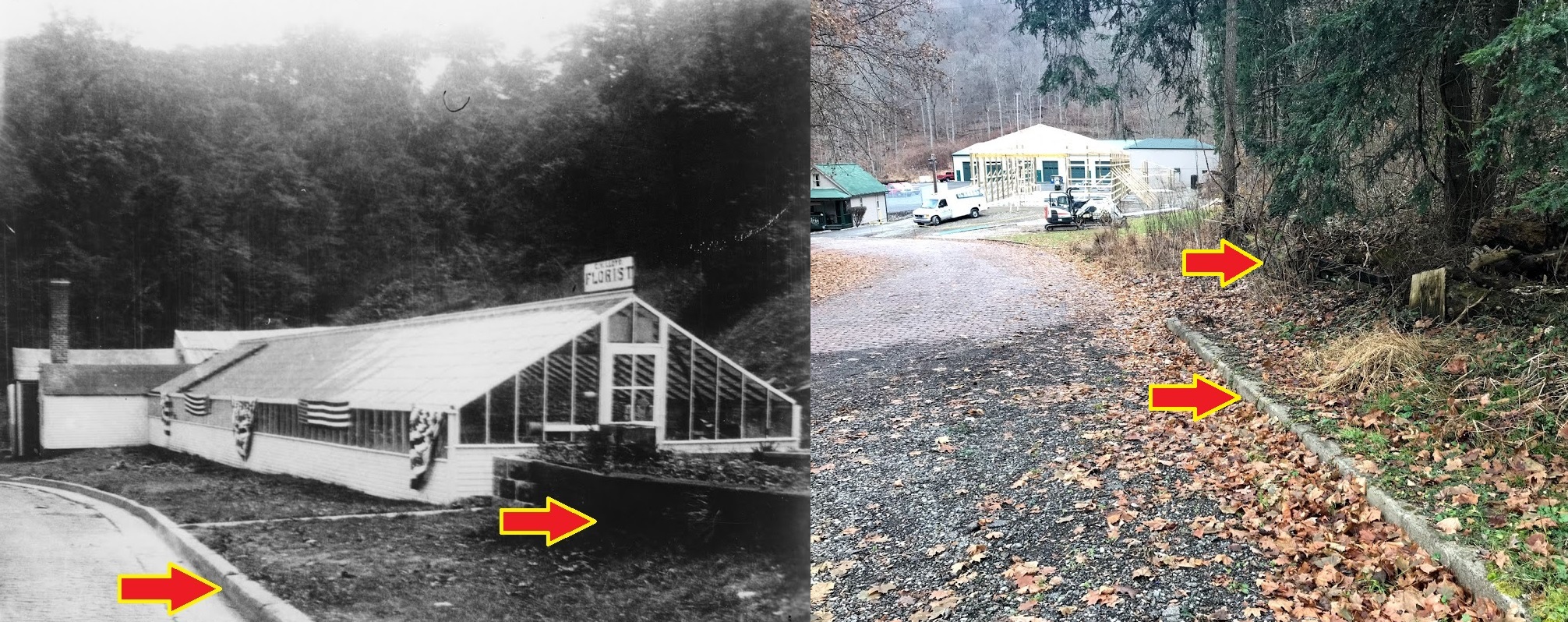
The Irwin Republican Standard newspaper reported on September 22, 1916, that “the gas well at the Lloyd’s property came in with a roar on Wednesday but caught fire before being capped. The derrick was completely destroyed and there is speculation as to the future of the well since it burned so furiously.” James & Dorothy Hird transferred their share of the property to Clarence & Mable in 1924, and as the floral business began to grow (pun intended) Clarence expanded his greenhouse space right along Seventh Street Extension. Remnants of the old garden walls can still be seen today.
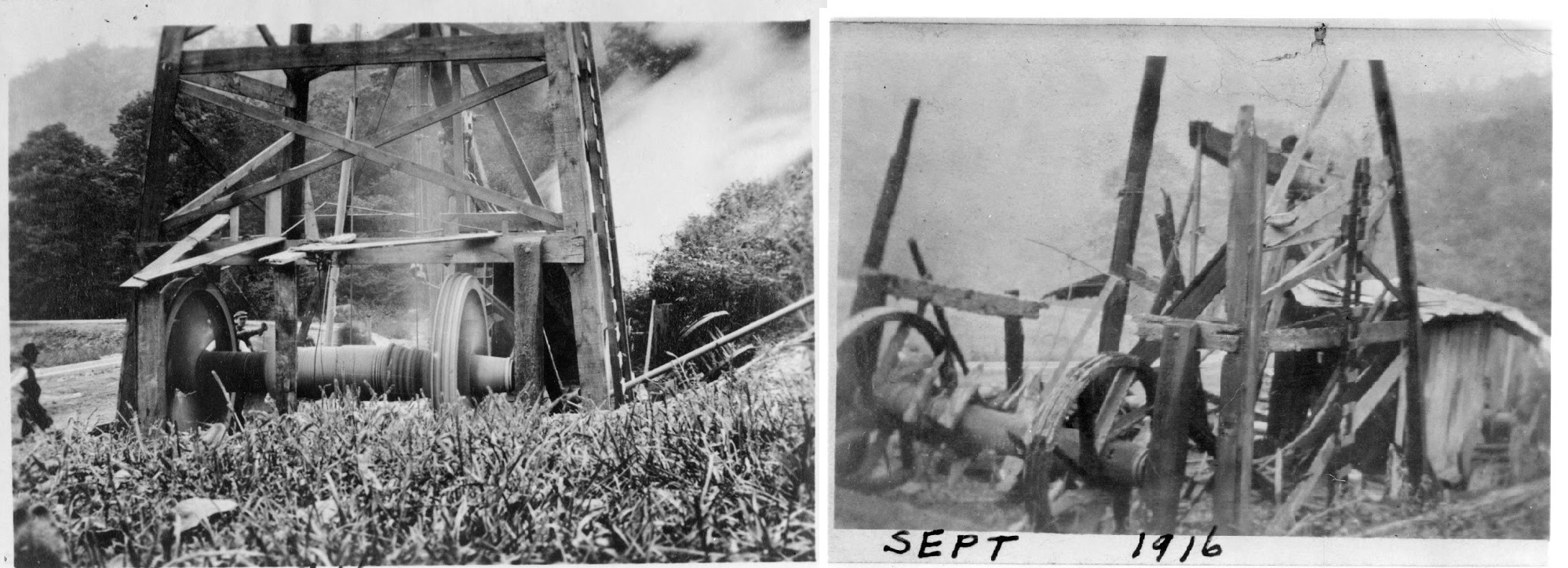
Clarence was a well-respected business owner in the Trafford Community, and in 1922 he was elected as Trafford’s Justice of the Peace. But life wasn’t always a bed of roses for Clarence. In 1926, he was rushed to Columbia Hospital in Wilkinsburg after being shot in a domestic dispute that occurred at his home. Both the Pittsburgh Daily Post and Pittsburgh Post-Gazette reported on the incident stating that Clarence had a sister Elva who was in a quarrel with her husband Harris Nobel Fritz. This couple had recently separated and an argument occurred at the Lloyd property when Harris accused Clarence of being the cause of the separation. An argument ensued and Harris allegedly fired two shots at his wife Elva, missing her, and causing Clarence to get into a struggled with Harris. When Clarence ran from the house, Harris fired one shot, hitting Clarence and lodging a bullet in his abdomen. Harris was later arrested by Chief of Police Michael Early.
Clarence eventually recovered from his injuries and continued to operate his floral business in Trafford for many years. In 1930, he was well received by the Trafford Rotary when he presented a talk, “The Tenants of My Profession,” speaking on the business of a florist and making a newsworthy presentation to this community group. Clarence passed in Trafford on December 6, 1969, at the age of 82. #52ancestors #fiftyyearsago
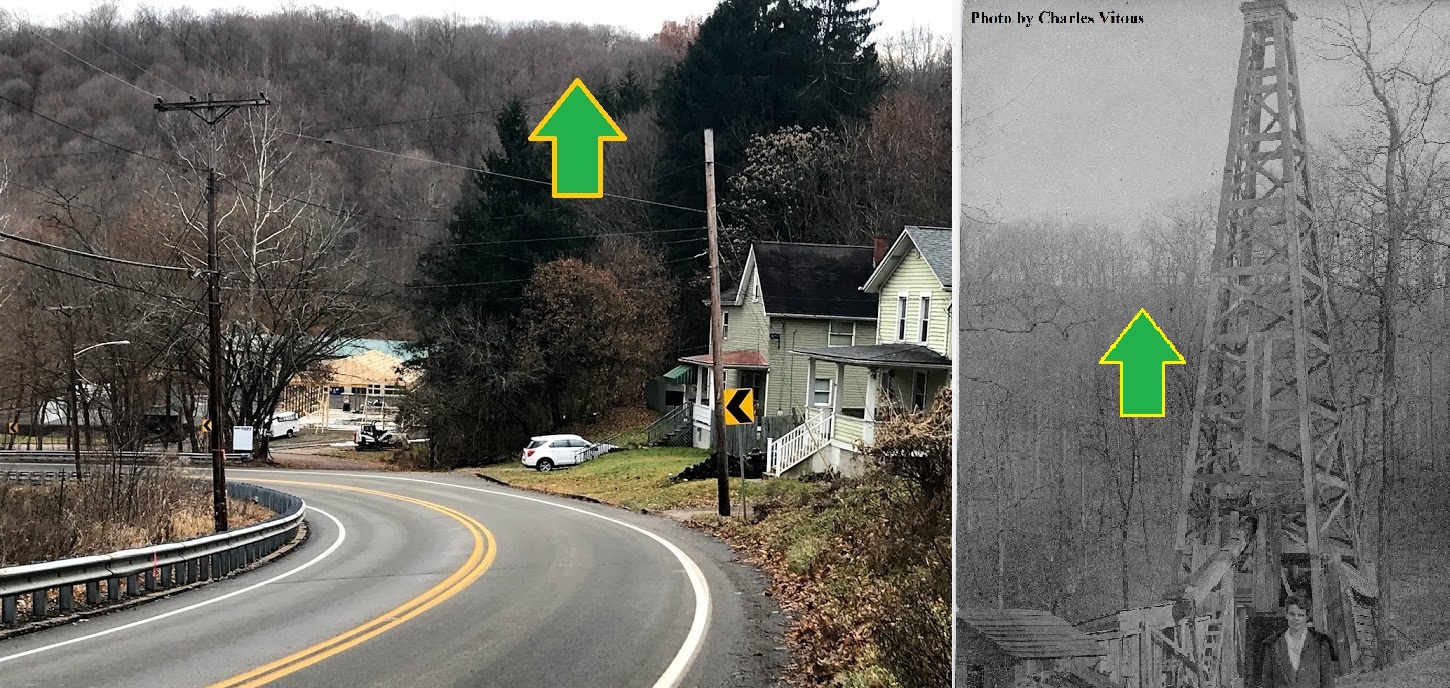
Week 49 Published by Andrew Capets - December 1, 2019
This week we remember Frank P. Wengrzyn who died on December 5, 1958, in a tragic accident that took his life and the lives of two other promising young engineers.

Wengrzyn, a 1951 graduate from Trafford High, was awarded an athletic scholarship to play football for the University of Pittsburgh. The 6 foot-4 inch, 240-pound football lineman was working out with the Pitt Panthers for only two weeks when he suddenly transferred out of Pitt and enrolled with Carnegie Institute of Technology (present-day Carnegie Mellon University). The Pittsburgh Post-Gazette reported that the transfer occurred after his mother apparently read a hospital list from a recent Steelers-49ers pro football game when she “decided Frankie boy ought to play in as minor a minor league as possible.” Despite his mother’s best intentions, “Frankie boy,” her chemical engineering student, still ended up in the hospital as the result of his play on the Tartan team when he broke his leg in the last game of the 1954 season competing against the Lehigh Engineers at Forbes Field.
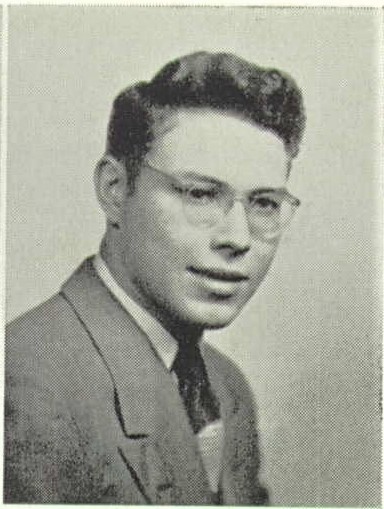 Wengrzyn was a stand-out college football player at Carnegie Tech, being recognized three years in a row by the Pittsburgh Press as one of their All-District Class B players (1953, 1954, 1955). In two of those years, Wengrzyn shared his honors with former Trafford High School players. Classmate Ron Peduzzi, then playing for Geneva College, was named to the All-District team in 1953, and John Lovre, playing for Clarion University, shared the newspaper’s 1955 top list with Wengrzyn (Lovre was a 2016 Penn-Trafford Warrior Football HOF inductee).
Wengrzyn was a stand-out college football player at Carnegie Tech, being recognized three years in a row by the Pittsburgh Press as one of their All-District Class B players (1953, 1954, 1955). In two of those years, Wengrzyn shared his honors with former Trafford High School players. Classmate Ron Peduzzi, then playing for Geneva College, was named to the All-District team in 1953, and John Lovre, playing for Clarion University, shared the newspaper’s 1955 top list with Wengrzyn (Lovre was a 2016 Penn-Trafford Warrior Football HOF inductee).
After college graduation, Wengrzyn found employment with the Callery Chemical Company in Butler, PA. He had been employed with the company a few years when he was transferred out to Independence, Kansas where the company was manufacturing a propellant used in intercontinental ballistic missiles. The newspapers reported that Wengrzyn, along with four other engineers, were working outside of company direction, and on their own time, in the construction of a rocket. The men had all taken turns packing a two-foot copper tube with an explosive material to be used as the propellant. A chain reaction occurred inside the homemade rocket causing it to spontaneously combust. The explosion killed 24-year-old Wengrzyn, along with William Reynolds, 29; and Charles Salles, 31. The other two engineers were seriously injured in the blast. One of the surviving engineers, Elmer Boyd, age 38, was able to talk to reporters from his hospital bed about what they were doing prior to the explosion. Boyd stated that the rocket contained “a fuel and an oxidizer. The oxidizer was magnesium perchlorate. I can’t tell you what the fuel was – that’s classified.” The other engineer hurt in the incident was 26-year-old Richard Wright.
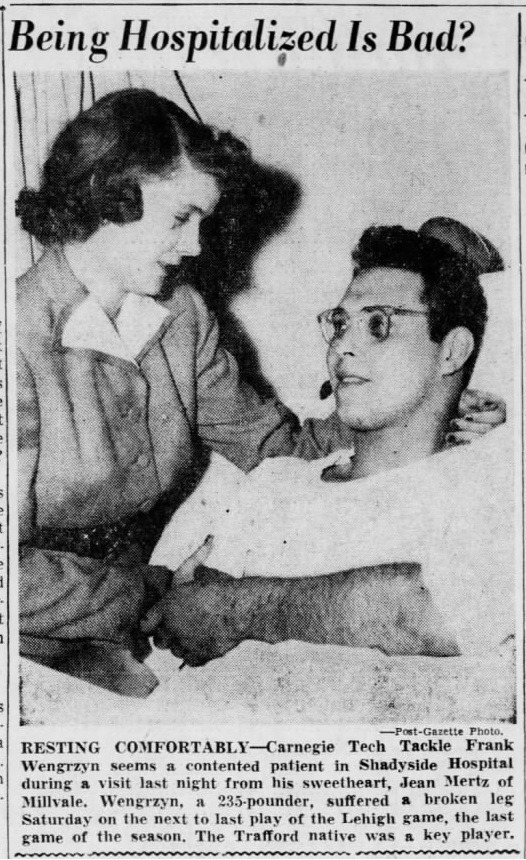
Wengrzyn’s body was returned to Pennsylvania and a funeral mass was said for him at Saint Ann’s Church in Millvale, the hometown of his wife Jean. In addition to his wife, Wengrzyn was survived by a two-year-old son Richard, parents Frank and Clara Wengrzyn, and his younger brother Robert, who was a member of Trafford High Class of 1958.
Week 48 Published by Andrew Capets - November 24, 2019
The skies were clear over Trafford on October 1, 1943, as two neighbors were outside taking advantage of the dry autumn weather. Marie Dubrava was sweeping the sidewalk in front of her home at 202 Edgewood Avenue. She lived in the last home on the left side of the street, just before the set of stairs that led to 1st Street. Across the road was Mrs. Anna Grace, cleaning up her now-defunct flower bed. Her son had enlisted in the military over a year ago, and while she was relieved that he was still State-side, she also knew it was a matter of time before he could be sent overseas to take part in the war. She gathered up the pile of dead flowers and headed toward her backyard.
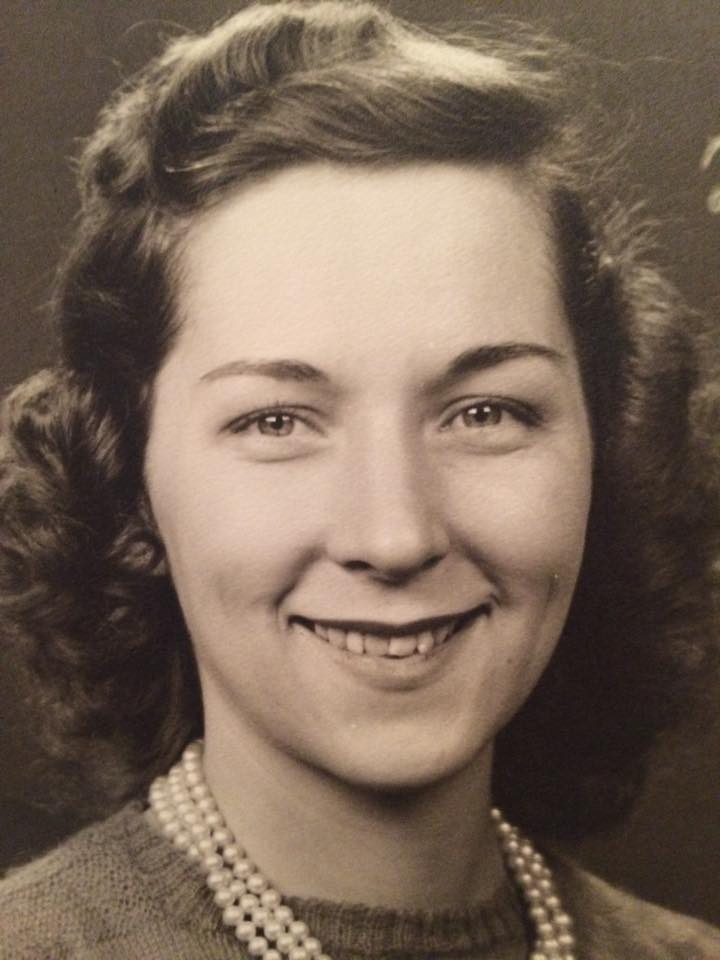 Marie watched her walk out of sight and then turned to start walking toward her own front door. Then Marie stopped. Hearing a slight humming sound that was unfamiliar to her, she paused and looked back across the street toward the Grace’s house. She stood still for a moment, trying to discern the nature of the sound. It was a dull droning sound; unlike the noise she was accustomed to hearing from the Westinghouse plant idling over the hill. The noise was getting louder, so she took a few steps back toward the street. As the intensity of the hum increased, she looked up Edgewood in the direction of the sound. The anticipation was building as she observed something you are not supposed to see in a residential neighborhood. She asked herself, “Is that a plane?”
Marie watched her walk out of sight and then turned to start walking toward her own front door. Then Marie stopped. Hearing a slight humming sound that was unfamiliar to her, she paused and looked back across the street toward the Grace’s house. She stood still for a moment, trying to discern the nature of the sound. It was a dull droning sound; unlike the noise she was accustomed to hearing from the Westinghouse plant idling over the hill. The noise was getting louder, so she took a few steps back toward the street. As the intensity of the hum increased, she looked up Edgewood in the direction of the sound. The anticipation was building as she observed something you are not supposed to see in a residential neighborhood. She asked herself, “Is that a plane?”
Marie observed a small airplane flying low, just above the oak trees lining her street. The plane was following a perfect line, right down the center of Edgewood Avenue, rustling the orange-colored leaves violently in its wake. The event seemed to be happening in slow motion, with the plane bearing down on her, but then the affair suddenly shook her senses and she began to process the incident. The plane approached her, faster and faster, and then an enormous thunder roared over her head. Too stunned to comprehend exactly what was happening, she never winced. Her eyes were fixated on the center of the plane, and in that brief moment of mammoth rumble, she captured an image that would forever be seared in her memory - a set of bright white teeth!
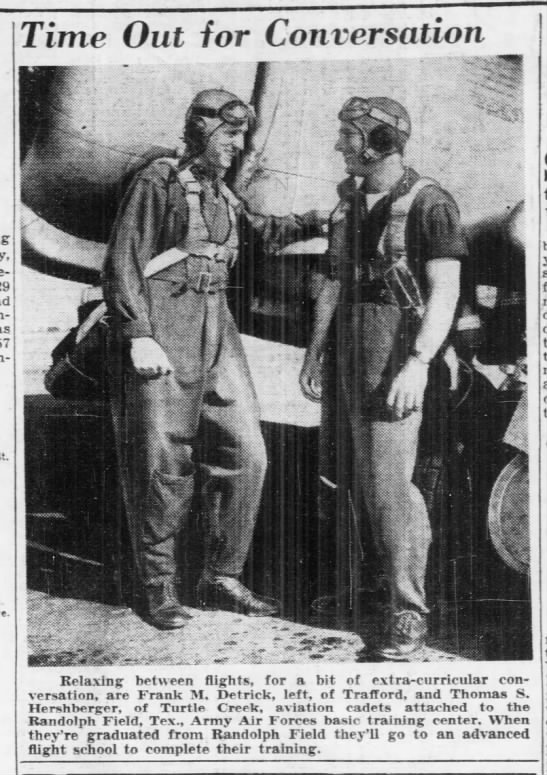 Marie seized the face of a young man grinning from ear to ear, a smile that projected thrill as much as it did mischief. The smile belonged to pilot Frank “Buddy” Detrick, a former Trafford schoolmate of hers. Detrick had enlisted in the Army Air Forces in the summer of 1942 and received his wings at Randolph Field in Texas on March 20, 1943. Detrick flew into Pittsburgh from an Army Air Force training center in Independence, Kansas. He was part of the 32d Flying Training Wing and was in the midst of a nine-week training program at the Independence Army Airfield. Part of his nine-weeks of training consisted of a cross-country navigation trip.
Marie seized the face of a young man grinning from ear to ear, a smile that projected thrill as much as it did mischief. The smile belonged to pilot Frank “Buddy” Detrick, a former Trafford schoolmate of hers. Detrick had enlisted in the Army Air Forces in the summer of 1942 and received his wings at Randolph Field in Texas on March 20, 1943. Detrick flew into Pittsburgh from an Army Air Force training center in Independence, Kansas. He was part of the 32d Flying Training Wing and was in the midst of a nine-week training program at the Independence Army Airfield. Part of his nine-weeks of training consisted of a cross-country navigation trip.
After flying down Edgewood Avenue, past his old elementary school, Detrick showed off for the students in his former high school by making a second pass to the delight of the students inside the old Fairmont Avenue building. Reynold Peduzzi, then in 6th grade, recalls the scene well. Rey remembers seeing the plane flying low enough to where he could see Detrick’s white scarf fluttering out the open cockpit window. Who wouldn’t remember the excitement of that day?
Detrick’s nickname Buddy, or Bud, was soon changed to “Buzz,” by every student that watched this pilot “buzz” their school. Apparently, that day also cemented the aspirations of a number of young men who weren’t quite sure what they wanted to do with their lives after school. It’s believed many young men were inoculated that day by “Buzz” and would later join the Army Air Force.
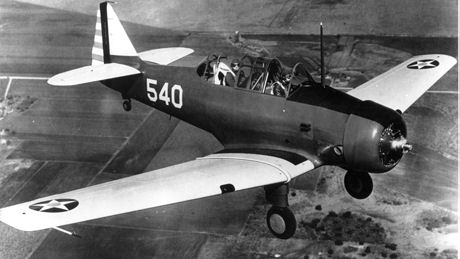
An unidentified newspaper clipping found in the Trafford Library’s scrapbook collection reads, “That airplane you may have seen flying over Trafford and vicinity last Saturday and over Wilmerding high school stadium, where the Wilmerding-Trafford football game was in progress (October 2, 1943), was piloted by Lt. Frank M. ‘Buddy’ Detrick, son of Mr. and Mrs. C.L. Mitchell, of 601 Sixth Street, Trafford. The plane is Lt. Detrick’s own and he was based at the County Airport on a navigational practice flight from Independence, Kansas. The flier, who ranks high in acrobatic flying, decided to fly over Trafford to give his friends and neighbors an intimate glimpse into flying. In so doing, he realized a dream of all air cadets, to fly over their own town. Lt. Detrick expressed thanks to H.E. Seville and L.A. Legory, his high school principals and to his many friends for buying bonds and helping to train him as a pilot.”
Photo sources:
Marie Dubrava Berklich (1919-2015) Trafford High Class of 1937. This photo was shared on Ancestry by user 'tracytom' on 28 May 2019.
Pilots: Pittsburgh Post-Gazette, Pittsburgh, PA Nov 30, 1942. BT-14 aircraft photo United States Air Force via Manning, Thomas A. (2005), History of Air Education and Training Command, 1942–2002. Office of History and Research, Headquarters, AETC, Randolph AFB, Texas ASIN: B000NYX3PC.
Frank McKinley Detrick (1920-1996) Trafford High Class of 1938. His headstone reads Frank “Bones” Detrick, Lt Col US Air Force. Source: Unidentified newspaper in the Trafford Community Public Library scrapbook (reference section Trafford History).
Week 47 Published by Andrew Capets - November 17, 2019
Trafford enjoyed several years of commercial prosperity following the end of World War II. Families in the community were experiencing the post-war economic expansion, and for many, this meant the addition of the first family car. In 1948, Frank Edward Caruso, a 31-year old former Westinghouse Airbrake employee, opened a service station in a garage that was initially built in 1930 but had sat idle for nearly a year. As car ownership increased, so did the need to supply fuel and provide vehicle repairs. Frank Caruso enjoyed success in offering these services at 225 Brinton Avenue, Trafford.

Take note of the photograph shown here from 1969. The sign that is barely visible behind the pile of tires reads, “We Give S&H Green Stamps.” Caruso was advertising the “green stamps” that were popular for supermarkets, department stores, and gas stations to attract customers to their business. The stamps could later be redeemed for products available in a catalog. Caruso took advantage of S&H newspaper marketing and added his own personal “hook” to help people remember the name of his business. Capitalizing on the popular 1951 movie, “The Great Caruso,” his branding was quite simple, “Trafford Service Station, CARUSO, Like the Great.”
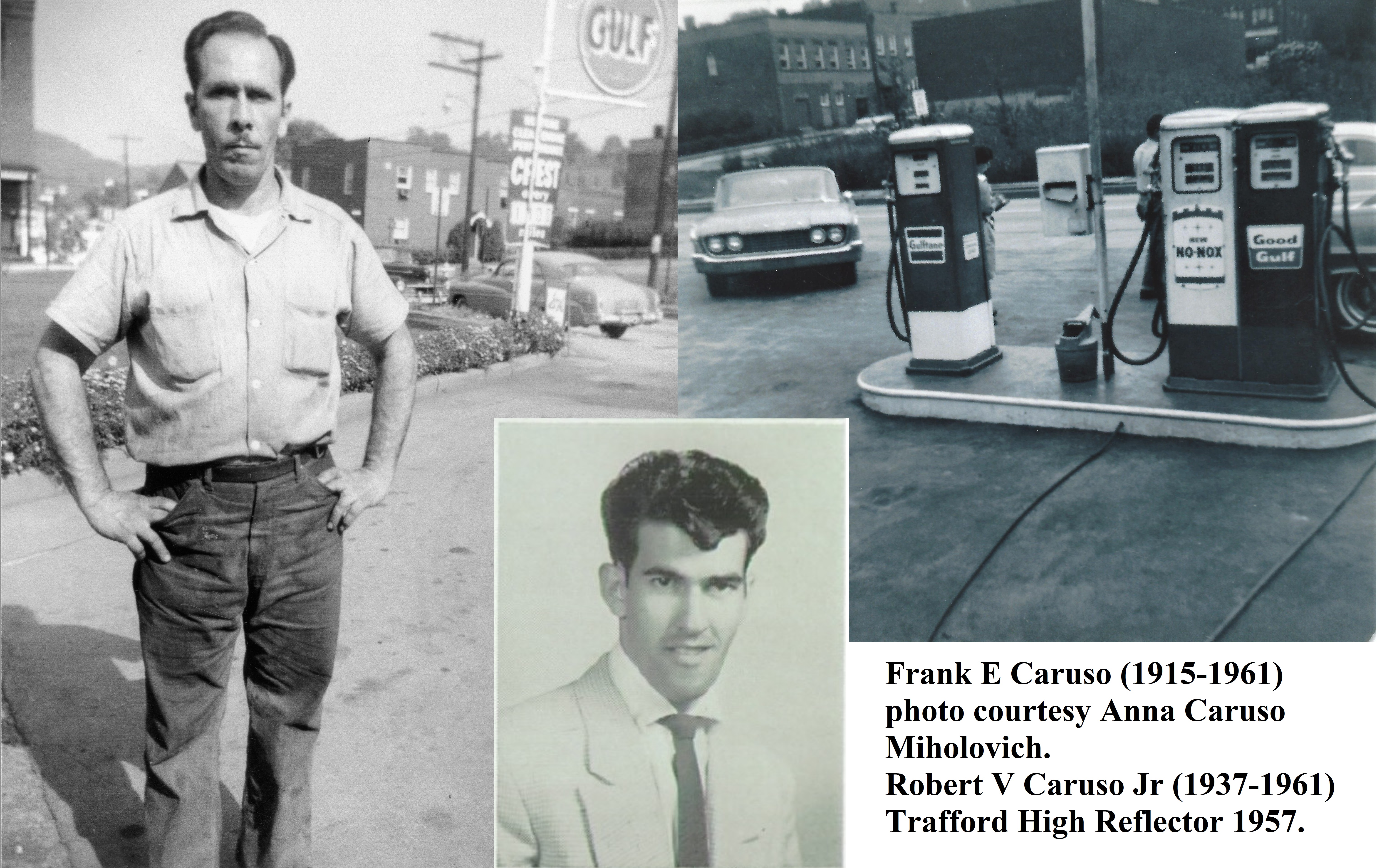
Recall the story from a couple of weeks ago about the 1920s service station in which Walter Lesher was operating a garage in Trafford when he passed away at the young age of 33 years, and in less than 3 months his brother James also passed away at a young age. The Caruso story bears some similarities to the Lesher story. Frank Caruso was operating the service station when he died prematurely in 1961 at the age of 45, and in less than three months, his youngest brother Robert V. Caruso Jr. passed away at the age of 23. There’s little doubt that this was a difficult time for the Caruso family. And while the Lesher family did not have anyone in a position to take over the garage business, the Caruso family was able to continue operating the business when Frank’s 26-year-old son, John R. Caruso, took over the service station and operated the garage until 1977.
Week 46 Published by Andrew Capets - November 11, 2019
For this week's #52ancestors, allow me to share the story of the Bolam family from Trafford and the article that appeared on TribLive Westmoreland.
Trafford marks park’s 100th anniversary on Veterans Day
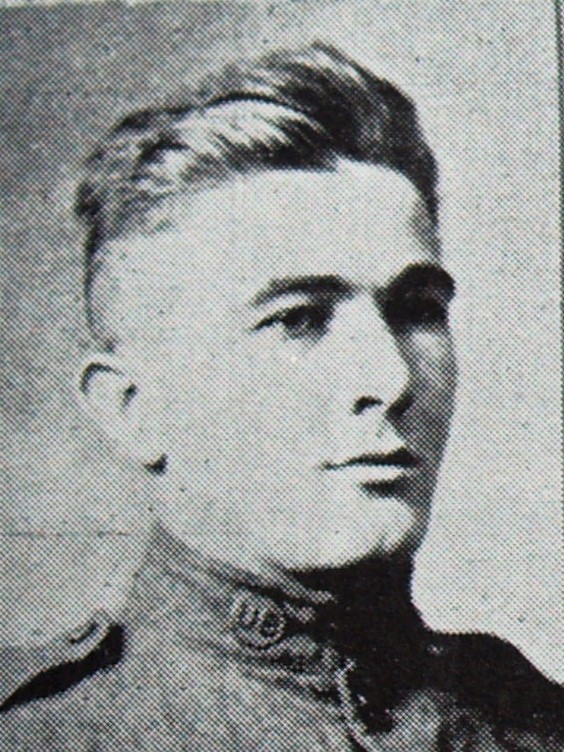
Edward A Bolam
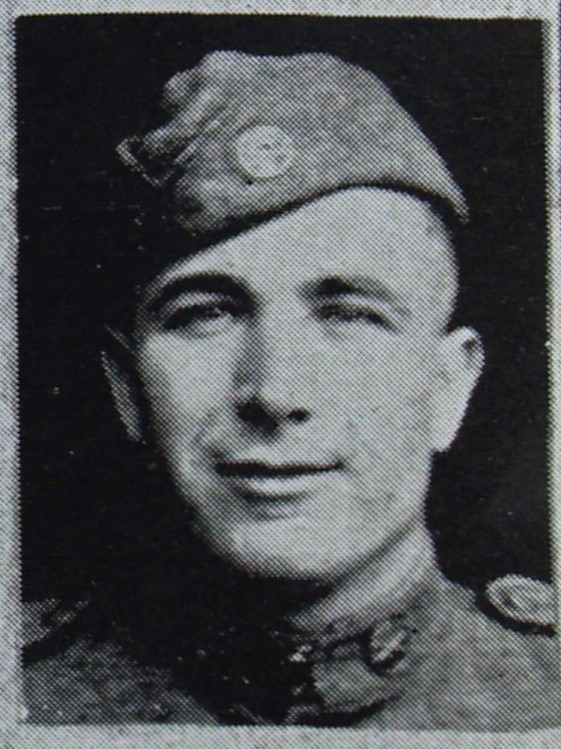
Norman S Bolam
Week 45 Published by Andrew Capets - November 3, 2019
The Lesher Auto Company operated at 501 Duquesne Avenue during the 1920s, selling primarily Studebakers and Franklin Automobiles. James E. Lesher purchased the building in 1919 from Elmer Henderson, who originally built the garage in 1916 to sell Ford, Lincoln, and Dodge brand vehicles and other automobile parts.
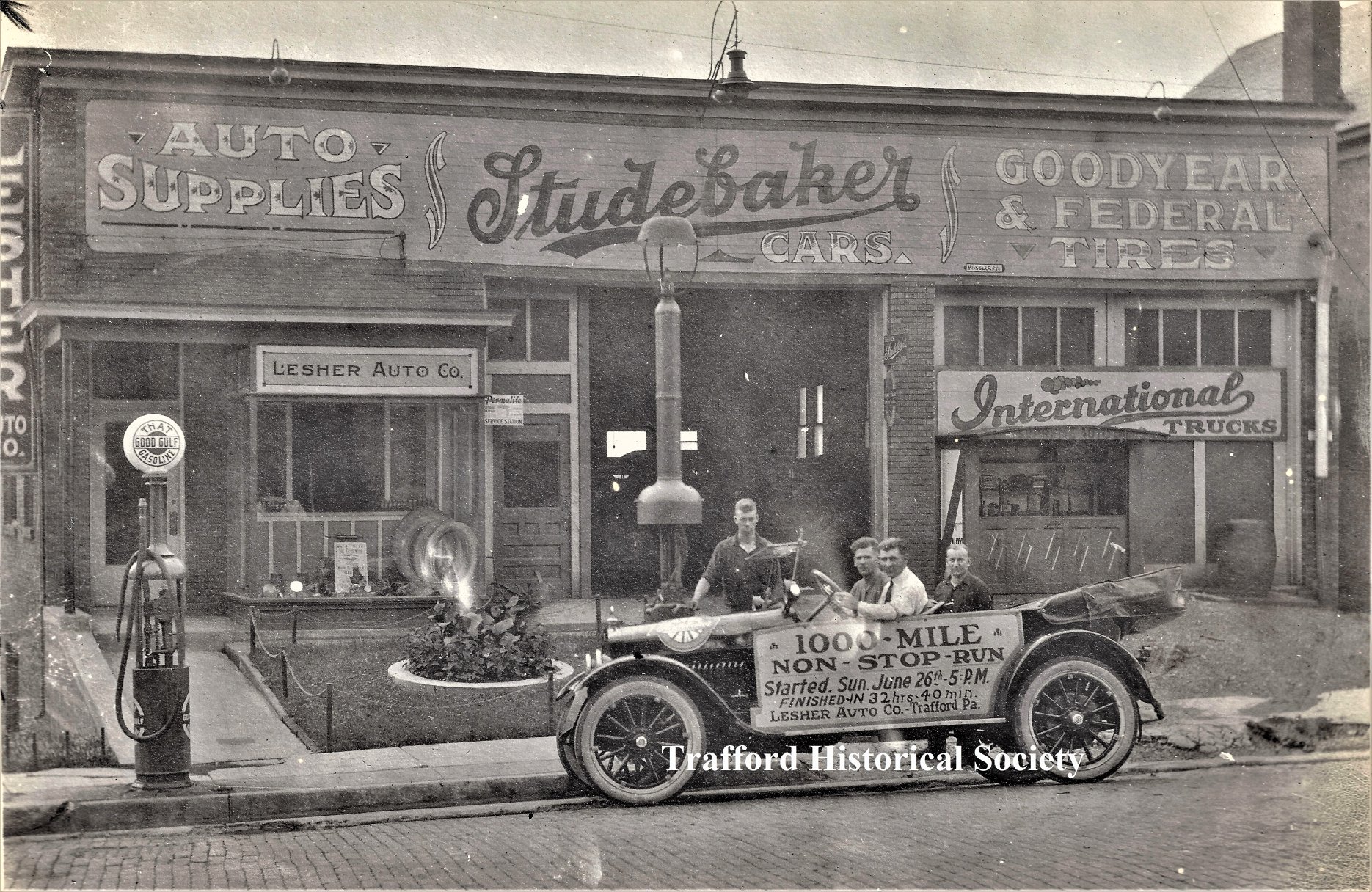
James Lesher teamed up with his younger brother Walter to operate the dealership and auto repair business. During that period, the Studebaker Automobile Company ran a national advertising promotion that involved dealerships participating in a “100,000-mile reliability run” where every dealer took a stock car and was asked to cover at least 250 miles a day for four days. Each dealer reported back to Studebaker the results of their run. The Lesher Auto Company promoted the results of their reliability test by touting a non-stop run of 1000 miles in 32 hours and 40 minutes (circa 1920).
In 1923, the Lesher brothers lost their father Frank to tuberculosis at the age of 60. The following year, James Lesher moved west to Denver, Colorado and opened a new auto dealership in Fort Collins, Colorado. Four years after his move, Walter Lesher, his younger brother running the Trafford business, contracted tuberculosis at the age of 33 and died on August 21, 1928. Less than three months later, James himself would also contract tuberculosis and he died on November 4, at the age of 38.
Both men were married at the time of their death. James had three teenage daughters, but there were no other Lesher family members in a position to take over the family business. Grant Lesher, another sibling, had passed away 15 years earlier from pneumonia at the age of 20, and the eldest brother, Earl Lesher, was already employed and working as the president of a lumber company in Lakewood, Ohio.
In 1929, Ivan Mikan and Walter Brown moved into the building to open a Chevrolet dealership. In 1930, Mikan’s former business partner, Joseph F. Schneider opened the Trafford Motor Company selling Chevrolets, Studebakers, Chryslers, and Plymouths until his death in 1961. Kenneth Schneider took over the business following his father’s death and operated the Trafford Motor Company until 2015. The building has since been razed.
Week 44 Published by Andrew Capets - October 27, 2019
100 years ago, October 28, 1919, the last Trafford veteran returned home from the Great War. George Reitzel Huff, a 21-year-old railroad worker who once lived at the corner of Maple & Bluff Street, was drafted into the Army as a replacement in a medical detachment. When he arrived in France, the American Army was in the throes of the Meuse-Argonne offensive, considered the deadliest campaign in American history, resulting in over 26,000 soldiers being killed and over 120,000 total casualties.
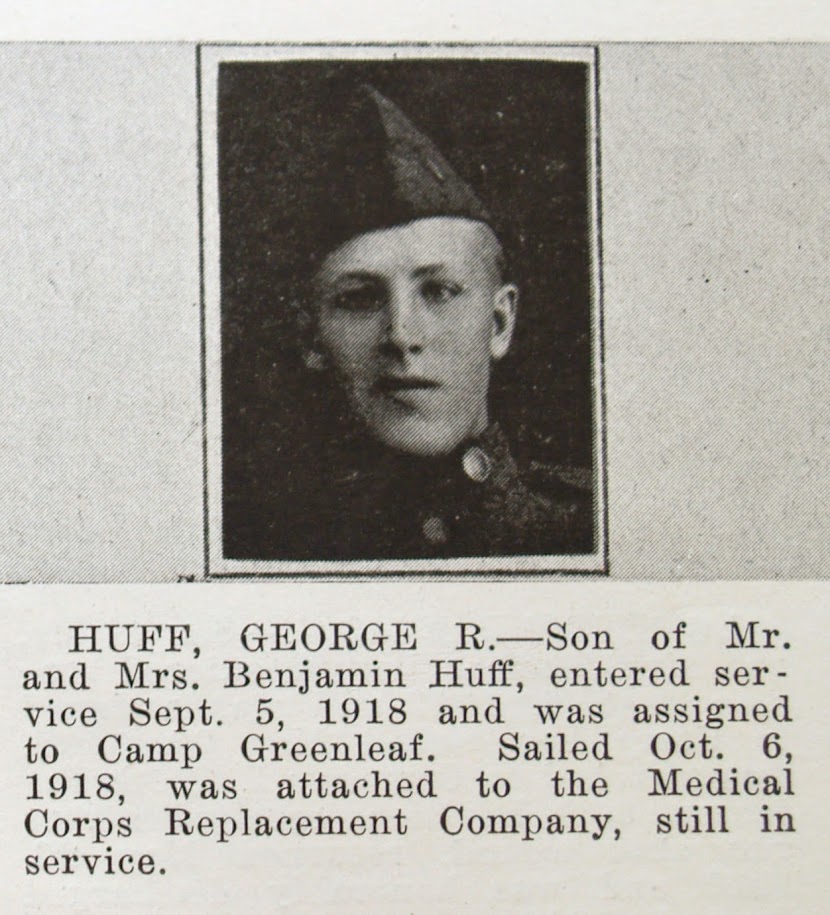 As a member of a medical detachment, Huff would have been witness to the brutality that comes with treating the sick and wounded. The duties of some members of a medical detachment are sobering reminders of what our ancestors endured a century ago; for example, having to account for the men boarding the ship coming home as “legless, armless, or insane violent.” We must not forget the physical and emotional scars that all surviving combat veterans bear when returning home from war.
As a member of a medical detachment, Huff would have been witness to the brutality that comes with treating the sick and wounded. The duties of some members of a medical detachment are sobering reminders of what our ancestors endured a century ago; for example, having to account for the men boarding the ship coming home as “legless, armless, or insane violent.” We must not forget the physical and emotional scars that all surviving combat veterans bear when returning home from war.
After serving his year in France, Huff was aboard USS America when they landed back in the United States on October 28, 1919. Trafford was well into planning a great “Welcome Home Celebration” that took place on Armistice Day. The Irwin Republican Standard headline read, “Bronze Tablet Arrives for Trafford Celebration.” The bronze honor roll was initially placed on display inside the First National Bank, and would later be “unveiled” during the community commemoration. The newspaper reported, “the tablet is a beauty and when placed in its position on a granite boulder in the park at the head of Fifth Street, it will form a monument to the veterans of the recent war of which the people of Trafford can be proud.”
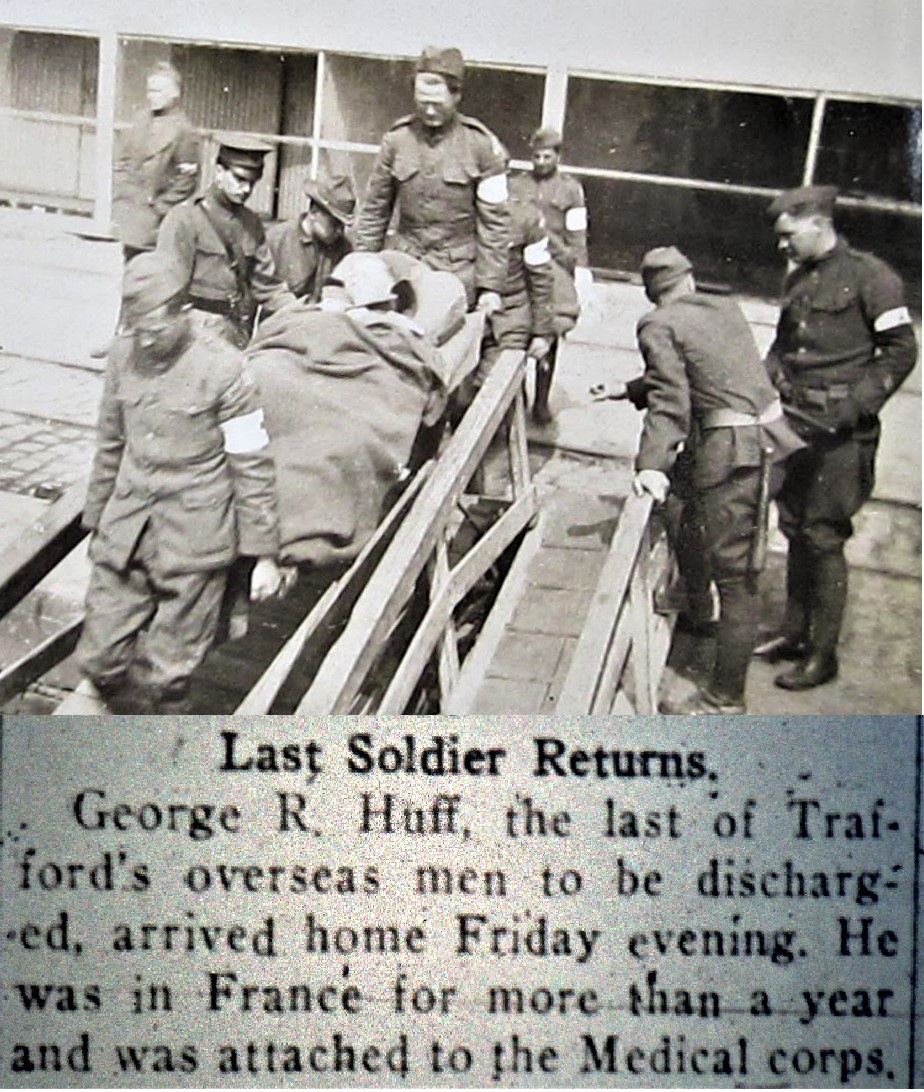
One hundred years later, our community can attest, WE ARE STILL PROUD! The WW1 Memorial in Trafford has been distinguished as an official “WW1 Centennial Memorial” by the World War One Centennial Commission in Washington DC. This coming Veteran’s Day, November 11, 2019, please join the American Legion Post No. 331 for the 100th Anniversary of its dedication and a tribute to ALL VETERANS who have served.
Week 43 Published by Andrew Capets - October 20, 2019
This story has the familiarity of the animated Disney-Pixar movie “Up” where the main character Carl Fredricksen resists selling his home to the big corporation because of the memories it holds. The real-life version involved Trafford ancestor John Cavett McQuaid who held onto the original Cavett Homestead for as long as possible. The true story even made it into the pages of the Los Angeles Times, October 29, 1904 (first appearing in the Pittsburgh Dispatch).
DECLINED TO SELL. Pennsylvania Company Delayed in Improvement for Years by One Man’s Refusal. The Columbia Construction Company for the Pennsylvania Railroad is finishing a small job at Cavittsville, between Stewarts and Larimer, that has gone into history as one man holding up a big improvement for three years and in one way and another costing the big corporation fully $50,000, according to estimates made by those near the inside.
When the railroad company several years ago extended its four-track system west from Irwin, taking out the Ardara Tunnel and eliminating sharp curves [that] were part of the improvement. Much new right of way was needed, and the company's real estate men got busy. Farms had to be cut in two, buildings had to be razed and corners of properties here and there were needed for the line adopted. Big prices were asked and big prices were paid, and there was no serious trouble in securing the desired right of way, except in one solitary case, and here the big company was up against a proposition good and hard.
At the old village of Cavittsville, the survey called for the reduction of a 5-percent curve to one of less than 1-percent. To accomplish this about 200 feet of land was needed, upon which stood an old stone house, with a history of the struggles of the pioneers of Western Pennsylvania. The house was erected about 1790 by John Cavitt, a famous hunter and Indian fighter in his day. Standing on a bluff his home overlooked the country in all directions, and on numerous occasions, it was used as a place of refuge by the whites when the red men were on a raid. Old John Cavitt passed away and his big stone house, a landmark, and his many broad acres passed into the hands of his heirs, who, acre by acre, sold all of the property, except the old homestead and lot upon which it stood.
The last heir and owner was Cavitt McQuaid, aged and crippled, and he was the man the railroad company had to deal with. He lived in one or two rooms in the house that had almost gone into decay as far as the interior was concerned, a somber, lonesome, uninviting habitation. The old gentleman would listen to no proposition to sell his place. Railroad men, county attorneys, and friends had no influence. Money seemed to be no object as $8000 in cash and a new house to be erected elsewhere was a final proposition, but the owner was obdurate. Nor could the old gentleman be induced to move. At one time threats were made, and it is alleged that the contractors were ready to dynamite the old house, but the presence of the crippled owner stayed the proceedings; besides, it was his homestead, and right of eminent domain did not apply here.
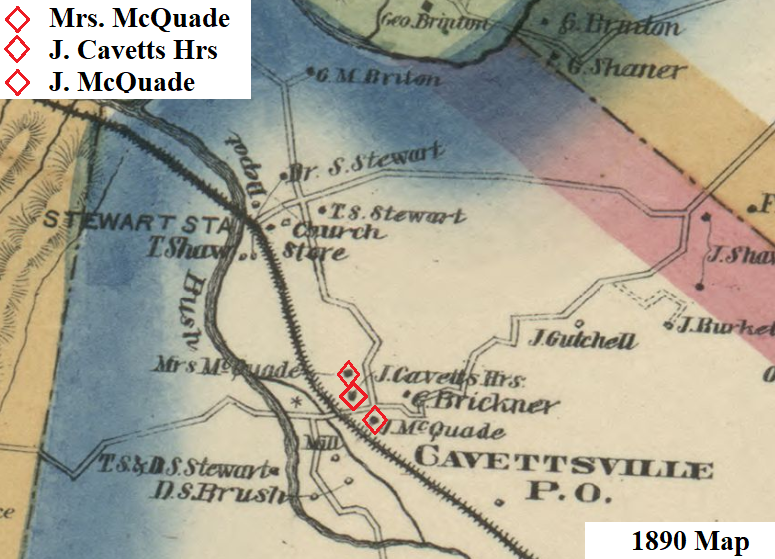
Three of the homes likely taken by the railroad. Jane Cavett married Philip McQuade.
The railroad company was helpless. Its improvement was being delayed several months and its cherished plan of spending over a million dollars to make a practically straight track was going for naught at this particular location. Nothing was left but to order the contractor to proceed. Where a less than 1-percent curve was provided for, a change to 4-percent was made. The job was finished about two years ago. The company's representatives, however, did not give up hope of getting the old Cavitt house and grounds. They kept up negotiations, and four weeks ago they were successful. The amount paid or the terms made were not disclosed, but the money consideration, it is said, would have looked like a national bank to old John Cavitt. Anyway, Cavitt McQuade moved out, and no time was lost in razing the old house. Then the construction company sent its big steam shovel and gang of men to the scene. Two weeks was all that it required to go through the hill, and now the contractor is about ready to move the tracks, and in a few days, they will be commission on the original survey as the company had intended them to be two years ago.
1915 G. M. Hopkins Company Map showing the multiple tracks. Note the bridge over Brush Creek that once connected Wallace Ave with Mahaffey Hill Road. Also note, present-day Route 993 is not built yet. The trolley line appears near Irwin Ave. If you have not seen the animated “Up” movie, this short clip illustrates the similarities in our Trafford story. YouTube Movie Clip
Week 42 Published by Andrew Capets - October 13, 2019
The headline in the Pittsburgh Sun-Telegraph, sixty-six years ago: “Ex-Pitt Star Burns to Death.” The story reported on the tragic death of Dr. Clyde L. Mitchell, a prominent Trafford dentist and one-time Pitt football star who died inside his car on October 13, 1953, at the age of 57 years old. The coroner theorized that Dr. Mitchell possibly suffered a heart ailment before his vehicle caught fire. Mitchell was a 31-year resident of Trafford who operated a private dental practice at the corner of Forest Ave and Sixth Street. Born in Clearfield County, Pennsylvania, he attended Vandergrift High School and earned his D.D.S. from the University of Pittsburgh School of Dentistry in 1919. While a student at Pitt, he registered for the Selective Service Draft in June 1917, and six months later he enlisted in the Army to serve during World War I. While never deployed overseas, Mitchell trained in an Army Medical Detachment and was honorably discharged from service at Governors Island, NY in April 1919.
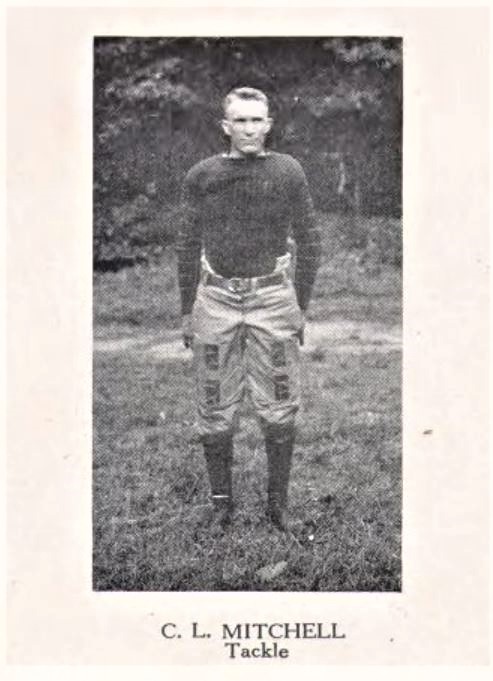
Georgia Tech was coached by John Heisman, the now legendary coach for whom the Heisman Memorial Trophy is awarded each year to the most outstanding collegiate football player. That 1918 contest against Georgia Tech, in which Mitchell played tackle, was the only game during the season that an opponent scored on the Golden Tornados. Pitt successfully defeated Georgia Tech 32-0 at Forbes Field before a crowd of nearly 30,000 spectators, and also ended Tech’s 33-game winning streak. The official NCAA Division I Football records have Michigan and Pittsburgh as co-national champions in 1918.
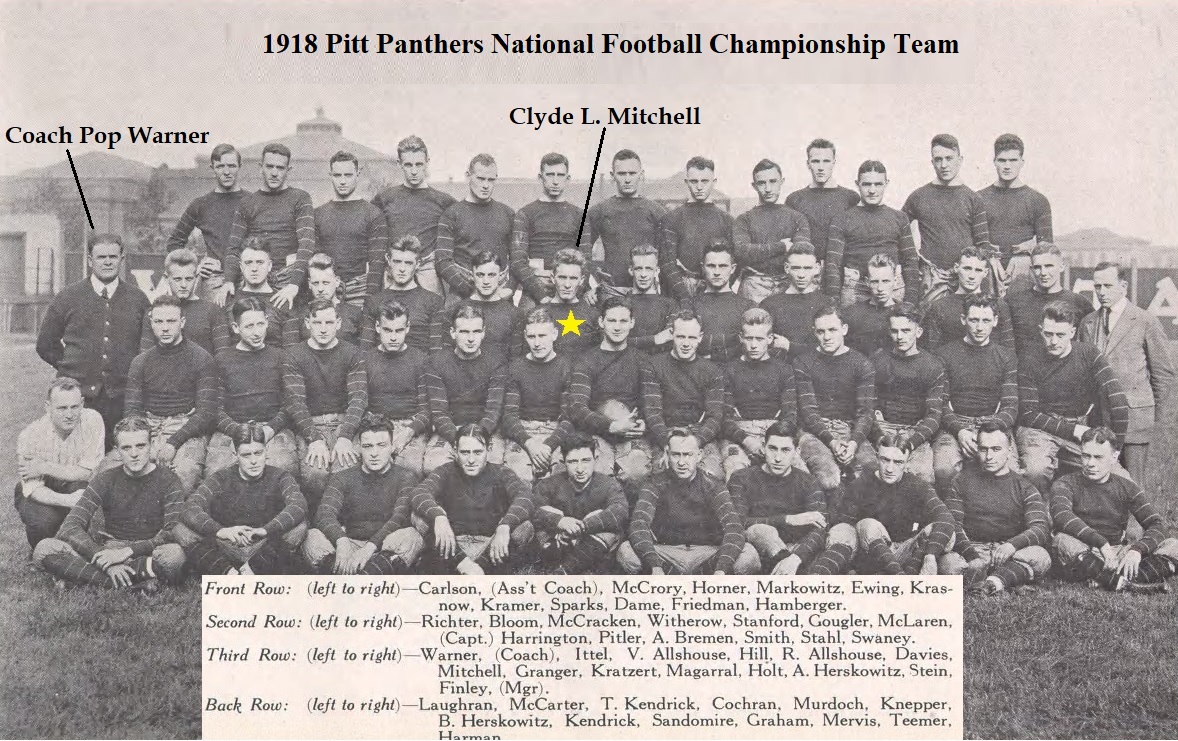
Shortly after college, Mitchell married Helen Cleveland of Wilmerding and the couple had two sons, Clyde and Jack. They moved into their home at 601 Sixth Street in 1923 where Dr. Mitchell opened his dental practice. Ten years later, Helen Mitchell would die at the age of 39. Dr. Mitchell later married Zorah Taylor Detrick, a Trafford widow who had three children of her own, Lois, Ferne, and Frank.
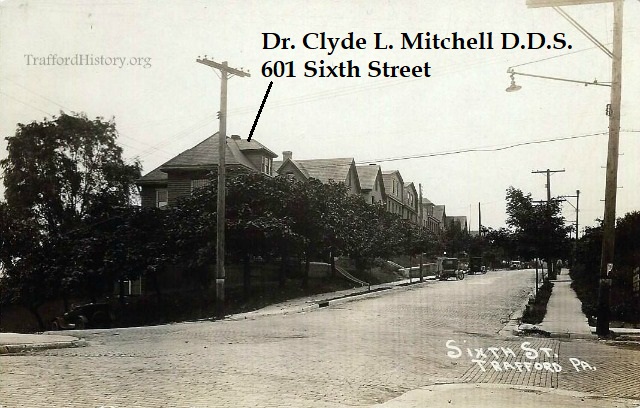
Dr. Mitchell was an active contributor to the Trafford community, serving 18 years on the Trafford School Board and was a past Commander of the Trafford American Legion Post No. 331. He belonged to the Bee Keeper Association of Western PA and raised bees at his farm in Clearfield County where he harvested the wax from the hives to use in his profession. He was also a member of the Forty & Eight Veterans Society, the Braddock Elks, and the Odonatological Society of Western Pennsylvania. His 1919 college yearbook reads, “Exceptionally well liked by all.” This week we remember Clyde Laird Mitchell (1896-1953)
Week 41 Published by Andrew Capets - October 6, 2019
Seventy years ago, this week, on October 8, 1949, a bronze memorial was erected in Marcus Hook, Pennsylvania, to commemorate the lives of those men who died while serving aboard tankers owned by the Sun Oil Company during World War II. This nine-foot bronze statue of a merchant seaman honors 141 men, including John J. Radosh, Trafford High Class of 1940, who lost his life on February 21, 1942. Radosh, a Merchant Marine, was aboard the S.S. J.N. Pew when a torpedo from a German U-boat sunk the vessel about 225 miles west of Aruba. Thirty-three men on the ship lost their lives and only two survived. One survivor managed to reach the coast of Venezuela on a lifeboat, and the other survivor watched ten of his companions die from thirst and exposure as he drifted at sea on a lifeboat for twenty-one days.
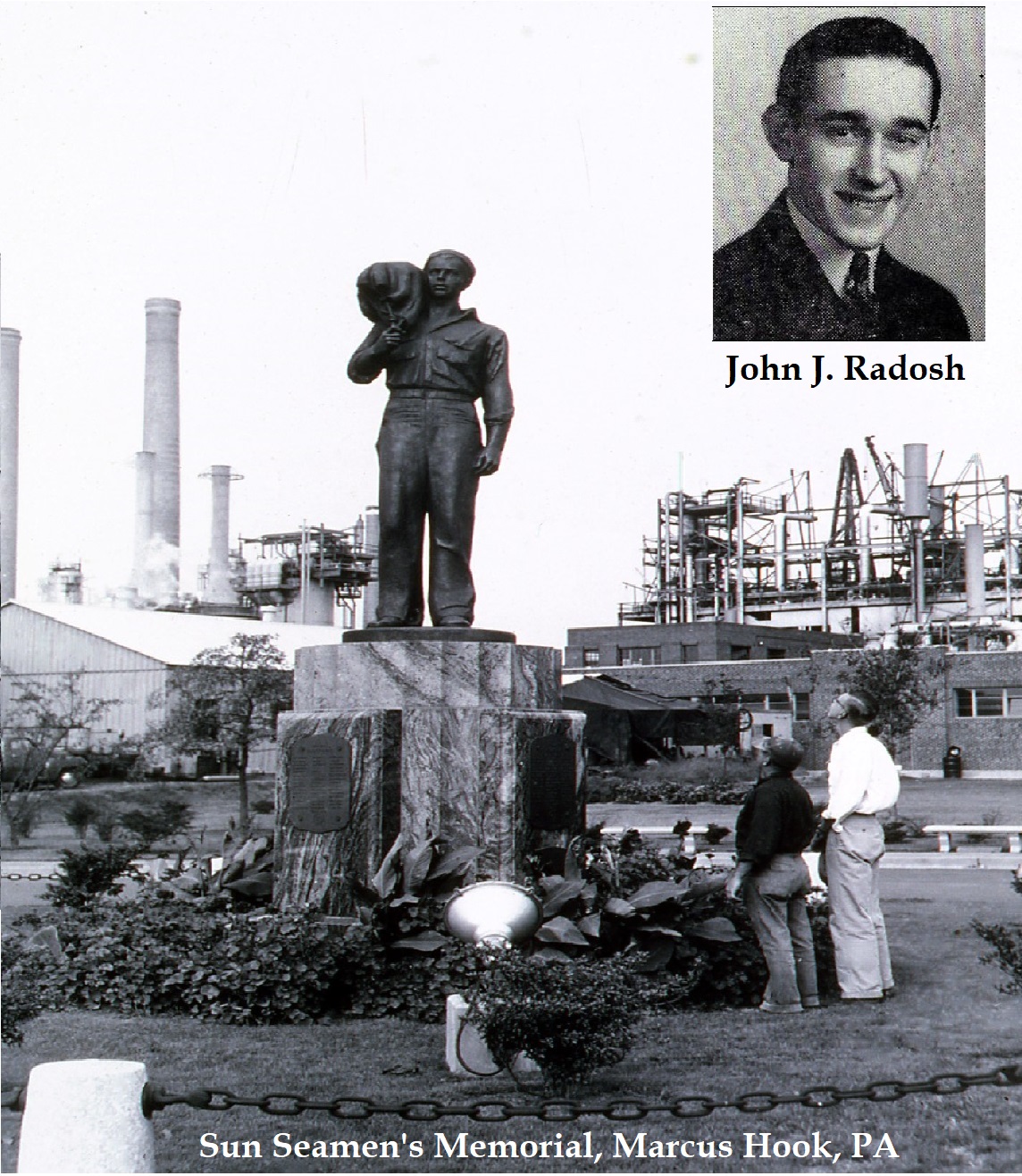
The ship carrying Radosh was named after Joseph N. Pew Sr. who founded Sun Oil in 1890 and established the Sunoco Refinery in Marcus Hook along the Delaware River. Joseph N. Pew Jr, who was born in Pittsburgh in 1886, then Chairman of the Board for Sun Oil, presided over the ceremony 70 years ago. In the year preceding this memorial dedication, Pew and his siblings founded The Pew Charitable Trusts, one of the leading philanthropic foundations known around the world.
In their 1942 student yearbook called the Reflector, the students of Trafford published a list of all those who were serving at the time and they included a Memoria to John Joseph Radosh (1922-1942). The Sun Seamen’s Memorial is located at the corner of Delaware Avenue and Green Street, outside the Sunoco Refinery, Marcus Hook, PA.
Week 40 Published by Andrew Capets - September 29, 2019
One of the darkest times in the early history of Trafford came in 1913 when a young schoolgirl was murdered, and the villain never identified, leaving a shroud of fear over the community for years to come.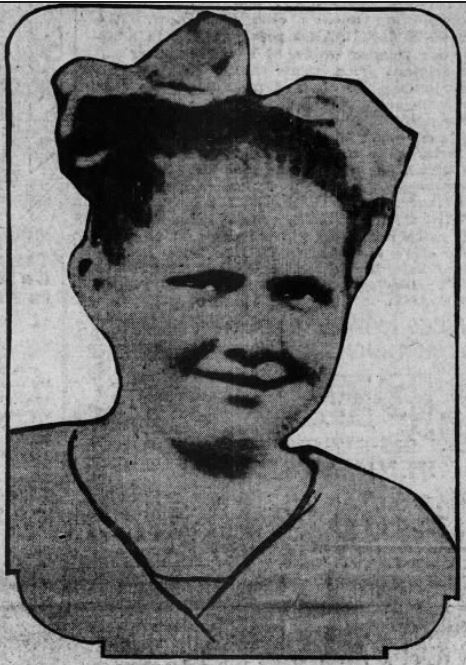
When Grace did not arrive home that evening, her father went looking for her thinking that she had stopped at a friend’s home after practicing for an upcoming school play. As soon as he learned that she never made it to school that day he immediately went to the Trafford municipal building. The fire alarm was sounded for five minutes to alert the community of the need for help. Volunteer fireman and several citizens started their search for the girl at about 8:40 PM. Her body was found by volunteer fireman Max Fulton who located the girl’s body off the road and hidden with branches. She was carried to the Johnston home and Dr. D.O. Todd was called to the residence to examine the girl. He reported that she had been dead for several hours and that she fought to save her life as shown by the condition of her clothes and the cuts and bruises on her face. The Pittsburgh Post-Gazette reported that “Blackburn and Trafford are determined to deal out their own brand of justice if the guilty man is caught.”
The state constable was called to the scene and bloodhounds from Washington PA arrived in Trafford late that evening. The dogs took the investigators north toward Harrison City, but the scent was eventually lost as they approached Jeannette.
Two days after the murder, a 28 year-old-man named Poala Scimla [Paoli Scima] was said to be “despondent” just before he shot himself in the neck with a revolver after talking to others about the Johnston girl case. He died in the Westmoreland Hospital a month later as a result of the self-inflicted wound, but State Troopers showed that the man had nothing to do with the assault because he was previously an “inmate in an insane asylum, near Washington, D.C.” While several other men were questioned by police, and a local farmer arrested and held for an inquest, there was never a conviction for the murder of Grace Johnston, which undoubtedly left the community living in fear, never knowing what evil was still out there. Grace Elizabeth Johnston (1900-1913)
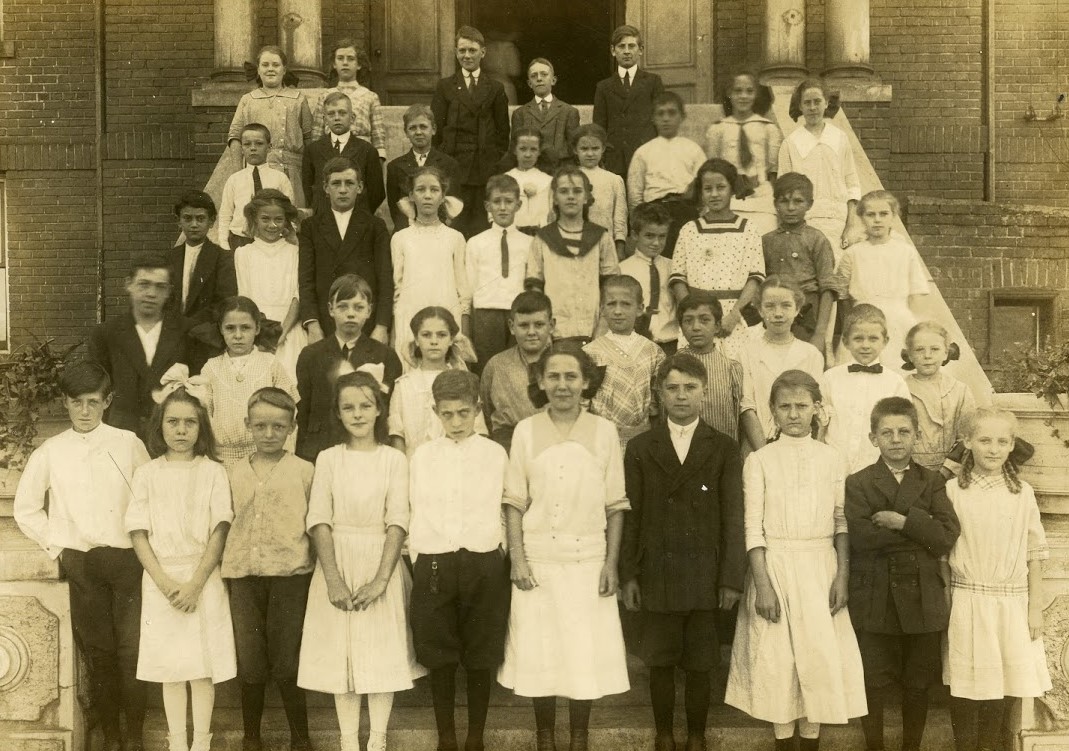
Class photo of students that attended the Edgewood Avenue School for the year 1912-1913. Photo of Grace Elizabeth Johnston (1900-1913) Front page of the Pittsburgh Press, May 20, 1913. Bloodhound caption: “The start of the man hunt. ‘Ike’ Walker, owner of the, Dick and Beauty, is shown holding the beasts in leash at the tree where the girl’s body was found. The other man is a state trooper.” The Pittsburgh Press, May 21, 1913, Page 1.
Week 39 Published by Andrew Capets - September 22, 2019
When pulling into the parking lot of the Trafford Community Public Library, imagine you are pulling up to the homestead (circa 1812) of George Matlack Brinton for whom Brinton Avenue was named. While difficult to visualize the home on this lot, this was the former location of the home based on the writings of a few of Trafford’s first residents and the 1903 G.M. Hopkins Map (see below Block 13, Lots 414-416). George Brinton purchased land from the Cavett (Cavitt) Family to build a home and work the land. In 1850, Brinton wanted to capitalize on the sale of the property when the Pennsylvania Railroad was being constructed. He published an advertisement in the Pittsburgh Gazette on October 12, 1850:
“MILL AND FARM FOR SALE - The mill consists of six run of stones, three by water and three by steam, 4 of burr and 2 of country stone. The mill is in good order and making merchantable work. There is a sawmill attached to the same. The farm consists of 208 acres, about 75 acres of which are cleared, the remainder good wood land. There is on the premises a comfortable dwelling house and barn, with five or six tenant houses, and three good wells of water, with several never-failing springs. There is on the premises some coal land, two excellent stone quarries, and a good orchard bearing fruit. The Pennsylvania Rail Road is now being made through the property, which will make it very convenient for transporting flour east or west.”
Brinton would never see his property sold and developed by the Westinghouse Company as he died in 1895 at what was then known as Stewart Station. He is buried in the Miller United Methodist Church Cemetery, Route 30 North Versailles Township.
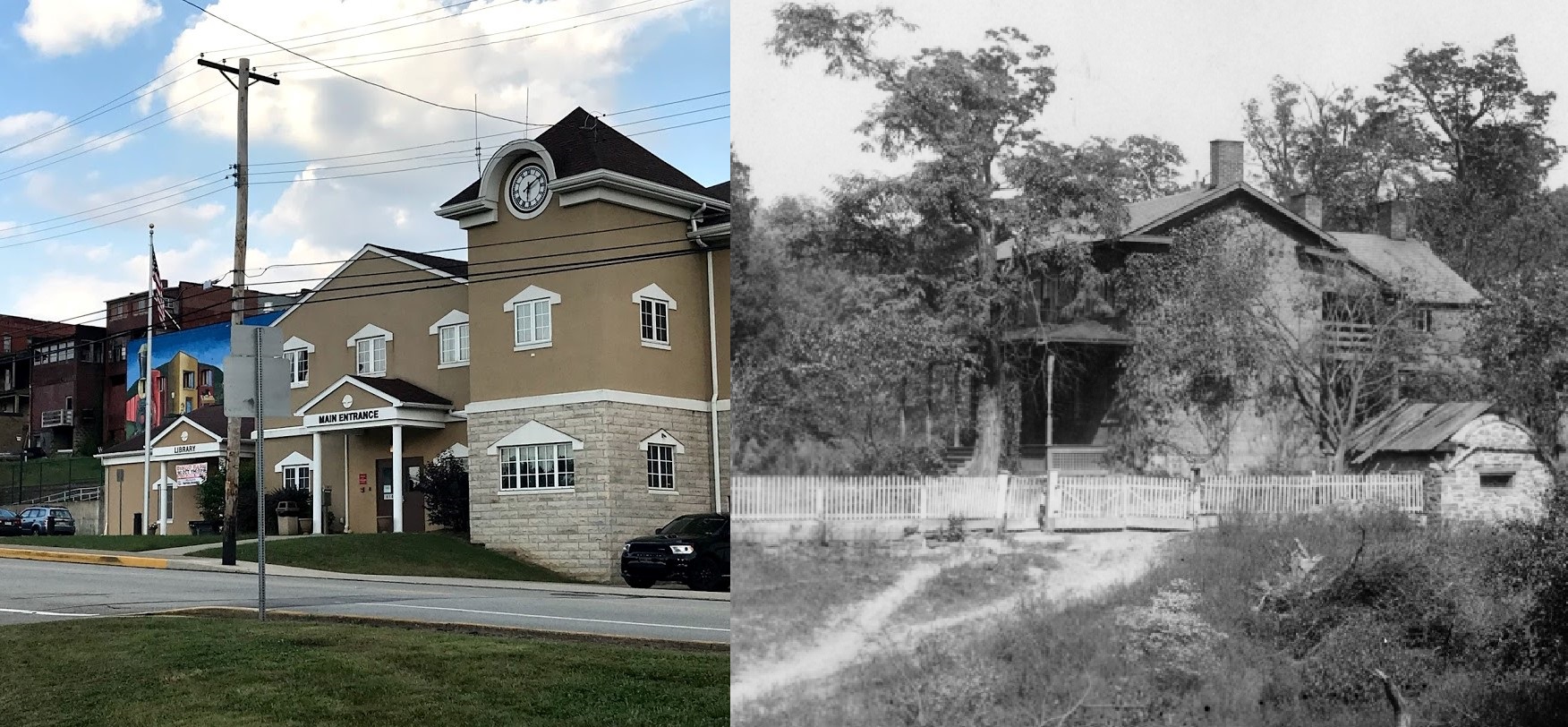
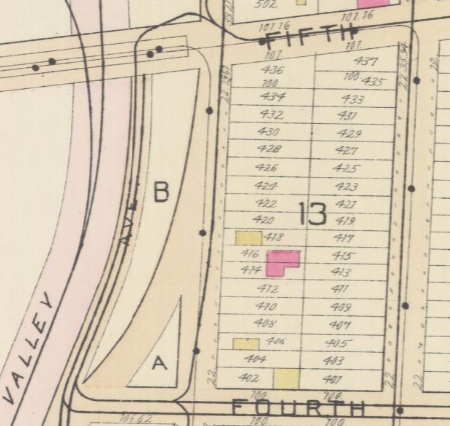
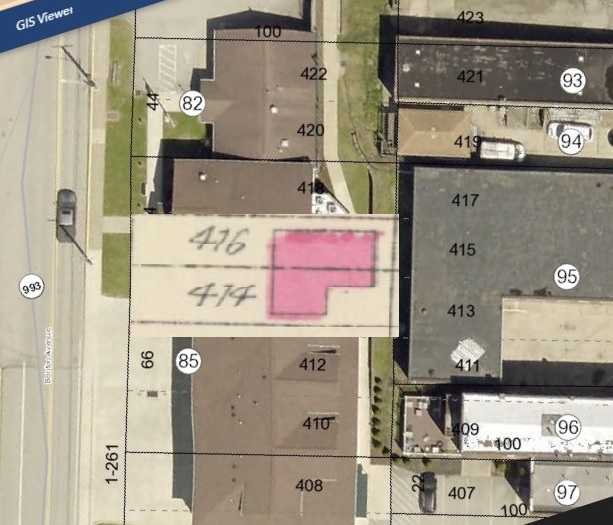
Week 38 Published by Andrew Capets - September 15, 2019
The one photo here was taken about 1901, before the Trafford Bridge was built, and before Westinghouse developed the land once farmed by the Brinton family. The Brinton schoolhouse can be seen in the upper left corner of the photo. The building was erected during the Civil War, and by 1912, the setting for this week’s story, it was said to be “cramped and weather-stained.”
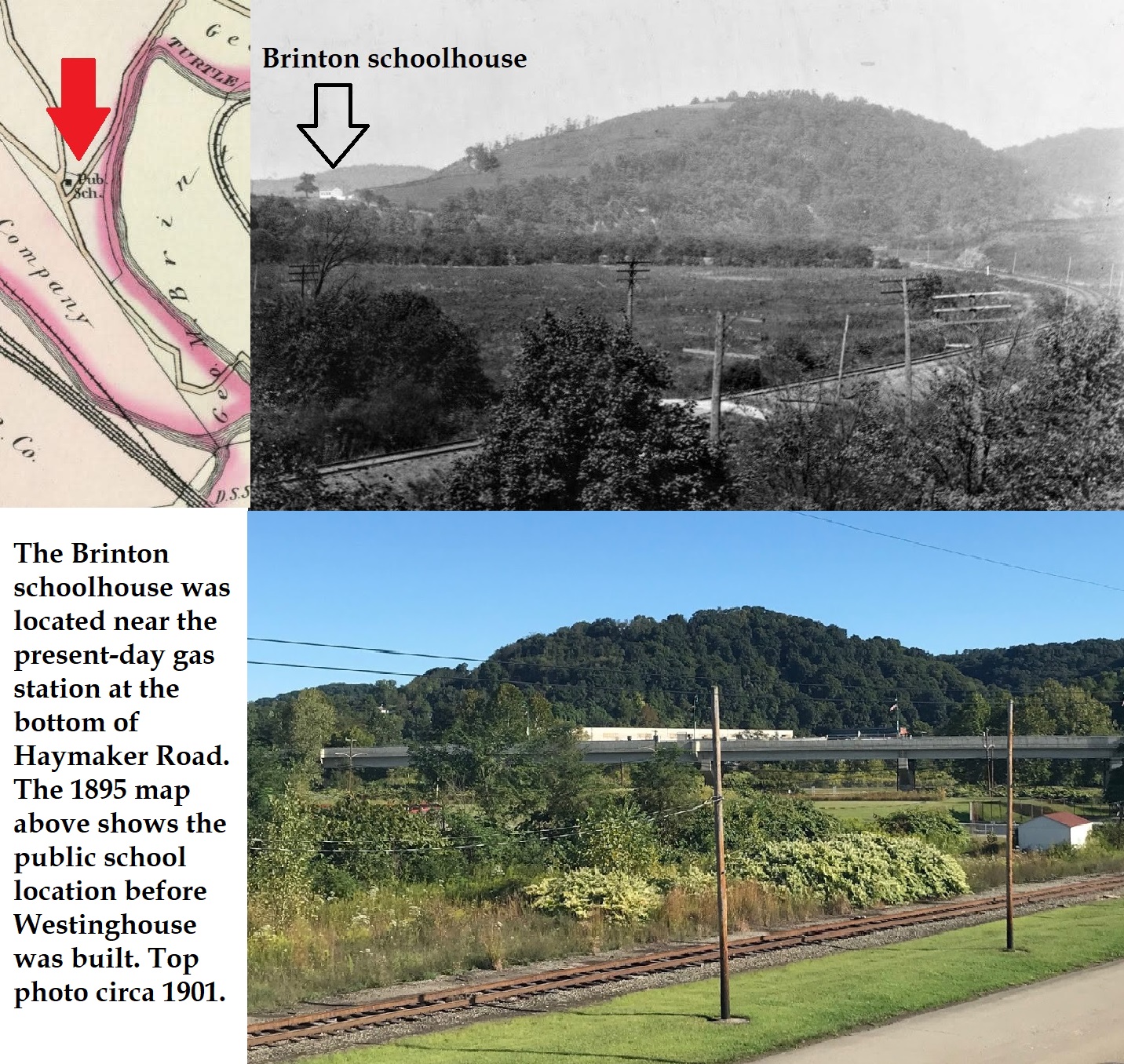
In the autumn of 1912, students and their teachers were antagonized by a bizarre man that showed up at their schoolhouse on three separate occasions. One day in November the man came to the school waving a rifle at Miss Tillie Anderson and her students. The man shouted, "Hold up your hands or I'll shoot your head off." Miss Anderson obeyed as “the children burst into sobs” while the 'maniac' swung his weapon from side to side, yelling, "Shut up your faces or I'll shoot your heads off." A second teacher in the school, Mrs. Della Johns planned for the possibility that the man might return to the school. Just days earlier she brought a .32 caliber pistol to the schoolhouse to keep in her desk. When the stranger began trouble, Mrs. Johns retrieved her pistol and attempted to fire it at the stranger but the “rusty” weapon did not discharge. She purchased a new pistol a few days after this incident.
The commotion attracted the attention of Trafford milkman, Clarence Noll, who happened to be passing the schoolhouse in his milk wagon. Noll, without regard for his own safety, confronted the man with the gun. Although himself threatened by the man and his rifle, Noll was able to chase the stranger away from the school. It was reported that Noll "overtook the fugitive three times, but was driven back by the rifle." Trafford police officer Charles Bolam headed a “posse of 35 Trafford City men who searched the woods and hills about Trafford City all afternoon and evening,” but the man was never located. Clarence Emanuel Noll (1880-1940)
Week 37 Published by Andrew Capets - September 8, 2019
The State of Pennsylvania took on a major road construction project in 1931 to lessen the stretch of travel, by seven miles, between Trafford and Larimer. The project built what we know today as Route 993 (then known as Route 639) by eliminating the old serpentine road and acquiring an abandon rail bed that paralleled the present-day railroad tracks. At the time, 250 residents signed a petition against having this new road enter Trafford. The Westmoreland County Commissioner responded to the petitioners saying, “It is only fitting and proper that a first-class highway should be built into and through the gateway [to the greatest industrial center in the world].” The Trafford Board of Trade had been seeking construction of this road since about 1916. The one photo here (circa 1931) shows the construction of the road at the corner of First Street and Brinton Avenue. Note the farmland in the background before the ‘Terrance’ was built.
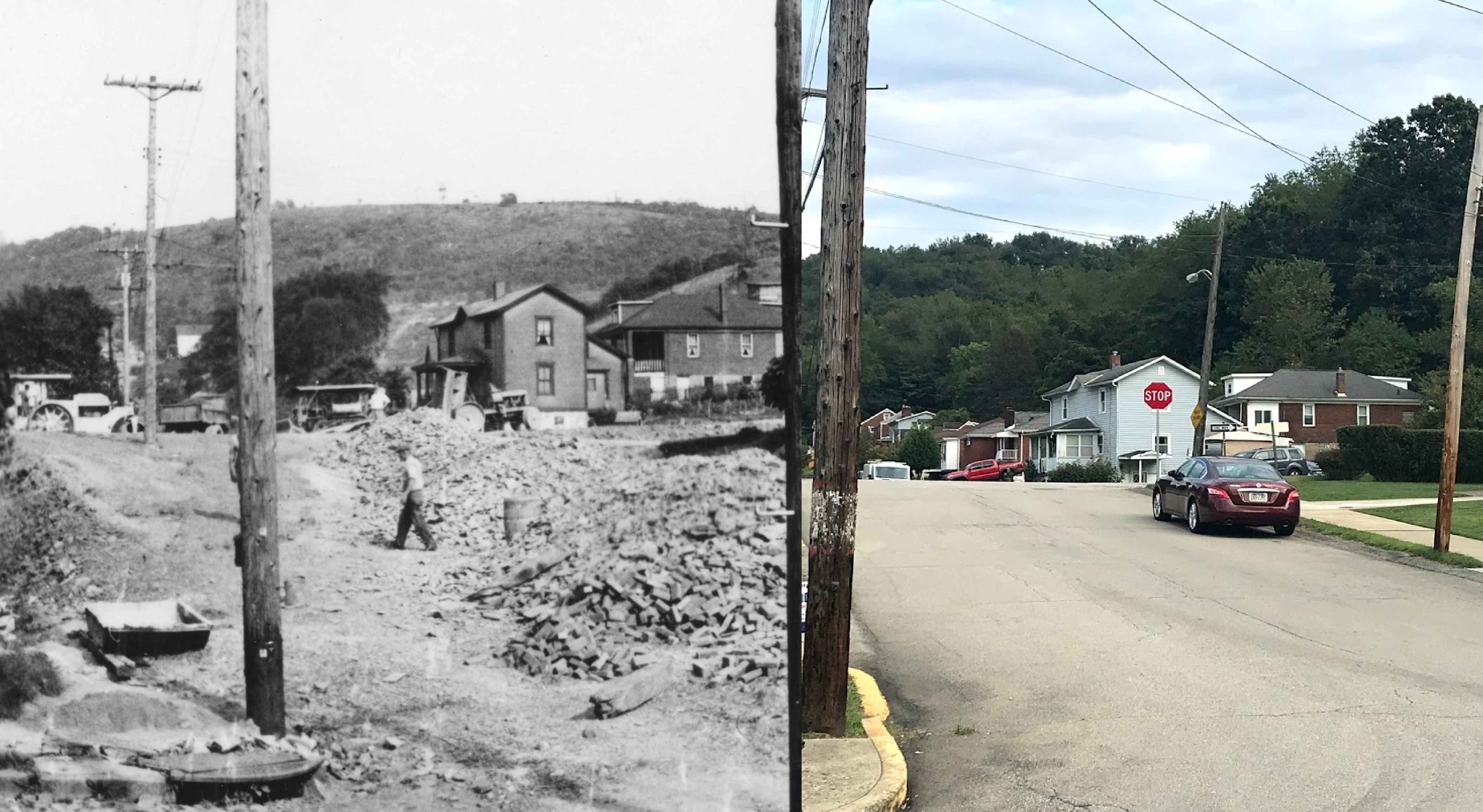
Also, note the one-story brick home shown in the photo (home on the right). It was built by Italian immigrants Giorgio & Guiseppina Valmassoni. They purchased two lots in September 1926 from the East Pittsburgh Improvement Company. The couple already had two young sons at the time, Charles and Virgil, and in 1933 the family welcomed a third son, George Alexander, the first Valmassoni born in Trafford. George graduated from Trafford High in 1951. His firm sense of civic duty was evident in the many positions he held while living in Trafford; lifetime member and former president of the Trafford Fire Company, a former member of the Trafford Borough Council, serving as both president and vice president. He became president of the Trafford All Class reunion in which hundreds of former classmates gathered in the summer of 2001 to celebrate their community and friendship. This photo of George was taken when he was 18 years old; this week marks 18 years since the passing of this humble and well-respected community leader, George A. Valmassoni (1933-2001).
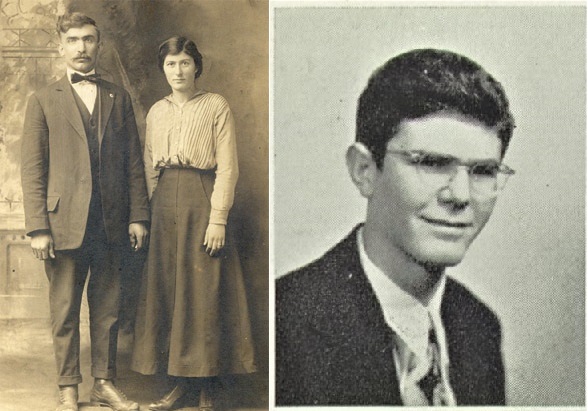
Giorgio "George" Valmassoni (1889–1972) and Guiseppina "Josephine" Marnoni (1899-1978) photo shared by Jim Federlein on Ancestry. George Alexander Valmassoni Jr (1933-2001) photo from the Reflector; Trafford High School 1951.
Week 36 Published by Andrew Capets - September 1, 2019
This 1928 Trafford High School Football team included one of the finest football players to come out of Trafford High, Arnold H.E. Koepka (1915-1993) from the Class of 1932, who later signed with the Philadelphia Eagles for an opportunity to play professional football. Koepka was a freshman on this 1928 Trafford team that only won a single game that season (defeating rival Pitcairn 8-0 in the final game). While the Trafford team struggled for wins during Koepka’s four years on the squad, his skills as a player did not go unnoticed by local sportswriters. A Latrobe paper reported, “Koepka’s passing average should have been higher, for time and again he placed the ball in the receiver’s hands only to have him muff it.”
Koepka was coached by high school teacher Paul Masters, a former college football letterman from Waynesburg College. Coach Masters undoubtedly had a great influence on Koepka’s life. Following high school, Koepka himself attended Waynesburg College to become a teacher. He was the quarterback and team captain for the Waynesburg Yellow Jackets and later returned to Trafford High to teach and coach the Trafford High football team for six seasons.
Koepka was considered a “triple threat” player at Waynesburg (pass, run, kick). In the summer of 1938, Koepka signed on to practice with the Philadelphia Eagles professional football team. While he did not make the final cut for the pros, he did return to Western PA to play on one of the better semi-pro teams in the area called the McKeesport Olympics. Koepka and the Olympics faced Art Rooney’s Pittsburgh Pirates (now called the Steelers) in the fall of 1938. Koepka prevented a shutout game when he threw a touchdown pass for the Olympics in the 21-6 loss against the professional team. The following year, October 4, 1939, the two teams met again and the Pittsburgh professional team had to come from behind to beat the Olympics 9-6. One week later, Koepka faced his hometown team, the Trafford City Alumni, at Cycler Park in McKeesport. The Olympics beat the Alumni 25-0 before a crowd of 2,500 spectators.
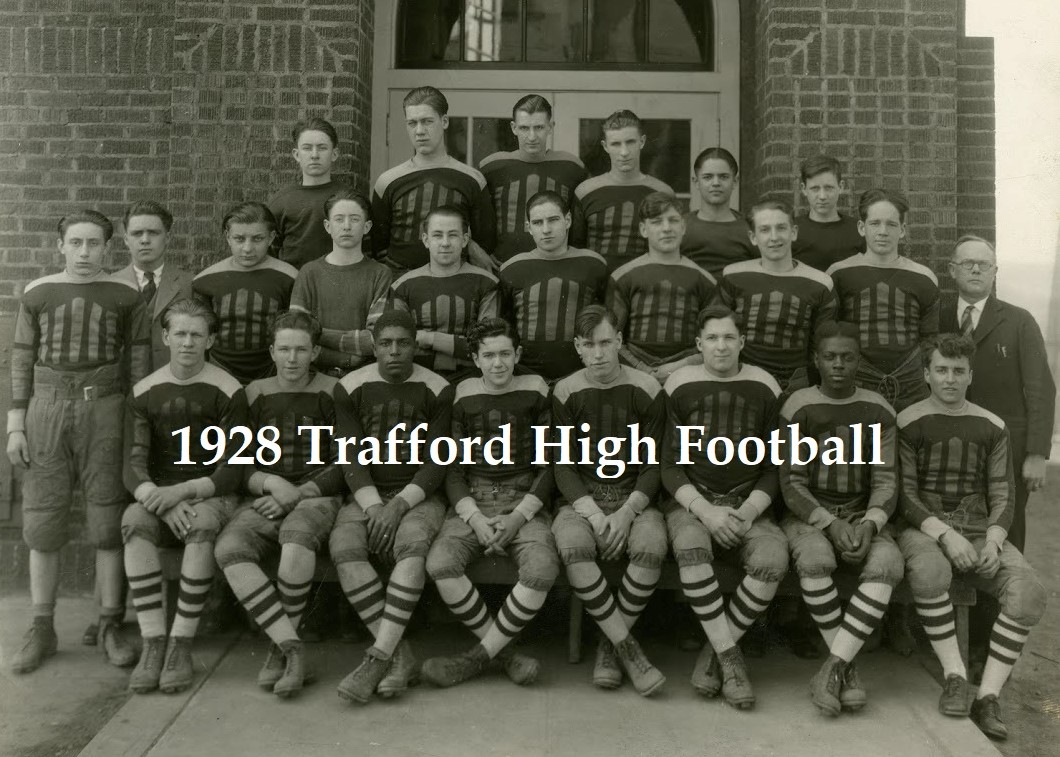
Sitting Front Row (L-R) Theodore Shuda 1930, Edward P. Kelly 1930, William P. Malone 1930, John W. Clark 1931, Frank Yeargers 1929, Robert Bearer 1929, Jenkins H. Jordan 1931, Unidentified#01.
Middle Row (L-R) Robert Ferrari 1932, Coach Paul E. Masters, Aquilaro Colangelo, Thomas V. Gorman 1931, Edgar Nicely 1931, Unidentified#02, Charles Churchfield 1932, George A. Boyer 1929, Arnold Koepka 1932, Principal H.E. Seville.
Back Row (L-R) Jack E. Gorman 1931, Harry E. Corl 1930, Russell L. Richardson 1930, Unidentified#03, Unidentified#04, Sam Simmons 1932.
Week 35 Published by Andrew Capets - August 25, 2019
With the Pittsburgh Steelers having two pre-season games this week (Aug 25 and Aug 29), this is an opportunity to remind readers that the TRAFFORD CITY ALUMNI football team was the FIRST TEAM to EVER play against the PITTSBURGH STEELERS. It was a pre-season game under their new moniker “Steelers” that occurred on August 28, 1940. The link to the full story (and video) can be found here.
This week we are highlighting one of the Trafford City Alumni players that competed in that “historic game” against the Pittsburgh Steelers, 79 years ago this week. John Charles Lawrence (1919-1972), born and raised in Trafford, stood out among his peers as an exceptional athlete during his young adult life, propelling him into several sporting events that gave him the opportunity to contribute to a few different championship teams. Lawrence earned the quarterback position during his senior year at Trafford High – Class of 1937. Following high school, Lawrence joined the Trafford City Alumni sandlot football team that went undefeated in 1938.
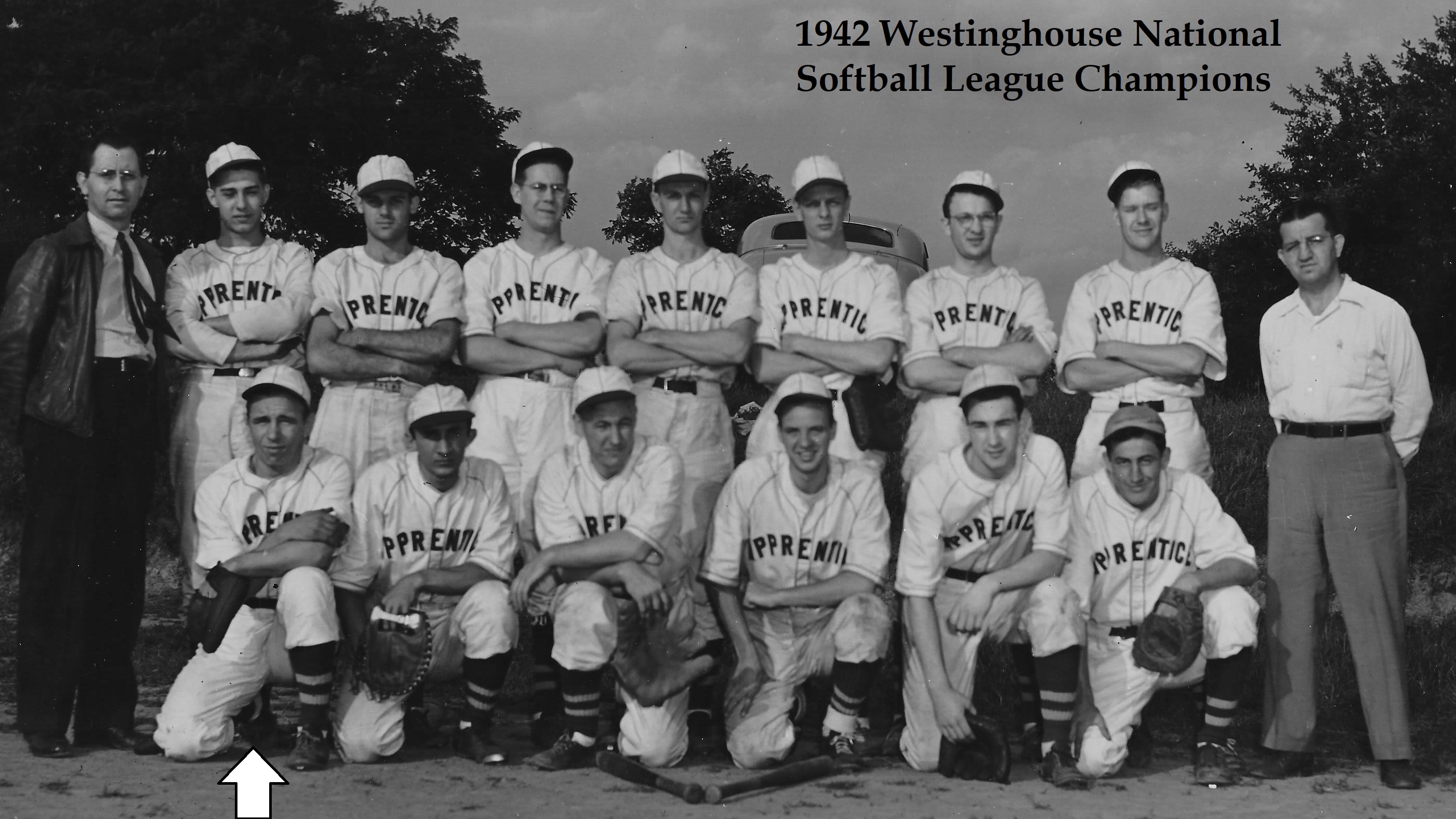
Lawrence went to work for the Westinghouse Electric and Manufacturing Co. in East Pittsburgh and found the opportunity to play for the company softball team called the “Apprentices.” In September 1942, his team won the National Westinghouse Softball tournament, earning not only the traveling “L.E. Schumacher Trophy,” but also giving the team an all-expenses-paid trip to New York to watch the first two games of the 1942 World Series between the New York Yankees and the St. Louis Cardinals.
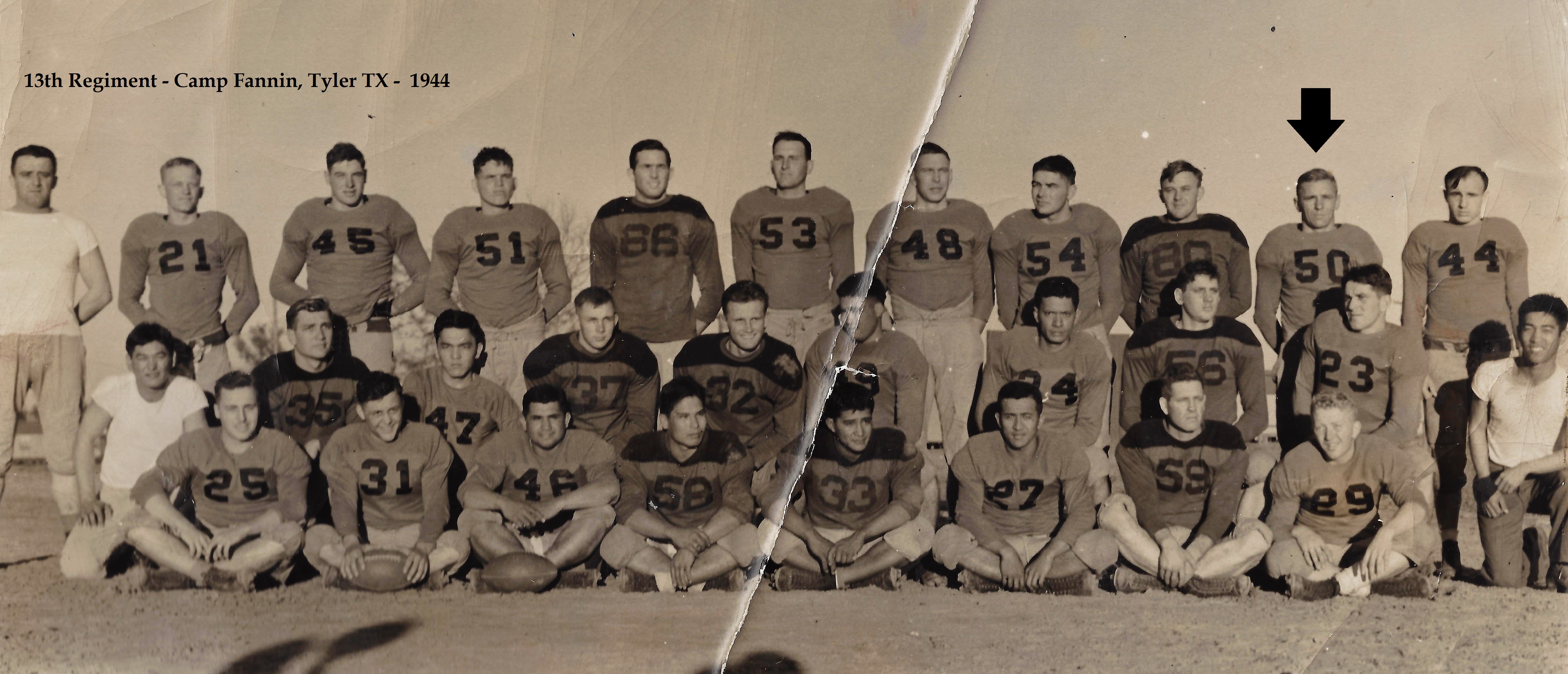
Two years later, in September 1944, Lawrence was drafted into the Army during the Second World War. He was sent to Camp Fannin in Tyler, Texas to receive training at the U.S. Army Infantry Replacement Training Center. The camp organized several forms of recreation to boost soldier morale, and Lawrence joined one of the camp football teams. Lawrence was “drafted” onto the 13th Regiment team headed by Captain Edwin Waszak, a former player from the University of Florida. Not surprisingly, newspaper clippings from the time revealed Lawrence as a key contributor to his team winning the camp football championship in the fall of 1944. Four months later, Lawrence was sent overseas with the US Army and was fortunate to return back to the United States in August 1945. He was honorably discharged from the Army in April 1946.
Week 34 Published by Andrew Capets - August 19, 2019
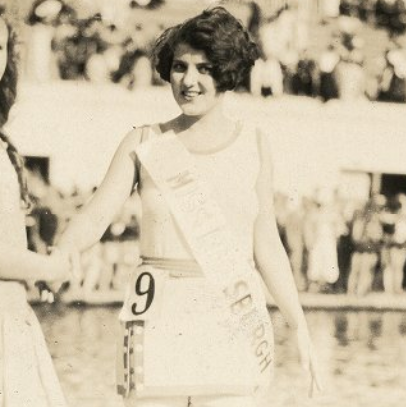 Thelma M. Williams of Trafford was crowned “Miss Pittsburgh 1926,” giving her the opportunity to compete in the Miss America Pageant held in Atlantic City, New Jersey. The Pittsburgh contest was organized by the “Greater Movie Season” which also gave Thelma the prospect for a “screen test” before associates of Universal Pictures in Washington DC, as well as “movie and stage tests” in New York City. However, the August 1926 crowning of “Miss Pittsburgh” did not come without controversy, and the heightened amount of attention given to this 19-year-old former schoolteacher led to details about her private life that appeared in newspapers for many years, revealing a dramatic set of events and a tragic end to her life.
Thelma M. Williams of Trafford was crowned “Miss Pittsburgh 1926,” giving her the opportunity to compete in the Miss America Pageant held in Atlantic City, New Jersey. The Pittsburgh contest was organized by the “Greater Movie Season” which also gave Thelma the prospect for a “screen test” before associates of Universal Pictures in Washington DC, as well as “movie and stage tests” in New York City. However, the August 1926 crowning of “Miss Pittsburgh” did not come without controversy, and the heightened amount of attention given to this 19-year-old former schoolteacher led to details about her private life that appeared in newspapers for many years, revealing a dramatic set of events and a tragic end to her life.
Just days after being crown “Miss Pittsburgh 1926,” other title aspirants who lost the contest took steps through a Pittsburgh attorney to protest her eligibility. They did not necessarily act to have Williams barred from the contest, as much as they were protesting the “laxity of rules that allowed entrants from districts distant from that which the contest was held.”
Thelma told a Pittsburgh Post-Gazette reporter, “While it is true that I was born and raised at Port Matilda, Centre County, nevertheless I have been making my home with my sister in Trafford on and off for the last three years. Further, I applied for a position as a Pittsburgh schoolteacher in April 1925. So, you see, I really must consider Trafford as my residence and preference for a home, since living there so much.” Ultimately, the pageant officials stood behind their decision to allow Thelma to compete in the sixth Miss America pageant held at the Million Dollar Pier in Atlantic City on September 10, 1926.
Read the full article here: Miss Pittsburgh 1926
Week 33 Published by Andrew Capets - August 11, 2019
Built in 1902, the Euwer Building (301 Brinton Avenue) was one of the first commercial buildings to be constructed in Trafford. Mathew N. Euwer, a 36-year-old furniture dealer, was working in his father’s Wilkinsburg furniture store when he recognized the opportunity afforded with the much-publicized new town of “Trafford City” being planned by George Westinghouse. Euwer set out to open a furniture and floor coverings business to meet the needs of its future residents.
Originally built as a three-story structure, the third floor, with its unfinished walls, was offered as available space by Euwer to the religious communities of Trafford looking to provide services for their worshipers. A Lutheran congregation used the hall first when they moved a small organ onto the third floor for their Sunday services. On Christmas morning, 1904, the first Catholic Mass ever given in Trafford was said here by Rev. M. A. McGarey before a congregation of about 60 people. In time, Euwer could no longer offer the space to the churchgoers and the third floor functioned as he originally intended, a storage room for his furniture business. Mathew Euwer was an active civic member in the community and lived in Trafford until his passing in 1960 at the age of 92.
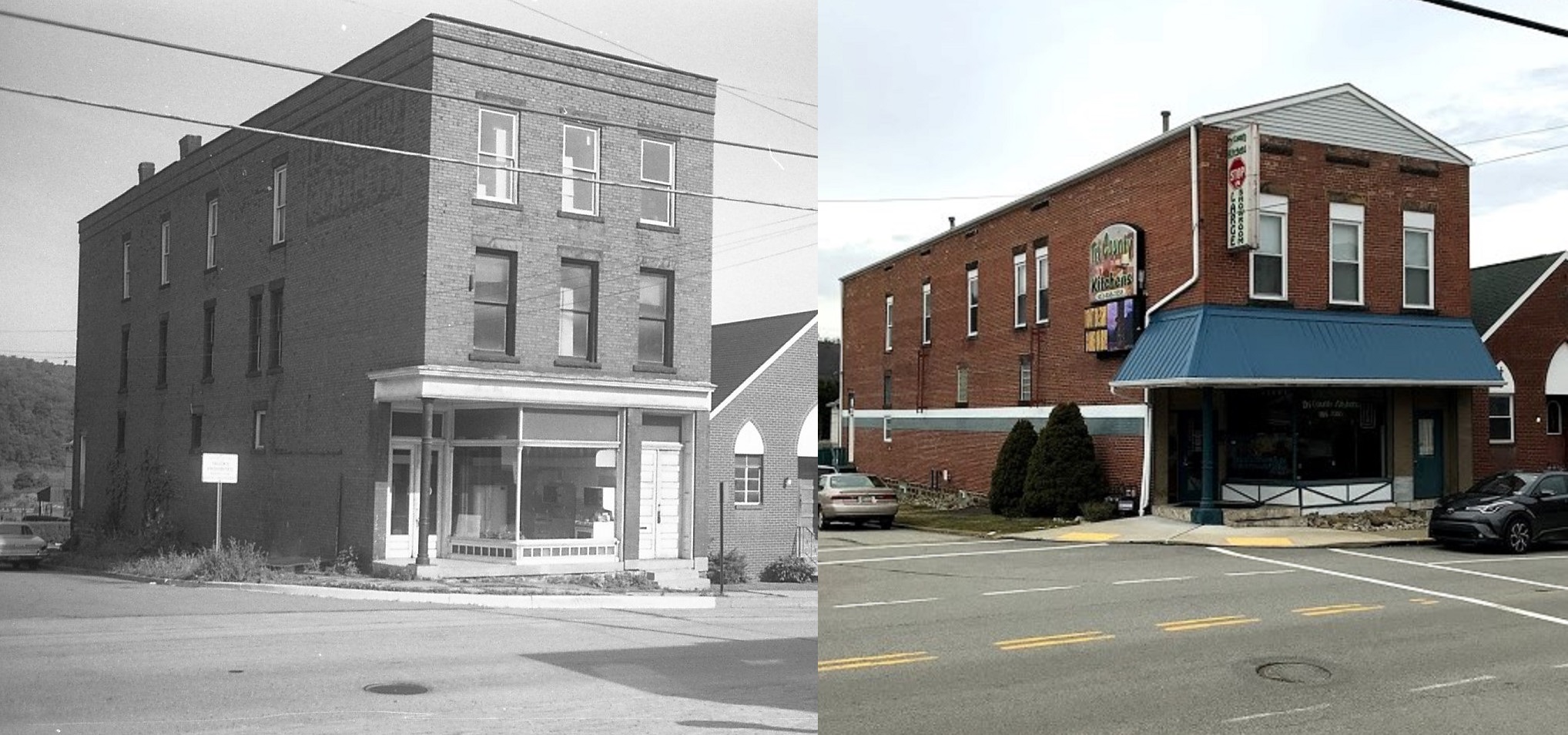
Week 32 Published by Andrew Capets - August 5, 2019
Blackburn Hill: Then and Now. In 1910, William G. Goughenour was 28 years old, unmarried and living in a boarding house in Braddock. He worked as a crane operator in one of the former Carnegie Steel plants. Six years later he would marry Maude Bolam, the daughter of Charles Bolam, one of Trafford’s first uniformed police officers. The couple rented a home in Trafford while William worked his way up to becoming a machinist, and later a clerk in the steel plant. In February 1920, the couple purchased their first home at 510 Edgewood Ave, just a few houses down from her parent’s who lived at 502 Edgewood Ave.
Perhaps needing a little elbow room, William purchased land from the Blackburn Family in August 1921 to build their home shown in this photo along the brick road built from Trafford to Harrison City (present-day Route 130). The couple had three children, two boys and a girl (quite possibly one of the children seen in this photo based on the age of this photo). The children are leaning against a concrete culvert that would have been built to direct the flow of a small stream under the brick road (the same stream that currently flows under the center strip of present-day Belleau Woods Blvd).
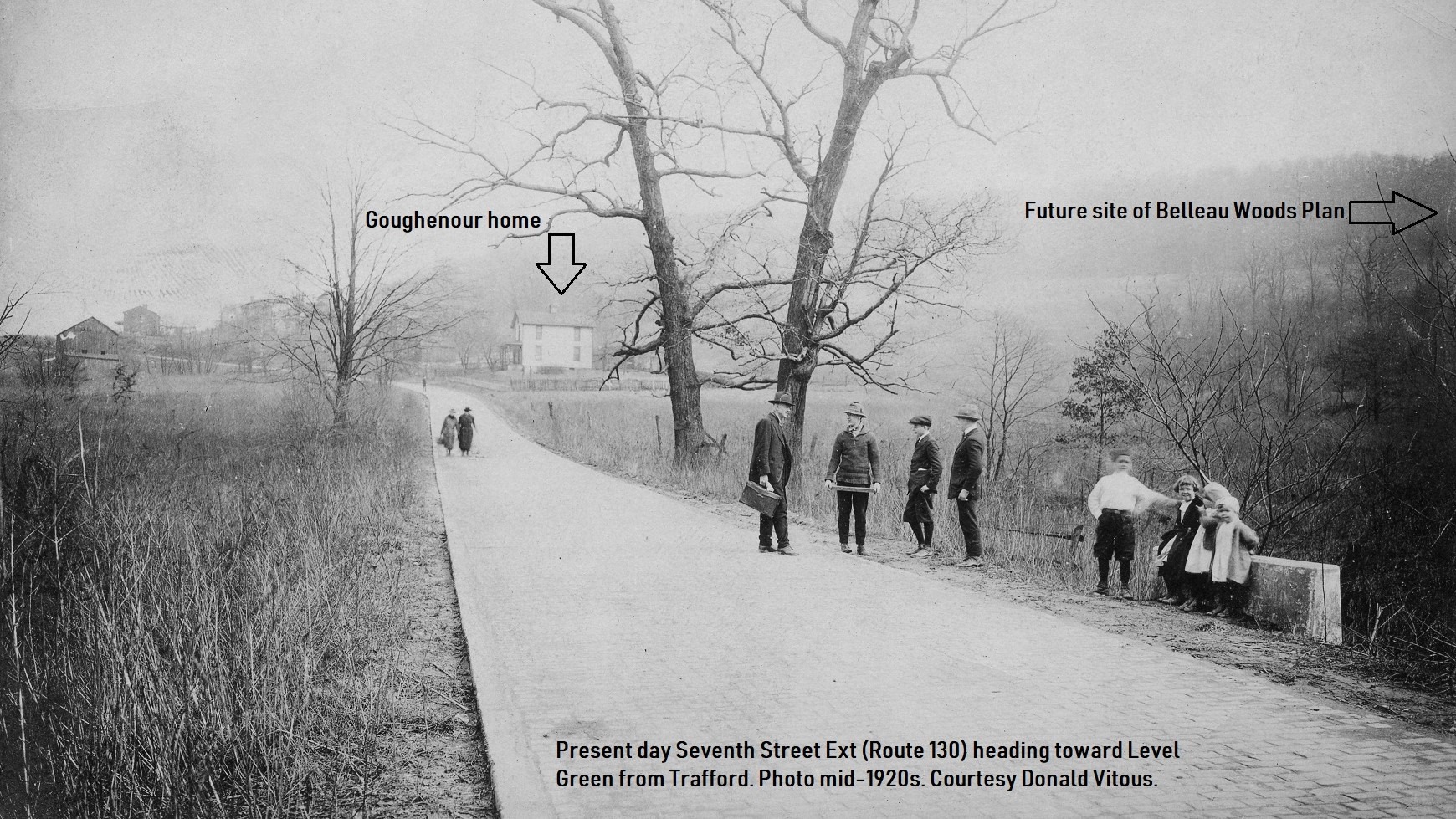
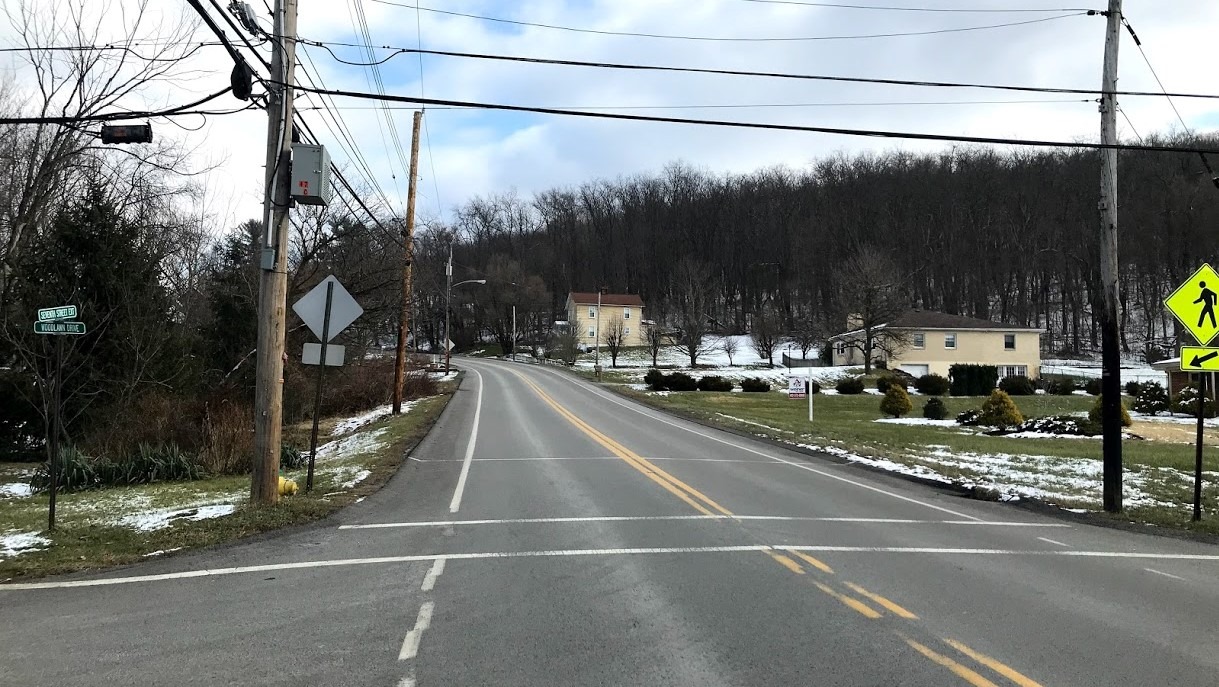
Week 31 Published by Andrew Capets - July 29, 2019
After graduating from Trafford’s eighth-grade class in 1912, Emmett H. Beswick was 15 years old when he started working for the Westinghouse Electric & Manufacturing Company. By 1925, he was working as a toolmaker, married to Hazel Simmons, and the couple purchased their first home at 220 Edgewood Ave. Their daughter Norma was born a year later. They moved two more times on Edgewood Ave, but in late 1928, the couple sold their home and began renting. In 1930, they were living on Third Street while Emmett was a shop foreman for the company. By 1935, the family moved east to Tinicum Township and were living in “Westinghouse Village,” a planned company housing community in the suburbs of Philadelphia. Emmett continued to work for Westinghouse, and in 1943 he was credited with an invention for an apparatus he helped to design. Sadly, on June 10, 1945, Emmett Beswick would end his own life at 48 years old. His body was returned to Western PA and interred in Grandview Cemetery, North Versailles.
We could never make assumptions for the reasons surrounding this fatal act. The issue of suicide will often surface while researching the history of our ancestors. The subject can be taboo for some, especially if living family members were told a different story, or the facts surrounding the deceased were never to be discussed. As historians and researchers, we are challenged to maintain respect for the living family, while also making known the struggles that many families face in their own history. A singular episode cannot overshadow all the other events in that individual's life. Writing about the people who made up the fabric of our community ensures that their memory is not forgotten.
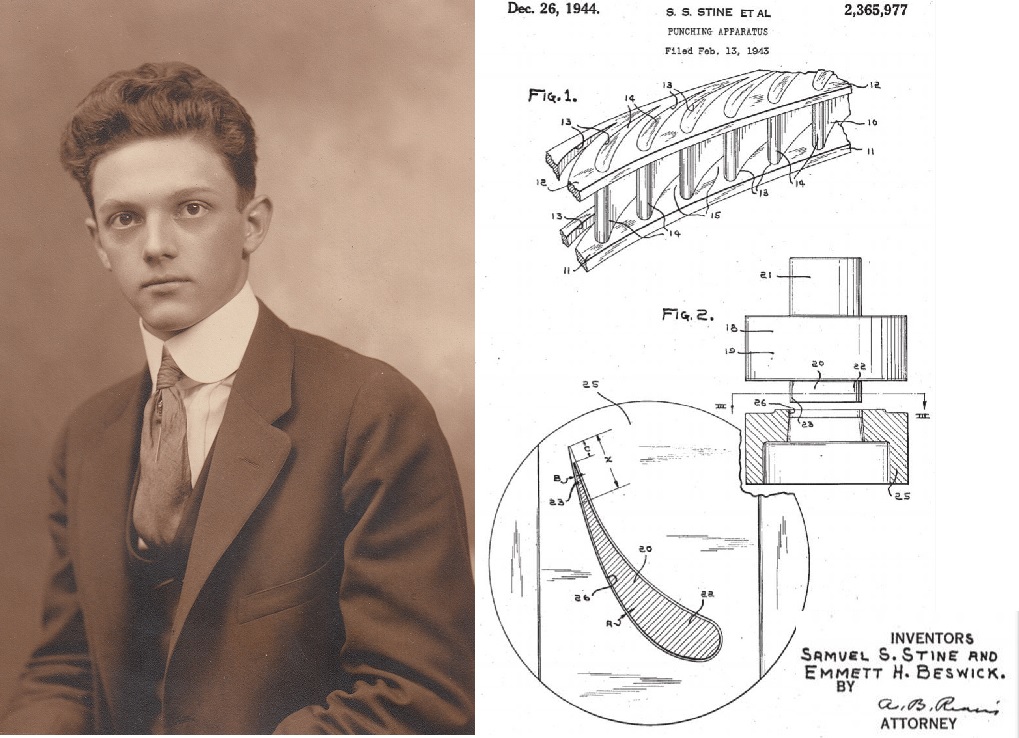
Week 30 Published by Andrew Capets - July 22, 2019
“Cherry Coke, please!” That seemed to be the consensus from last week’s post about Weyandt’s Pharmacy. But to clarify, Weyandt’s actually had three key locations in Trafford, as well as three principal pharmacists over the years. Samuel L. Weyandt started the business and would later employ Victor C. Dettis as an assistant pharmacist. Victor Dettis was a 1919 graduate of the University of Pittsburgh’s School of Pharmacy. In 1925, Weyandt Drug Company moved to 437 Cavitt Ave. Victor Dettis, and wife Mary, evidently had great respect for his boss Samuel L. Weyandt. In 1928, the couple named their first son Weyandt Henry Dettis (the middle name Henry was Mary’s maiden name).
In 1939, the drug store and soda fountain were moved to 435 Cavitt Avenue. Samuel L. Weyandt would live with the Dettis family up until his death in 1941. Weyandt H. Dettis (Trafford High Class of 1945) followed in his father’s footsteps and graduated from the Pitt School of Pharmacy in 1951. Following graduation, the young Dettis went to work for the Parke Davis Drug Company but returned to Trafford in 1953 when his father died prematurely at the age of 55. Weyandt H. Dettis continued to serve up Cherry Cokes in Trafford until 1974 when the business finally closed after more than 70 years in Trafford. Weyandt Dettis moved to Ohio, worked in the pharmacy business until 2012, and passed away in 2016 at the age of 88.
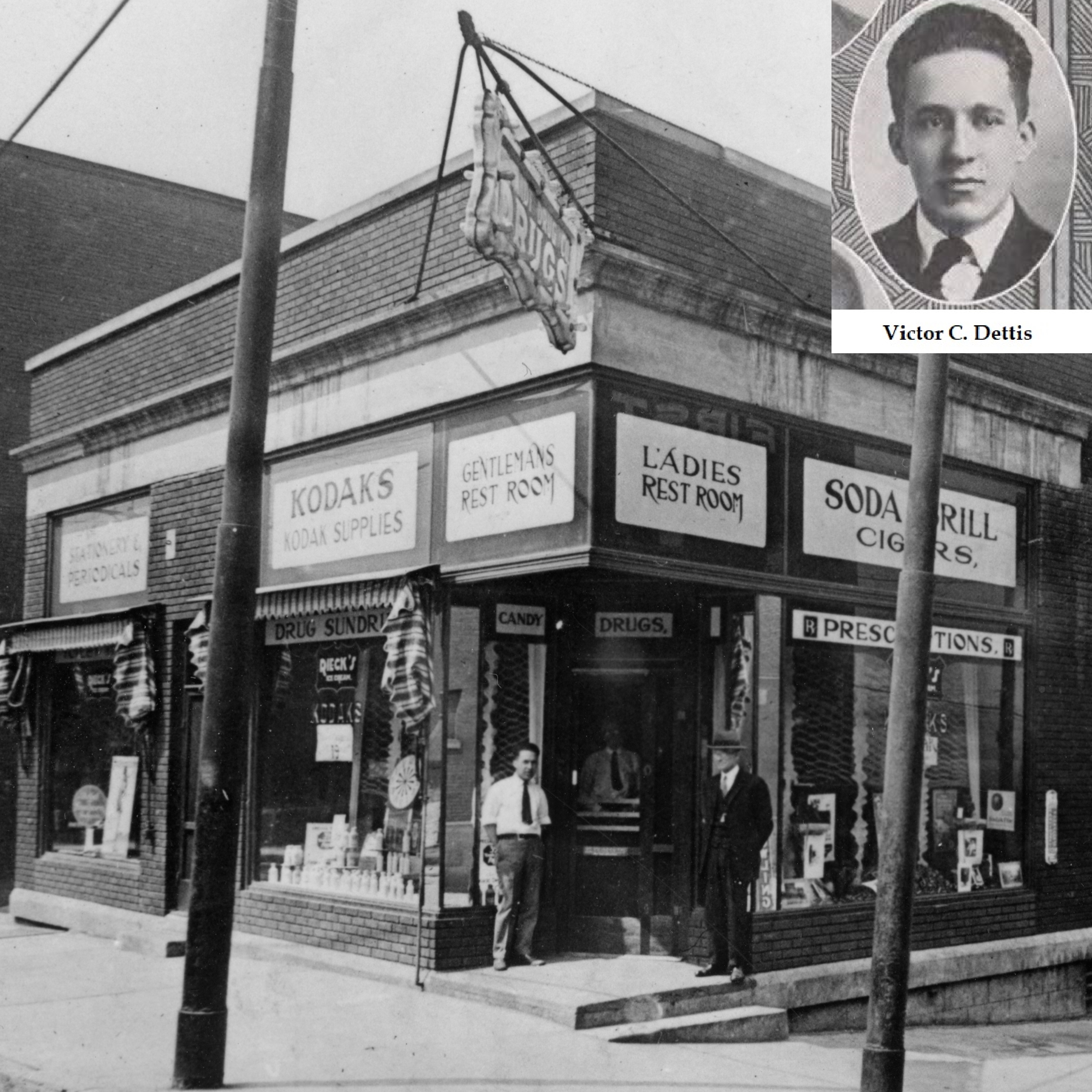
Weyandt Drug Company at 437 Cavitt Ave (corner of Cavitt and Fifth Street).Victor Dettis is standing to the left of the door. The older gentleman on the right may be S.L. Weyandt. There is a third person standing inside the door. The portrait of Victor Dettis from The Owl, 1919, University of Pittsburgh.
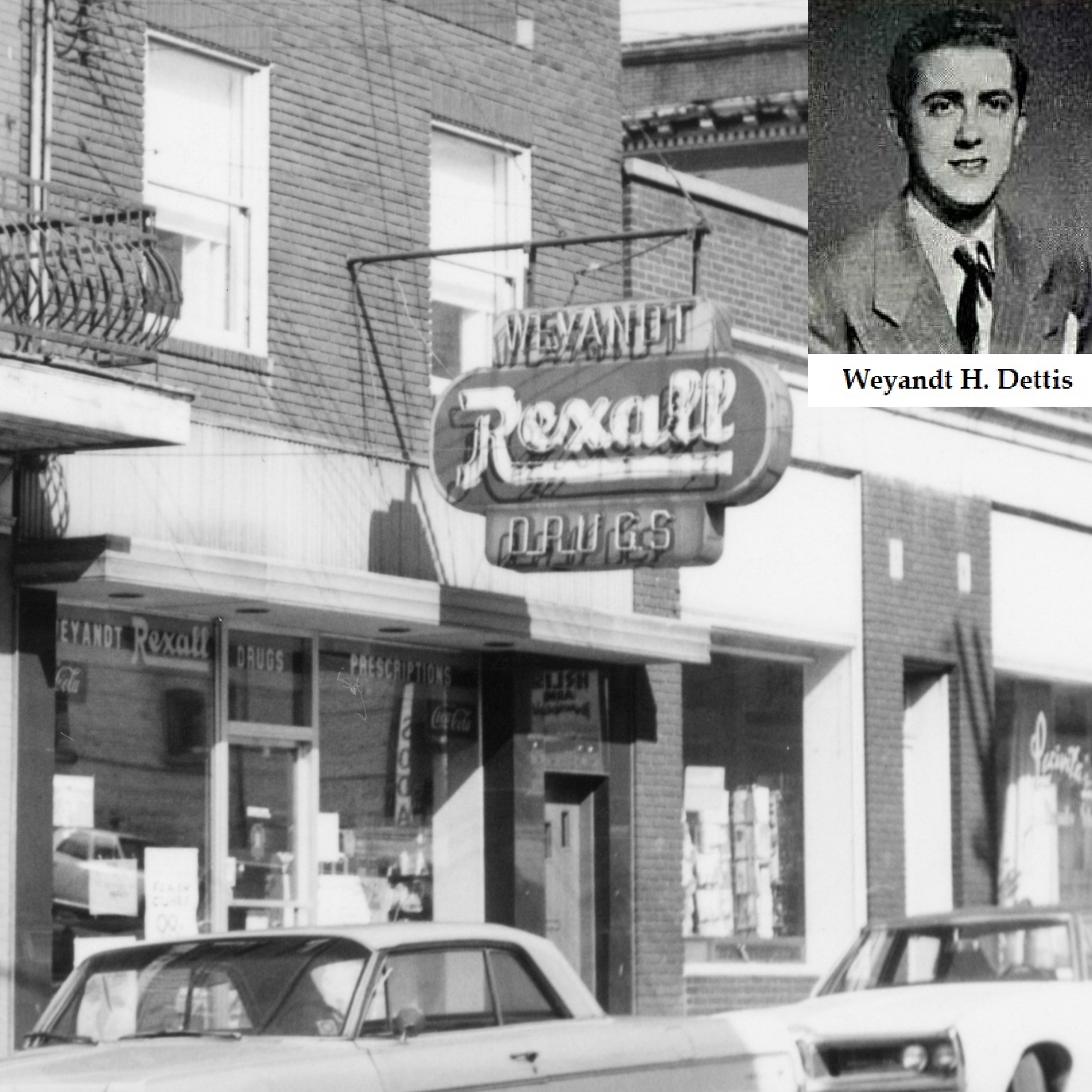
The final location of the Weyandt Drug Co. at 435 Cavitt Ave. The portrait photo of Weyandt Dettis from The Owl, 1951, University of Pittsburgh.
Week 29 Published by Andrew Capets - July 15, 2019
If you are familiar with the iconic movie, “It’s A Wonderful Life,” you can just imagine the drug store scene mirroring what Weyandt’s Pharmacy once had at 432 Cavitt Avenue. Samuel Logan Weyandt (1867-1941) established one of the first businesses in Trafford. Aside from dispensing the necessary cure for your ailment, his store offered the customary soda fountain, which became an important social gathering place. S.L. Weyandt was also a significant contributor to documenting the early days of Trafford City as he was responsible for having many of the early postcards of Trafford printed and sold in his pharmacy.
However, when comparing the real-life pharmacy to the one that appeared in the movie, Weyandt’s was missing the presence of the lead child character in the film, George Bailey. Recall the scene when the young George had his ear slapped by the druggist, Mr. Gower. George was shouting, “It’s poison I tell you, it’s poison!” Well, in August 1919, an accident occurred in Weyandt’s Pharmacy and one of the clerks was accused of dispensing the poison “carbonic acid” to a customer, when it was supposed to be “spirits of camphor.” As a result, a young boy named Robert Mathias of Penn Township “suffering great pain” when he spilled the poison on his hand. A lawsuit was brought against the S.L. Weyandt Pharmacy and the family sought $10,000 in damages for the incident. Fortunately, the young Mathias recovered from his injuries and would later raise his own family in Trafford, living on First Street Ext.
Weyandt’s Pharmacy recovered from the mishap and continued to serve the community of Trafford for many years. S.L. Weyandt lived in Trafford until the age of 73.
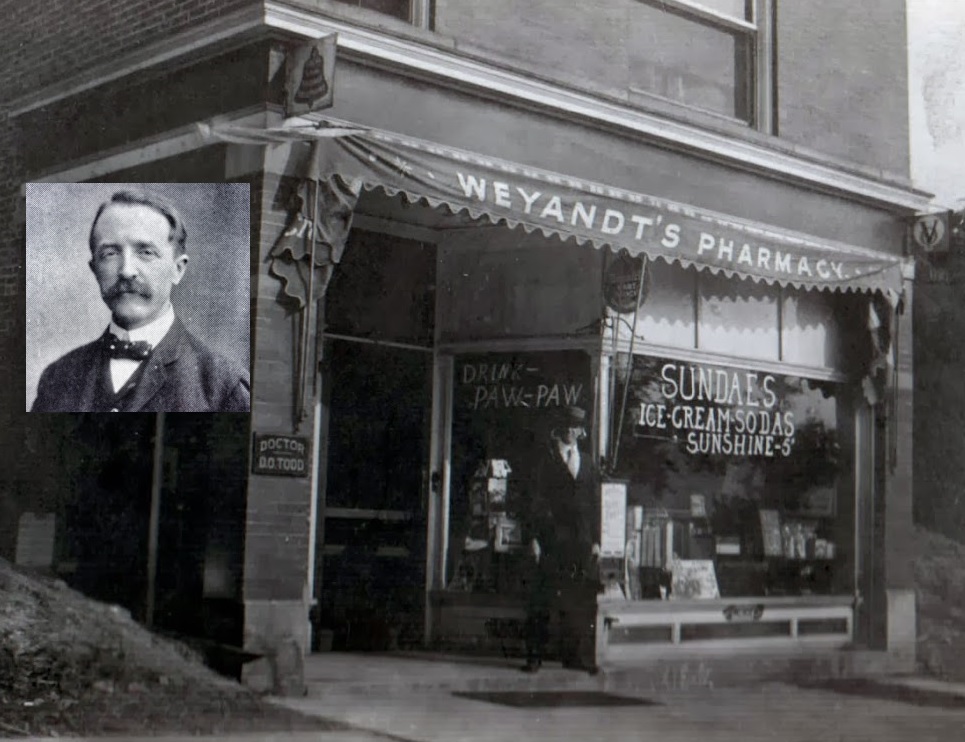
Week 28 Published by Andrew Capets - July 7, 2019
Summer league baseball in Trafford. Did you play? Was there a professional athlete on your team? During the 1954 and 1955 summer seasons, Trafford had an active professional football star playing on their sandlot baseball team. Pittsburgh Steeler Ray Mathews, who is currently recognized as a member of the “Steelers Legends Team,” played baseball for Trafford. Mathews was a Pittsburgh Steeler from 1951-59 and was selected by the Dallas Cowboys in the expansion draft of 1960. He was voted to the 1952 and 1955 NFL Pro Bowls. Mathews played left-field for Trafford in his off-season while he was still under contract with the Pittsburgh Steelers. When not playing for Trafford, Mathews also played on a couple of minor league baseball teams (Anderson Rebels and Greenville Spinners).
So how does a professional football player make his way to Trafford? We would love to know the full story, but for now, our best guess is that it may have been a Clemson University connection. Mathews, a graduate of McKeesport High School, was drafted into the NFL after playing football at Clemson University in 1951. Paul “Lou” Bucar, Trafford High Class of 1950, received a football scholarship to Clemson University (later graduating from Clarion University). These two Clemson football players, Mathews and Bucar, were standout baseball players in the Eastern County League competing against clubs from Ardara, Renton, Penn Township, Murrysville, and Westmoreland City. The Trafford team, managed by Coach Mastroianni, included notable players like Glen Bowser, Willie Feryak, Alex Kozubal, Tom Kozubal, Jim Leffler, John Lovre, Ralph Mocker, and Jack Warden.
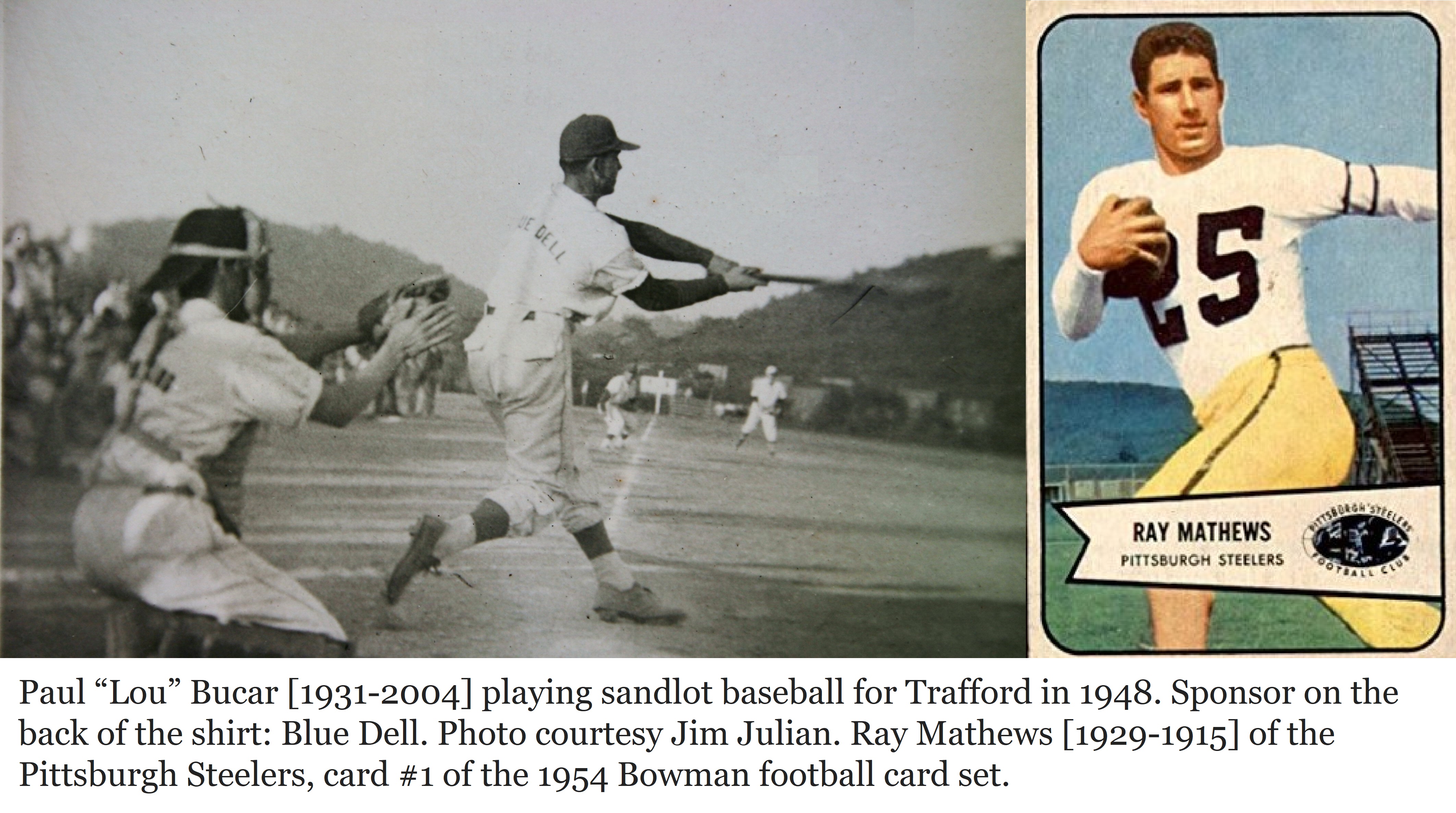
Week 27 Published by Andrew Capets - July 1, 2019
Enjoying a cold beer at a 'Fourth of July' picnic is a great way to celebrate our nation’s independence. However, imbibing too much has been known to ruin a good party. Take the case of a brawl that nearly killed Joseph Savinski of Braddock at a holiday picnic near Trafford. The “Shades of Death" was known to be a popular place to escape the smoke of the city and enjoy the cool shade provided by the large Eastern Hemlocks along the Turtle Creek. The “Shades” are located just off the Westmoreland Heritage Trail as you cross the first trail bridge coming from Trafford. In 1911, two groups decided to venture to the “Shades of Death” picnic grove, and one can only surmise that too much alcohol may have been consumed that day.
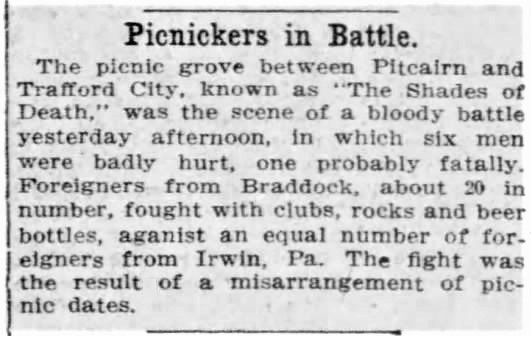
The Pittsburgh Daily Post reported “A party of foreigners employed in the Edgar Thomson Steelworks journeyed to the grove in a big wagon yesterday morning. There they met a crowd of men from Irwin out for a holiday celebration. The two bands mingled peacefully until about 4 o'clock in the afternoon when a fight started. The nearest policeman was three miles away, and the melee was uninterrupted until word came that officers were approaching. Most of the fighters fled, leaving the injured behind. Dr. O.D. Todd, of Trafford City, was summoned, and he dressed the wounds of those hurt.”
Clarence Raymond Blakeley (1871-1945) who lived on 6th Street and worked as a clerk for the Pennsylvania Railroad, served as Trafford’s Justice of the Peace. Blakeley made it known that aggravated assault and battery charges would be made against the rioters, and a blanket warrant was issued for their arrest. Fast forward to today, let’s all enjoy a safe and Happy Independence Day! Cheers!
Week 26 Published by Andrew Capets - June 23, 2019
This month marks 35 years since the passing of Daniel W. Schneider, Trafford High Class of 1964. Schneider was dubbed “Most Athletic” senior boy by his classmates (playing three sports - baseball, basketball, and football). He was arguably one of the best football players to graduate from Trafford High, being voted to All-Conference, All-County, and the Post-Gazette WPIAL Top 33 All-Star in football. Schneider attended college at Texas A&M and lettered in football for three years. He was Team Captain for the Aggies in the 1968 Cotton Bowl Classic against famed Bear Bryant’s Alabama Crimson Tide. Kenny Stabler was the quarterback for Alabama in that game, but it was Schneider and his Aggie’s who beat the Tide 20-16. Schneider was later named to the All-Southwest Conference Team. After college, he returned to Trafford and was self-employed as a title searcher in the mortgage industry. He passed away at age 38 and was survived by his wife Carol Mazzocchetti Schneider and son Daniel M. Schneider.
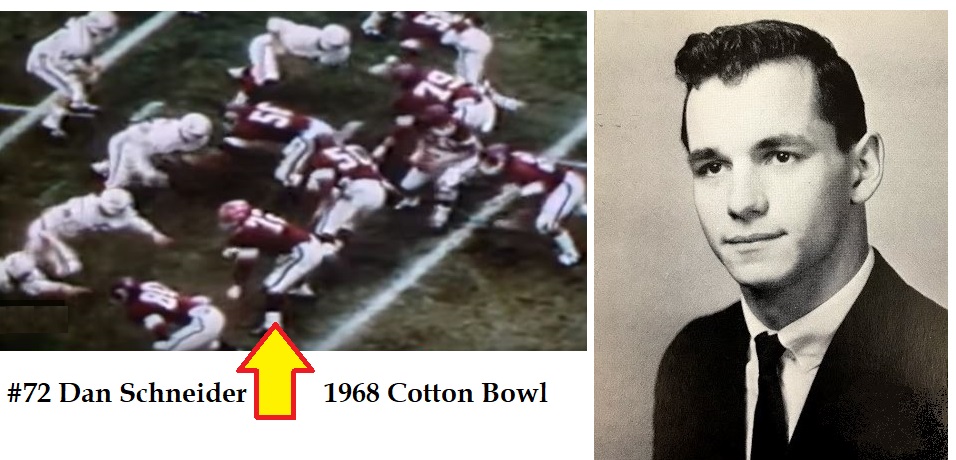
Week 25 Published by Andrew Capets - June 16, 2019
This photo appeared in the Jeannette News-Dispatch, 60 years ago this week. The team was sponsored by the J.F. Kingston Lumber Company as an entry into the Jeannette Slow-Pitch Softball League. Front Row (left to right): Albert Zuzki, John McCann, Ron Peduzzi, Fred Surmacz, Joe Draganac, Sam Draganac. Back row (left to right): Jim Divens, John Tarbuck, Bill Neala, George Valmassoni, Tony Banasik, Charles Noll, Manager Frank Ferraro.
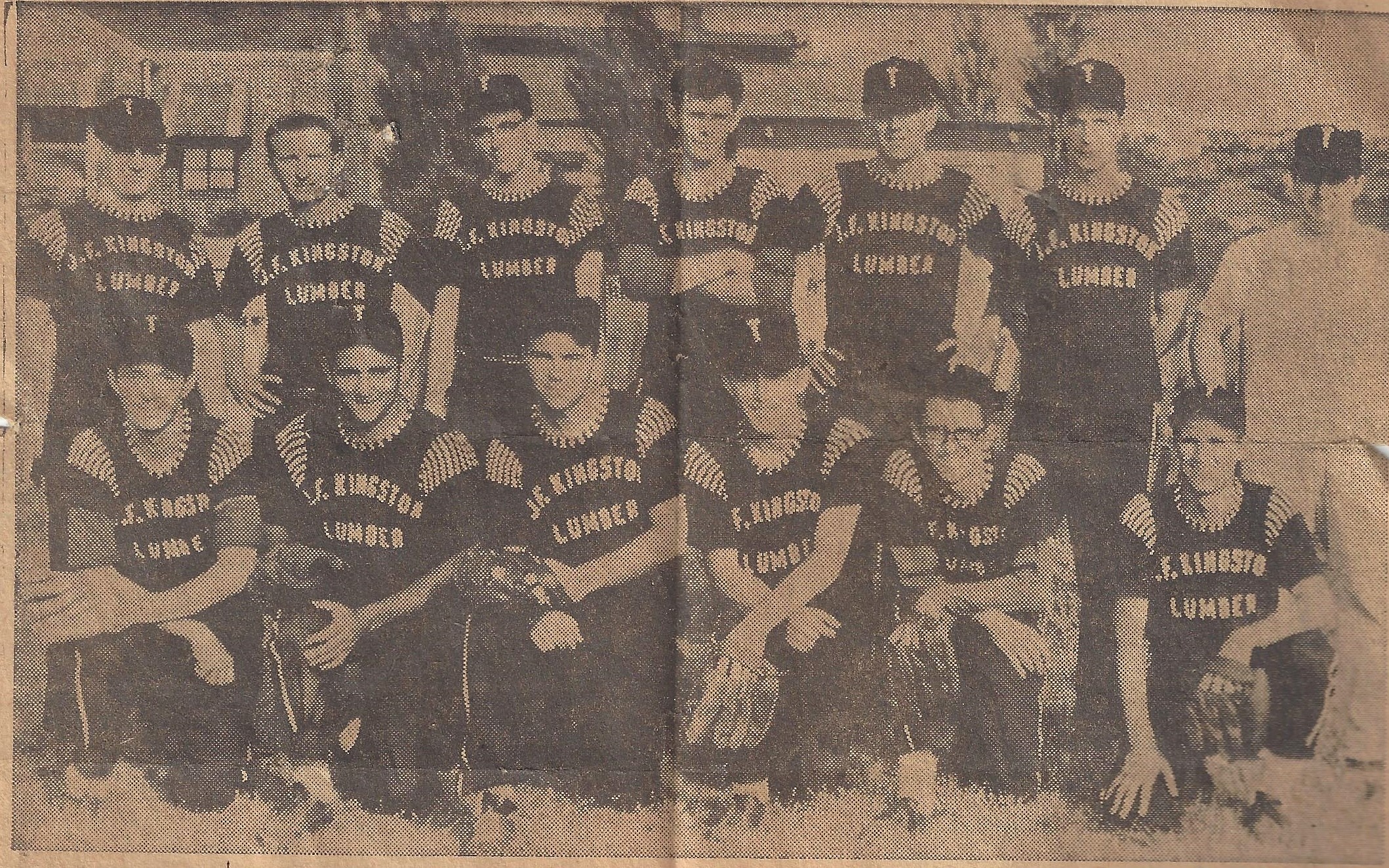
Week 24 Published by Andrew Capets - June 11, 2019
June 11, 2019 marks nine years since the death of Trafford's beloved Robert James Fike who was killed while serving in Afghanistan. Please keep his family in your thoughts today. We can acknowledge that no words here would ever lessen their loss, but as a community, we can let the family know he is remembered. Thirtheen days after his death, this clip was recorded by C-SPAN during proceedings of the United States House of Representatives in Washington, DC.
Week 23 Published by Andrew Capets - June 3, 2019
Imagine one of the world’s greatest inventors, George Westinghouse, standing in the newly established town of Trafford City, walking around his buildings, being briefed on the activities within the operations, and perhaps even watching your own ancestor working on the floor of his foundry. Trafford exists today because of the genius of George Westinghouse. He put this community on the map and it is our obligation to remember his legacy. The Trafford Historical Society is working on efforts to help tell his story. For now, let’s remember that this week marks the 115th Anniversary of the founding of Trafford through the efforts of George Westinghouse.
Here is a little snippet that appeared in the New York Times in 1904 describing a typical day in the life of George Westinghouse:
"After luncheon, he [George Westinghouse] will visit the Westinghouse foundry, his newest establishment at Trafford City, a little town just building up beyond Pittsburg and named with a certain deference to Trafford Park, in Manchester, England, where the British Westinghouse works were built two or three years ago. Then he goes back by railroad to town, fifteen miles or more, to his own office. In the evening there will be a dinner party. Perhaps some distinguished scientist is present, or visiting engineer, or railroad President, or European Ambassador. If there be none of these, it is a business dinner of half a dozen, or maybe a dozen and a half, of his principal men, and the things that could not be talked about during the day are discussed closely."
Happy 115th Birthday Trafford! Thank you, Mr. Westinghouse.
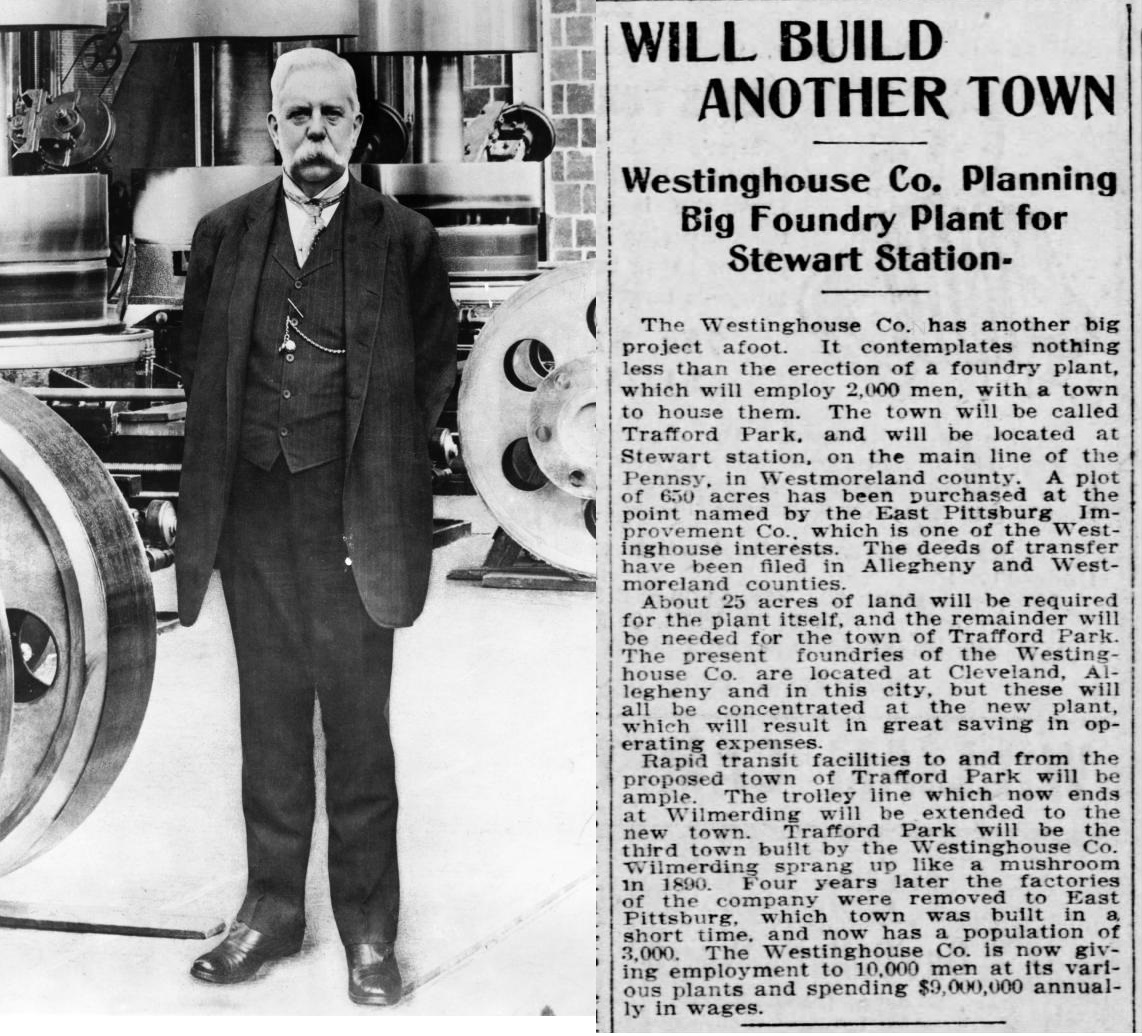
George Westinghouse circa 1910. Pittsburgh Press October 4, 1901, page 9.
Week 22 Published by Andrew Capets - May 27, 2019
The Faces of our Fallen. We do not have a photo of all those who are honored as our fallen. Please look at the list and let us know if you can provide us with a copy for any of these men who do not have a picture here.
http://traffordhistory.org/lookingback/images/veterans/Fallen13Aug2018.pdf
Week 21 Published by Andrew Capets - May 21, 2019
GIRL PICKING FLOWERS FALLS OVER CLIFF - Ledges Break Her Fall in Tumble Down Cliff. An accident that occurred at the “B.Y. Pond” as reported in the Pittsburgh Press, May 22, 1933:
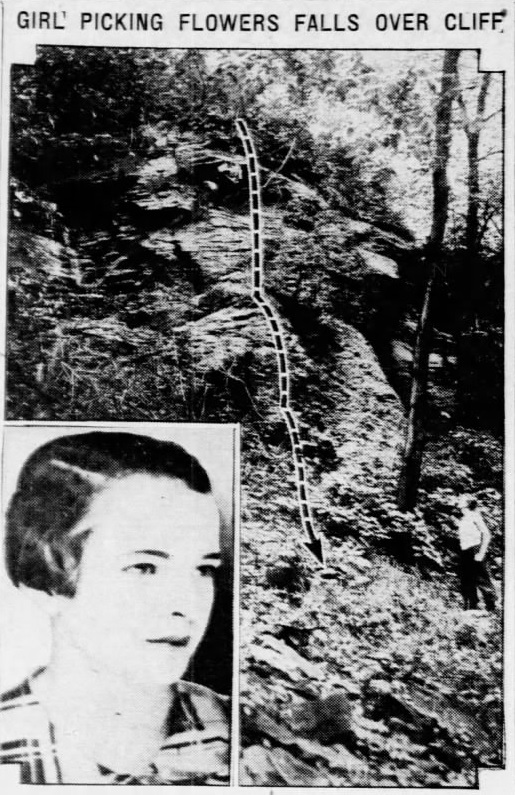 "Tumbling over a 50-foot cliff as she picked flowers yesterday, 13-year-old Dorothy Brown, of Trafford City, escaped with a fractured arm and wrist. Dorothy went for a Sunday afternoon stroll with Dorothy Shields, 11. On the cliffs high above the "B.Y." pond outside of Trafford City, they started picking flowers. The Brown girl, leaning over the edge of a cliff to gather flowers there, slipped and fell. She tumbled about 10 feet before she struck a small ledge, which broke her fall. Again she plunged downward but struck another ledge, which again slowed her fall. At the bottom of the cliff, the child luckily landed on a bit of soft earth at the edge of the pond. Dorothy lives at 320 Edgewood Avenue, Trafford City. She is at West Penn Hospital."
"Tumbling over a 50-foot cliff as she picked flowers yesterday, 13-year-old Dorothy Brown, of Trafford City, escaped with a fractured arm and wrist. Dorothy went for a Sunday afternoon stroll with Dorothy Shields, 11. On the cliffs high above the "B.Y." pond outside of Trafford City, they started picking flowers. The Brown girl, leaning over the edge of a cliff to gather flowers there, slipped and fell. She tumbled about 10 feet before she struck a small ledge, which broke her fall. Again she plunged downward but struck another ledge, which again slowed her fall. At the bottom of the cliff, the child luckily landed on a bit of soft earth at the edge of the pond. Dorothy lives at 320 Edgewood Avenue, Trafford City. She is at West Penn Hospital."
Less than a year after this article appeared in the Press, Dorothy Brown died at her home in Trafford on April 27, 1934. Unrelated to the fall, her death certificate reveals the cause of death was bronchopneumonia. She was only 13 years, 8 months.
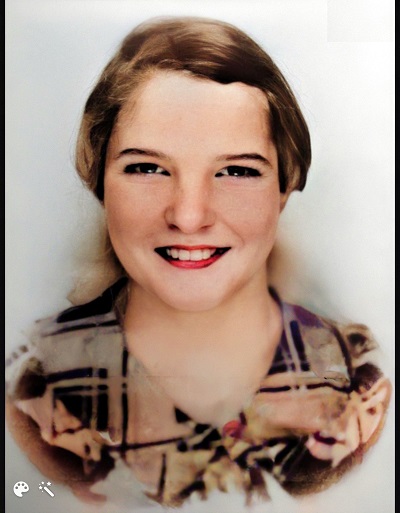
Dorothy Brown (courtesy grand-niece Lisa Bolton Smith)
Week 20 Published by Andrew Capets - May 14, 2019
I was filled with pride when I walked up a small street in France last week and came upon two flags fluttering in the wind. Waving proudly next to the French flag were the colors of Pennsylvania. I spotted three people sitting outside, and in my “Yinzer” way, raised both arms in the air and shouted “PENNSYLVANIA!” The response back, “Oui, en Pennsylvanie!”
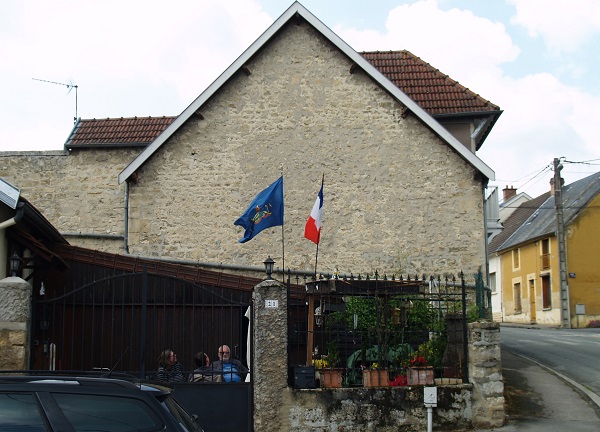
I was there to trace the final steps of Lt. Frank Glendenning, one of Trafford’s WWI fallen. I pulled out my phone and showed the residents a photo of Glendenning. The young gentleman looked at my photo, placed his hand on his heart, and uttered just one word, “Respect.” It nearly brought tears to my eyes. This family in France pays homage every day to the men of Pennsylvania who sacrificed everything to take back the town of Fismette from the Germans.
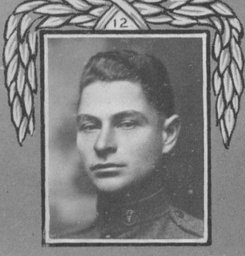 There is a wonderful walking tour that was installed for the Centennial to guide visitors through the streets and learn about what took place there during the Great War. One of the tour placards highlights a brief story of William Hervey Allen from Pittsburgh who wrote, “Toward the Flame.” It was in this book that I learned Glendenning’s story. The sign is placed next to the Vesle River. As I walked along this river I wondered if Glendenning compared its size to that of the Turtle Creek. Was he reminded of his days swimming at “The Bend” along Brickyard Road where he lived during his youth? I would venture to say it would have been a fleeting thought as Allen writes of his focus on the mission, “Glendenning led the way, a tower of strength in time of need as usual.”
There is a wonderful walking tour that was installed for the Centennial to guide visitors through the streets and learn about what took place there during the Great War. One of the tour placards highlights a brief story of William Hervey Allen from Pittsburgh who wrote, “Toward the Flame.” It was in this book that I learned Glendenning’s story. The sign is placed next to the Vesle River. As I walked along this river I wondered if Glendenning compared its size to that of the Turtle Creek. Was he reminded of his days swimming at “The Bend” along Brickyard Road where he lived during his youth? I would venture to say it would have been a fleeting thought as Allen writes of his focus on the mission, “Glendenning led the way, a tower of strength in time of need as usual.”

The picturesque streets made it difficult to visualize the fierce house to house combat that took place over 100 years ago. Allen writes of the snipers and machine guns that pummeled the men of the 28th Division as they worked to find any sort of advantage over the enemy. Allen again writes, “It was impossible even to appear in the street. Lieutenant Glendenning lay dead there, shot through the heart, fine brave heart, I couldn’t help crying when I heard of that –“
I had the absolute pleasure of being invited into this cozy courtyard to share a glass of wine and toast the men of Pennsylvania. The younger gentleman, Christopher, did a wonderful job translating as they shared some of the details they had learned about the history of the fight. I was overwhelmed with the amount of gratitude they expressed to remember these men.
Week 19 Published by Andrew Capets - May 9, 2019
Thank you, Mr. Dominique Lacorde (Historian from Gesnes-en-Argonne) for helping us honor and remember Trafford’s Fallen Veteran - Homer W. Earl who died of wounds July 10, 1918. Lest we forget. Meuse-Argonne American Cemetery in Romagne-Sous-Montfaucon, France.
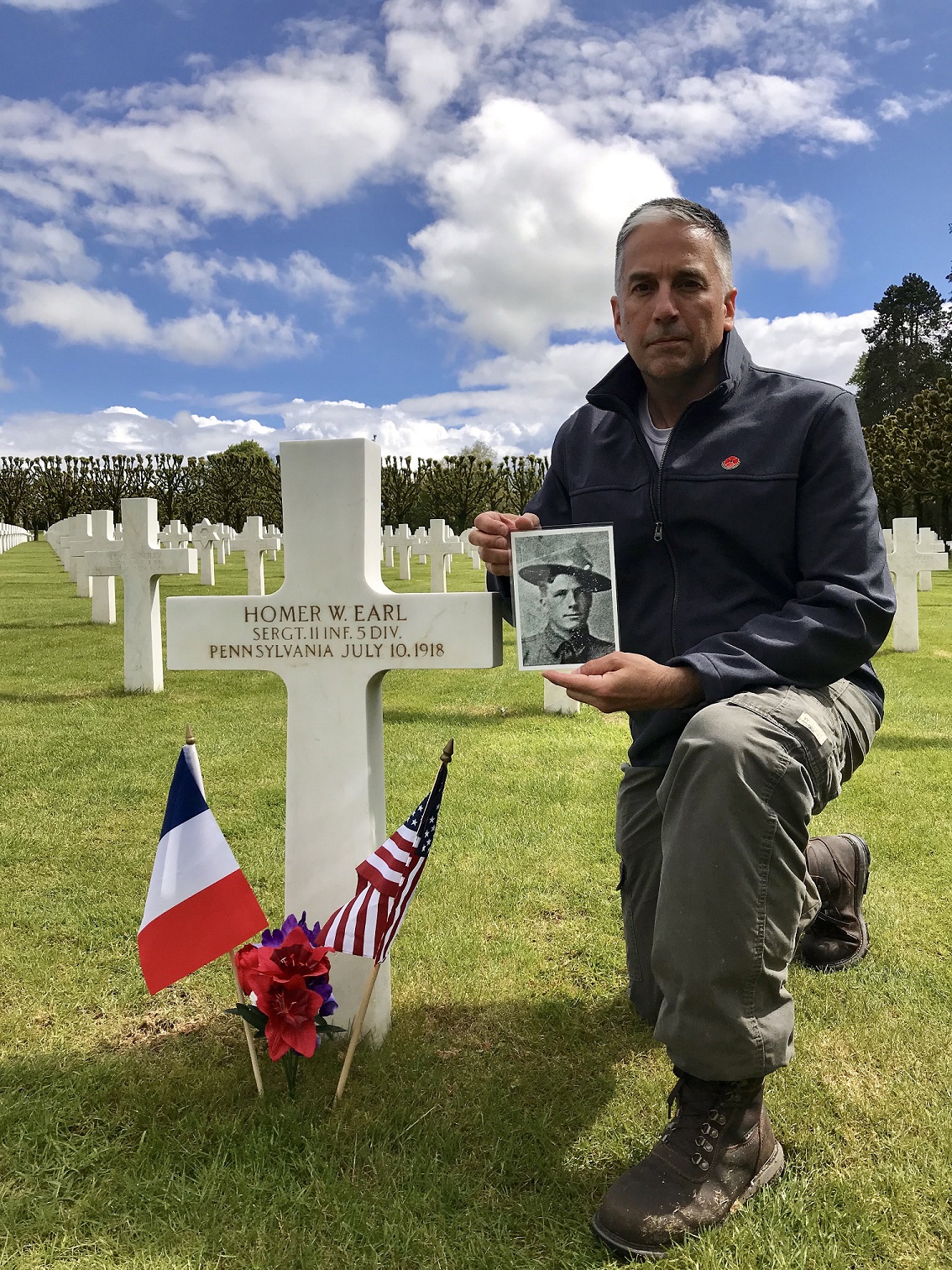 Please view the video above, a moving gesture when visiting the burial site of a young man from Trafford. The sand used comes from the beaches of Normandy to bring out the name that has been chiseled in the marble cross. The cross is not damaged or stained as the rain and wind will natually remove the sand. Local historian, Dominique Lacorde, made this presentation and also wrote a short story for his local newspaper about three Americans to visit and honor the fallen. The three of us also traced the footsteps of our own grandfathers who served in France over 100 years ago. We also "recreated" a famous photo that was taken in a church in Exermont during WW1.
Please view the video above, a moving gesture when visiting the burial site of a young man from Trafford. The sand used comes from the beaches of Normandy to bring out the name that has been chiseled in the marble cross. The cross is not damaged or stained as the rain and wind will natually remove the sand. Local historian, Dominique Lacorde, made this presentation and also wrote a short story for his local newspaper about three Americans to visit and honor the fallen. The three of us also traced the footsteps of our own grandfathers who served in France over 100 years ago. We also "recreated" a famous photo that was taken in a church in Exermont during WW1.
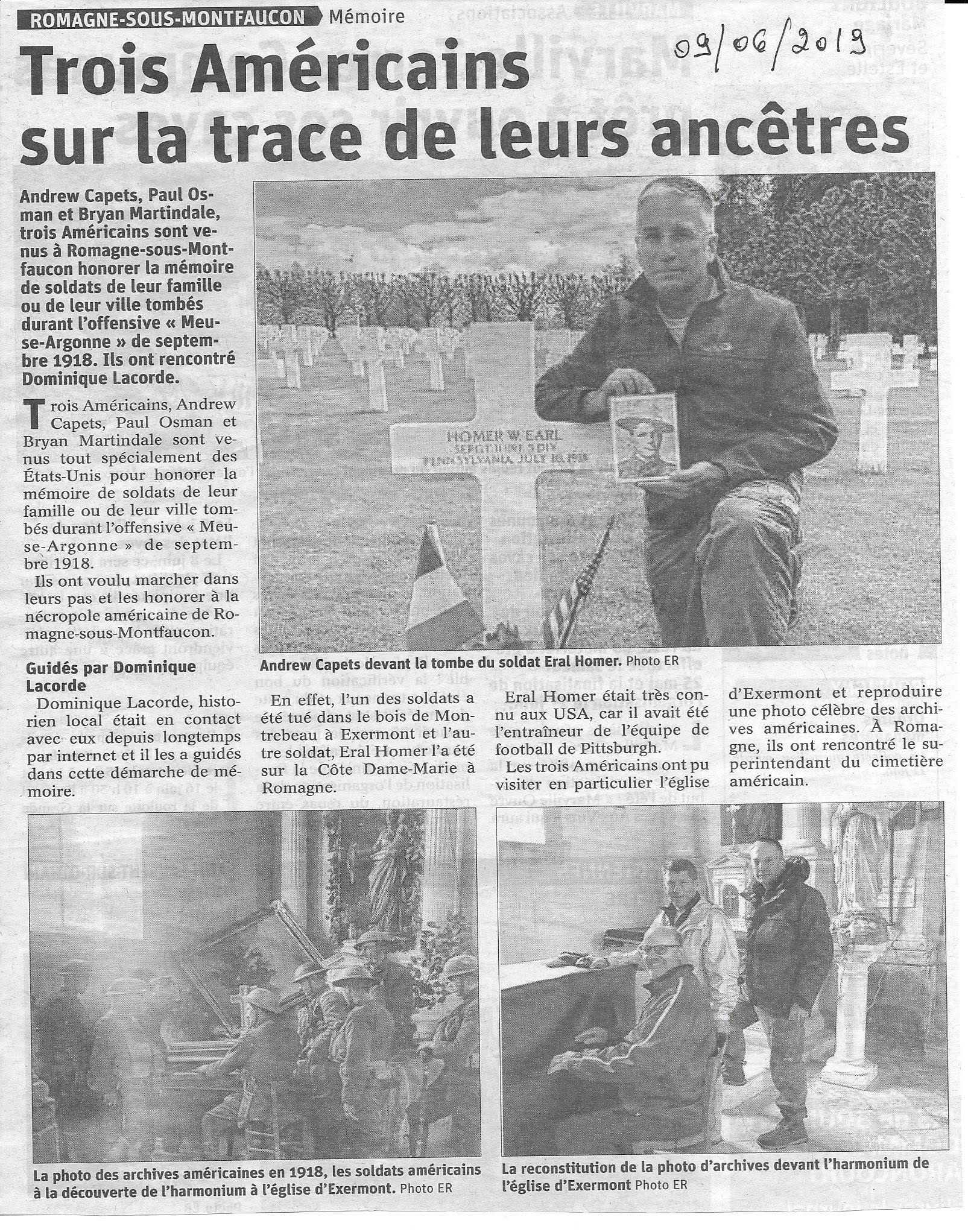
Week 18 Published by Andrew Capets - April 30, 2019
This week we remember Robert S. DiRinaldo, born in Trafford on April 28, 1932. He was not only recognized locally as the best shoe repair business in the area, but he would also become internationally known as an elite craftsman in his trade, and later honored by the industry with the naming of an annual award in his honor. DiRinaldo learned the shoe repair trade at the age of eight and ran a successful business in Trafford for many years. Changes in society forced many shoe repair businesses to close when shoes became less expensive to buy when mass produced. However, DiRinaldo simply found his own way to excel in the business, promoting it, and graciously giving of his time to teach others the craft. He understood the changing demands and gives us a great example of how a business owner, so loved by his customers and respected by his peers, can find a way to succeed in a business regardless of changes happening outside of your control. DiRinaldo was so admired in the industry that the SSIA Shoe Service Institute of America gives an annual award called the “Robert DiRinaldo Grand Silver Cup,” presented as a symbol of the excellence in the craft that these individuals strive to achieve.
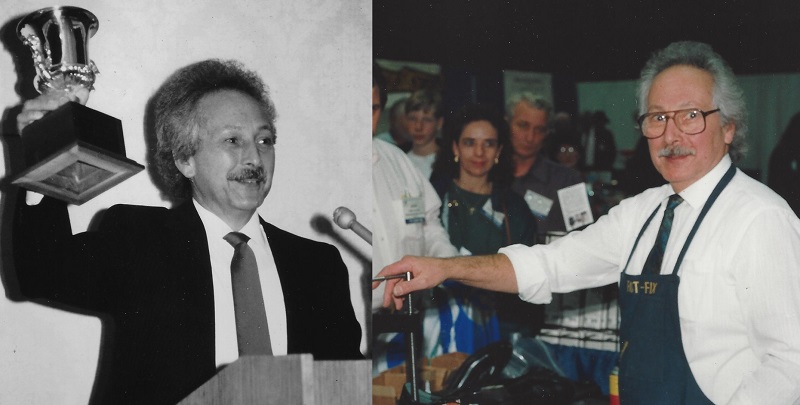
Week 17 Published by Andrew Capets - April 23, 2019
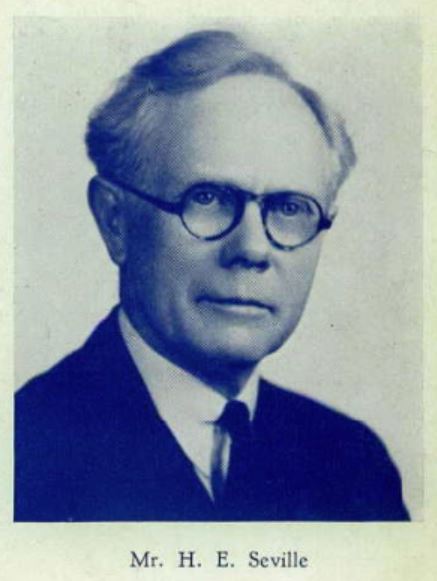
One morning, a student pulled the fire alarm, despite the lack of any fire, and the entire student body walked out of the building. Teachers soon learned that they were protesting the decision to force Seville from his position and refused to return to class. A few newspaper photographers showed up at the school on two different days to capture the students on strike. However, at the urging of Principal Seville, the students eventually returned to class. A petition was circulated through the school and a citizen’s meeting was held asking for the reinstatement of Mr. Seville. Ultimately, the Board prevailed as regulations at that time allowed for the forced retirement based on age (without legal action), and Seville was obligated to retire. Seville held the position as supervising principal for 23 years, and yet, even in retirement, he would later serve on the Trafford’s Board of Education until his death in 1955.
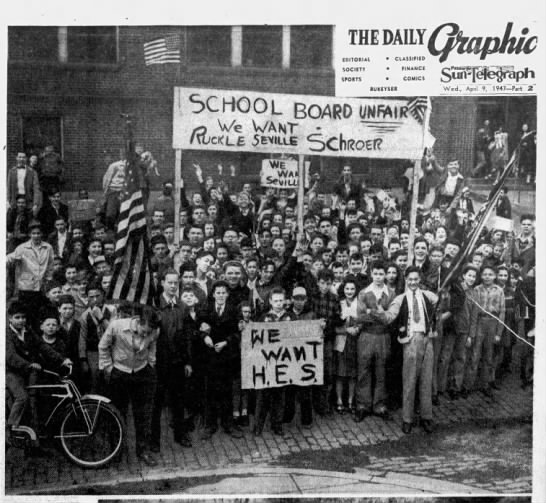
When Seville first came to Trafford in 1924, the high school was only a three-year high school. Seville helped form the school into a 4-year high school and organize a means by which a graduate would be able to enter any school or college without an examination if his grades were in the acceptable quartile by the admitting school.
In the 1944 Trafford yearbook, it reads in part, “Everyone is thankful to him for his splendid cooperation toward the betterment of the community. He has done much toward the war effort. We take this opportunity to express our thanks and appreciation to Mr. Seville.”
Week 16 Published by Andrew Capets - April 16, 2019
This photo gives us a rare look inside the railroad tower (or cabin) that was situated along the Pennsylvania Railroad in Trafford. William James Earl (1863-1906) is shown inside “Tower SZ” that once controlled the flow of traffic along this busy railroad junction.
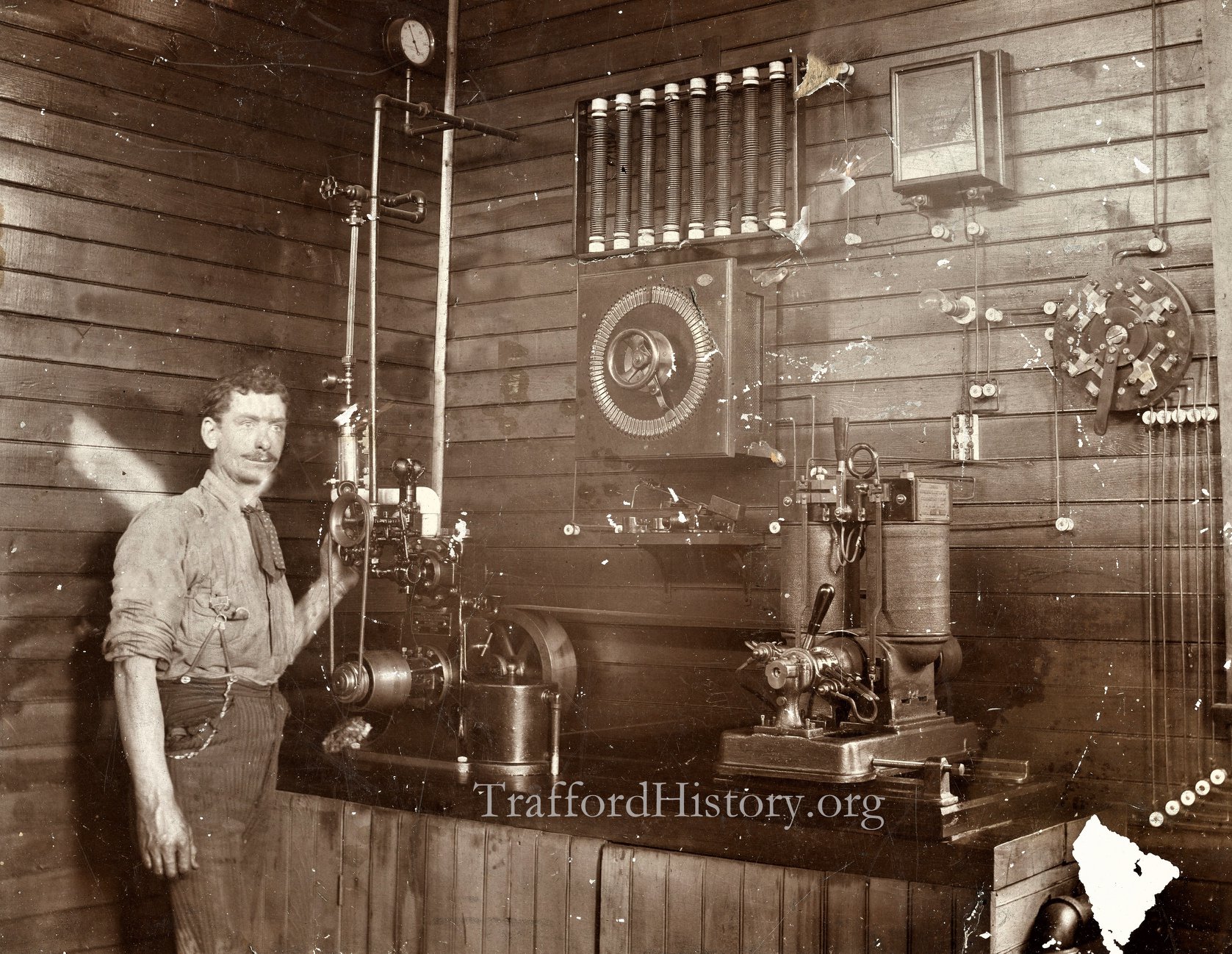
As a towerman, he would have been the “traffic cop” working the interlocking machine to align the switches and signals to keep the trains moving safely down the tracks. In 1906, while working in the railroad yard at Wilmerding, William Earl was killed when he stepped out of the way of a moving freight train and stepped into the path of a fast-moving Pennsylvania passenger express. Earl was 43 years old at the time of his death and left behind a wife and six children. Earl lived in Cavittsville when this photo was taken of him inside Tower SZ (photo courtesy of grandson Jim Earl). Tower SZ can be seen in the photo as the train has passed it heading toward Pitcairn PA. Trafford Borough would be on the right. The corner of Stewart Station is on the right. (Photo courtesy Chris Baker). The tower was removed after the railroads began to modernize the movement of trains with centralized traffic controls (CTC).

Week 15 Published by Andrew Capets - April 8, 2019
This week we remember Trafford High School graduate Joseph E. Dahlstrom, Class of 1937, who was killed 75 years ago during WWII. This summer marks the 75th anniversary of the largest amphibious invasion in military history, D-Day which began June 6, 1944. Prior to the invasion, preparations were taking place to weaken the German defenses. The Allies were running pre-invasion bombing raids and Dahlstrom, a 25-year-old Tech Sergeant with the 445th Bomb Group, sat in the top turret of the “Paper Doll II,” a B-24 Liberator for one of those missions. It was just six months earlier that he was in Pima, Arizona marrying his sweetheart, Maude Leidy of Pitcairn.
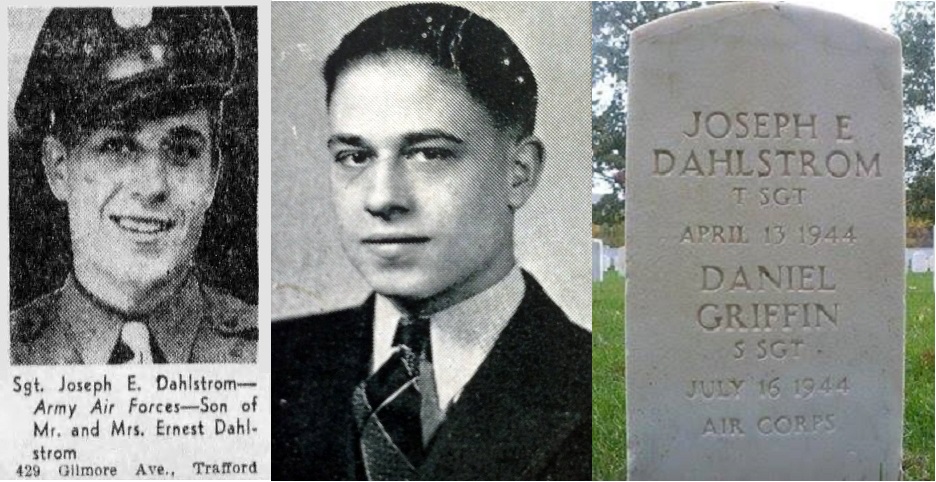
On April 13, 1944, Dahlstrom’s plane was hit by German anti-aircraft fire and crashed, killing all seven crewmembers. Sadly, records show that his remains were shipped from Saint Avold-Metz France in 1950 as part of a group burial that took place in Woodlawn National Cemetery, Elmira NY. He was interred in a common grave and shares a headstone with Daniel Griffin who was killed in a separate incident on July 16, 1944, when Griffin’s plane was shot down over Neuried, Germany.
Gold Star parents Hattie & Ernest Dahlstrom lived at 429 Gilmore Avenue at the time of their son’s death. They later moved to Level Green and both passed in the mid-1960s.
Week 14 Published by Andrew Capets - April 2, 2019
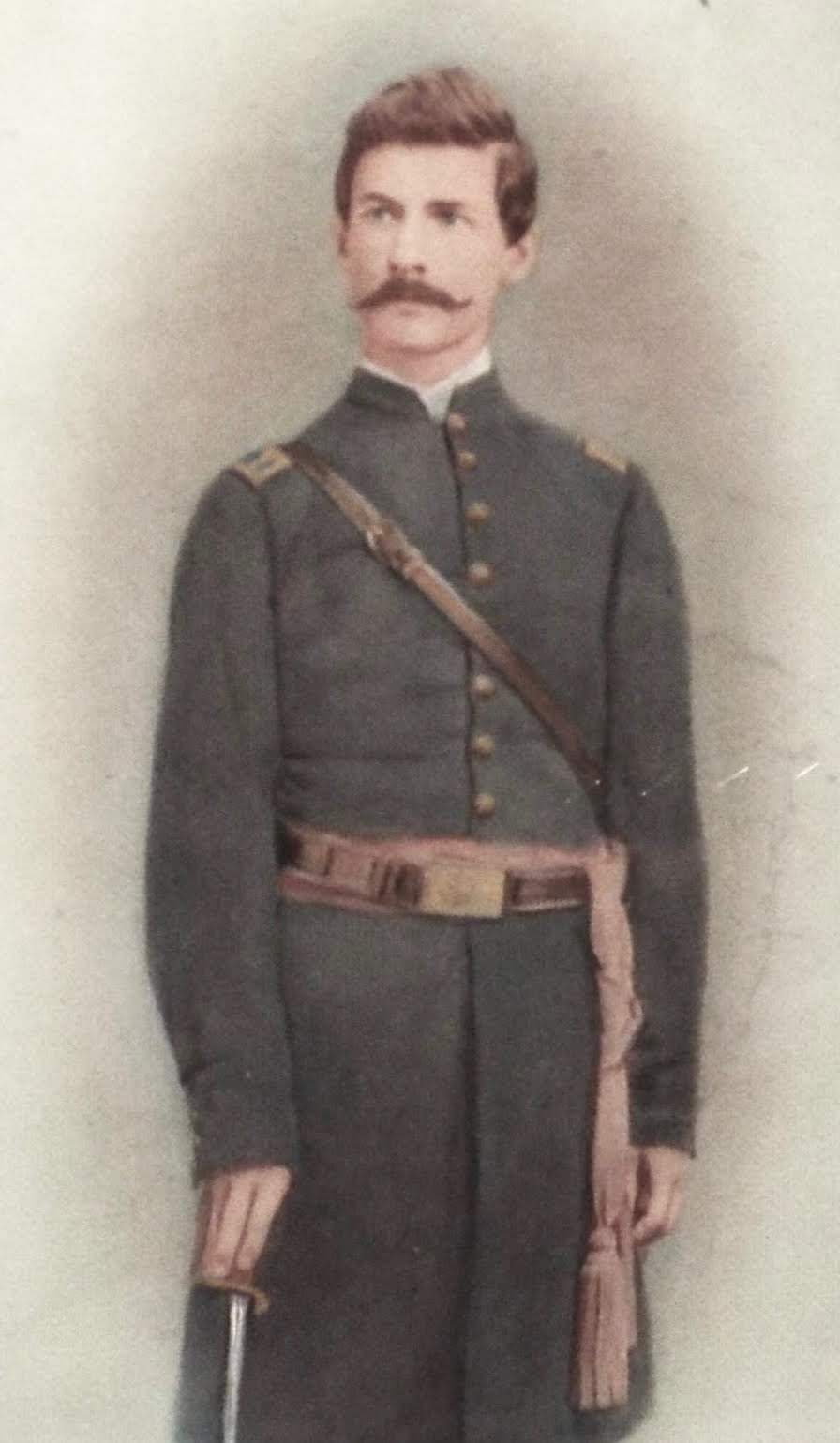 On April 2, 1841, Robert Ekin Stewart was born in Stewart Station, the early settlement in Westmoreland County known today as Trafford. After being raised on his father’s farm he graduated from Jefferson College just one year before the start of the American Civil War. In August 1862, Stewart enlisted in the 123rd Pennsylvania Volunteers, a regiment of “Christian Soldiers” mustered together under the command of a Presbyterian minister, the Rev. John Barr Clark. Stewart was commissioned a First Lieutenant and would see action in the Battle of Fredericksburg in December 1862 and the Battle of Chancellorsville in April-May 1863. When his enlistment expired, he returned to Pittsburgh to work towards his law degree. In 1865, he returned to military service and was commissioned a Major in the 24th Regiment of US Colored Troops. Their motto, “Let Soldiers in War, be Citizens in Peace.”
On April 2, 1841, Robert Ekin Stewart was born in Stewart Station, the early settlement in Westmoreland County known today as Trafford. After being raised on his father’s farm he graduated from Jefferson College just one year before the start of the American Civil War. In August 1862, Stewart enlisted in the 123rd Pennsylvania Volunteers, a regiment of “Christian Soldiers” mustered together under the command of a Presbyterian minister, the Rev. John Barr Clark. Stewart was commissioned a First Lieutenant and would see action in the Battle of Fredericksburg in December 1862 and the Battle of Chancellorsville in April-May 1863. When his enlistment expired, he returned to Pittsburgh to work towards his law degree. In 1865, he returned to military service and was commissioned a Major in the 24th Regiment of US Colored Troops. Their motto, “Let Soldiers in War, be Citizens in Peace.”
After finishing his military service, he was admitted to the Pittsburgh Bar in 1867. Stewart excelled in nearly every facet of his personal and professional life. He helped organize the Braddock National Bank where he was a major stockholder and served as bank president of seven years.
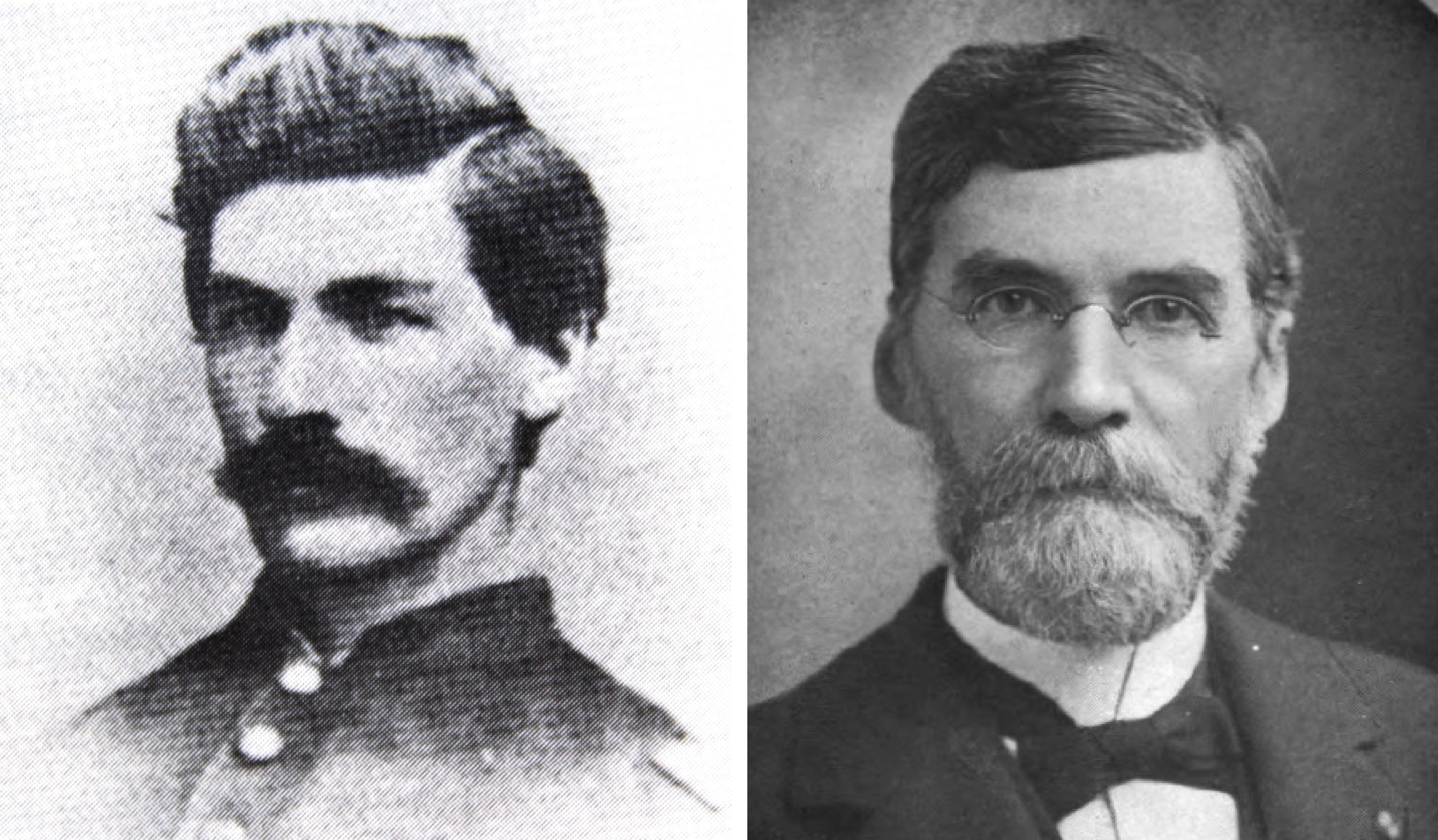
A pioneer in Pittsburgh history, his resolute faith equipped him for many leadership roles where he sought to advance his community through involvement in the Allegheny County Schools, United Presbyterian Churches, Western Pennsylvania School for the Deaf, and the Carnegie Free Library. In 1903, he served as District Attorney for Allegheny County and was known for prosecuting the “keepers of bawdy houses” in an effort to suppress the “social evil in these cities and throughout the county.” In a bio written for the “History of Jefferson College Class of 1860,” Stewart was described as “A true man, brave a soldier, an exemplary citizen, reaching high rank in his chosen profession, he was by way of eminence great in his goodness.”
Week 13 Published by Andrew Capets - March 26, 2019
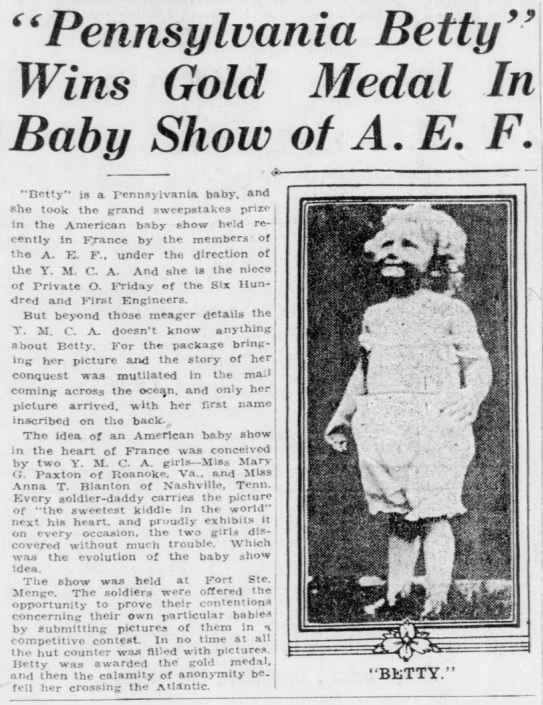 As we commemorate the Centennial of WW1, here’s an interesting fact to tie Trafford to the events happening in France 100 years ago. The first American baby to win a gold medal in France, 1919, was from Trafford, Pennsylvania. Her photo appeared in newspapers across the United States with the caption “Pennsylvania Betty.” Her photo was entered into a contest created by a couple of YMCA workers serving with the AEF in Saint Menge, France. The two YMCA canteen workers, Mary G. Paxton and Anna T. Blanton, were constantly being shown baby pictures by proud soldier fathers, brothers, or uncles, so they decided to have a baby photo contest. The Doughboys “dug into their OD pockets and khaki frames” with confidence that their “pet infant back in the States was the nicest baby in the world.” The baby show was a great success, finding a temporary distraction for the Doughboys who were clamoring to get home to their loved ones following the war. “Pennsylvania Betty” was Elizabeth Guckelberg, the niece of Private Oswald Friday, a soldier with the 601st Engineers who was drafted into service from Larimer, PA. Private Friday received the photo from his sister who was then living on Fairmont Avenue in Trafford.
As we commemorate the Centennial of WW1, here’s an interesting fact to tie Trafford to the events happening in France 100 years ago. The first American baby to win a gold medal in France, 1919, was from Trafford, Pennsylvania. Her photo appeared in newspapers across the United States with the caption “Pennsylvania Betty.” Her photo was entered into a contest created by a couple of YMCA workers serving with the AEF in Saint Menge, France. The two YMCA canteen workers, Mary G. Paxton and Anna T. Blanton, were constantly being shown baby pictures by proud soldier fathers, brothers, or uncles, so they decided to have a baby photo contest. The Doughboys “dug into their OD pockets and khaki frames” with confidence that their “pet infant back in the States was the nicest baby in the world.” The baby show was a great success, finding a temporary distraction for the Doughboys who were clamoring to get home to their loved ones following the war. “Pennsylvania Betty” was Elizabeth Guckelberg, the niece of Private Oswald Friday, a soldier with the 601st Engineers who was drafted into service from Larimer, PA. Private Friday received the photo from his sister who was then living on Fairmont Avenue in Trafford.
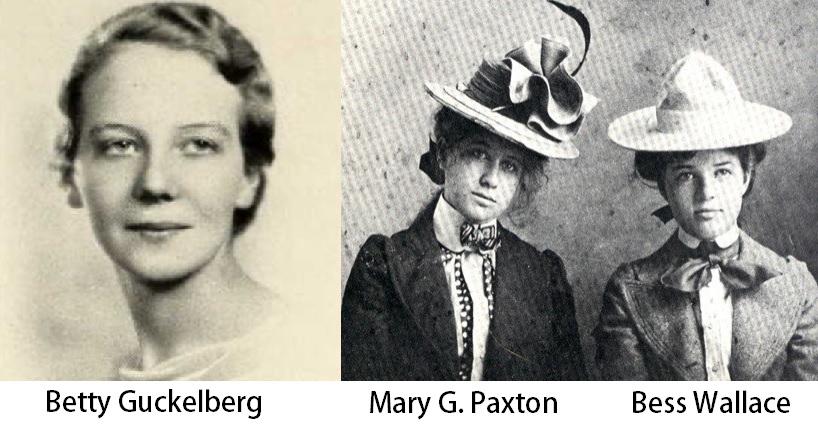
Elizabeth "Betty" Guckelberg (1915-1968) graduated from Chatham College in Pittsburgh in 1937. Her yearbook bio indicates she was active in the YWCA. Source: Ancestry U.S., School Yearbooks, 1880-2012. The YMCA worker Mary G. Paxton (above) is photographed with her friend Bess Wallace, the future wife of WW1 Veteran and U.S. President Harry S. Truman. Credit: Harry S. Truman Library & Museum. Newspaper: “Pennsylvania Betty Wins Gold Medal in Baby Show of A.E.F.” Pittsburgh Daily Post (Pittsburgh, Pennsylvania) April 13, 1919.
Week 12 Published by Andrew Capets - March 20, 2019
Clyde Griffith Brandt (1891-1961) was 25 years old when he moved to Trafford in 1916. He worked for the Pennsylvania Railroad as a brakeman, but a 5-month long strike in 1920 led him to reconsider his career choice. He eventually found his way to becoming a Borough police officer at a time when Trafford was ranked second, only behind Greensburg, in the total number of court dockets brought before the Westmoreland County, PA justices. The booming town of 'Trafford City' was attracting its share of crime and compelled the Trafford Borough leaders to add more police officers to their ranks. Brandt worked his way up to becoming Police Chief and served the community in this capacity for 30 years. After retiring as Chief, Brandt was elected by the public to serve as 'Justice of the Peace' where he held that position for six years until his death in 1961.
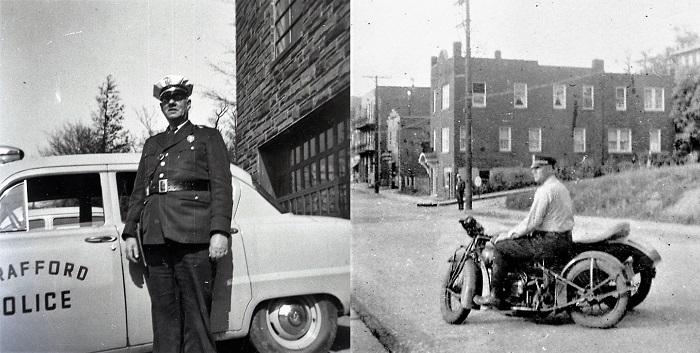
Week 11 Published by Andrew Capets - March 12, 2019
Last month you may have read the story about the Civil War era cannonball that currently sits in Westmoreland Park. This is a follow up to that story. This photo was taken in 1940 during the 50th wedding anniversary of John and Mary George of Cavittsville. The family is standing next to the cannonball that once stood in front of their home for nearly a century. The home, present-day 14801 Cavittsville Road, Trafford, was built in 1902.
In the early 1900s, when the Pennsylvania Railroad expanded their tracks in the area, John O. George helped his father-in-law, Richard Custer, move this massive cannonball from "the old log cabin homestead" then located along the creek, to this hilltop home in Cavittsville. The cannonball remained in front of the home until 1998 when it was donated to the community of Trafford by family descendants.
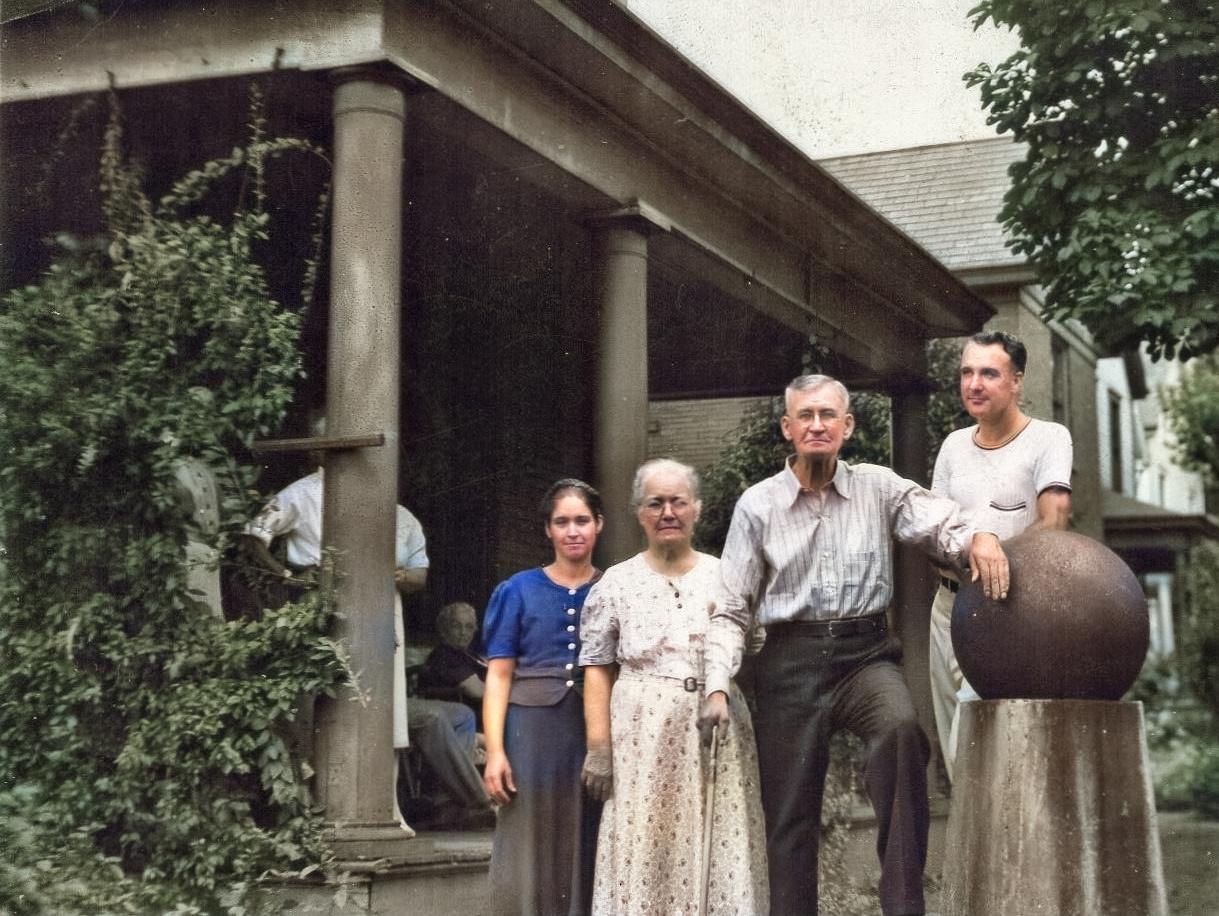
(L-R) Daughter Rebecca Jean George, Mary Custer-George (the daughter of Civil War veteran Richard Custer), John Oliver George, and their son Ralph W. George. Photo courtesy Richard Earl.
Week 10 Published by Andrew Capets - March 4, 2019
Ernest P. Whitten, a Civil Engineer, was one of Trafford Borough's first officers and served as a Justice of the Peace. When Trafford City was founded in 1904, some of the land acquired by Westinghouse overlapped with neighboring townships. In 1905, a Pittsburgh judge ordered the annexing of portions of North Versailles and Patton Township (now Monroeville) to become part of Trafford. Whitten was one of the commissioners assigned by the judge to accomplish this land acquisition.
This 1902 photo of Whitten was known as a “Multigraph,” once called the “Mystery of Photography” where you could “see yourself as others see you.” With the use of mirrors, your picture was taken five times in one sitting. A 1910 advertisement for Shapiro’s Music Store on Fifth Avenue in Pittsburgh announced that they had brought the craze to Pittsburgh from the summer resort of Atlantic City and you could get 12 pictures for 50 cents.
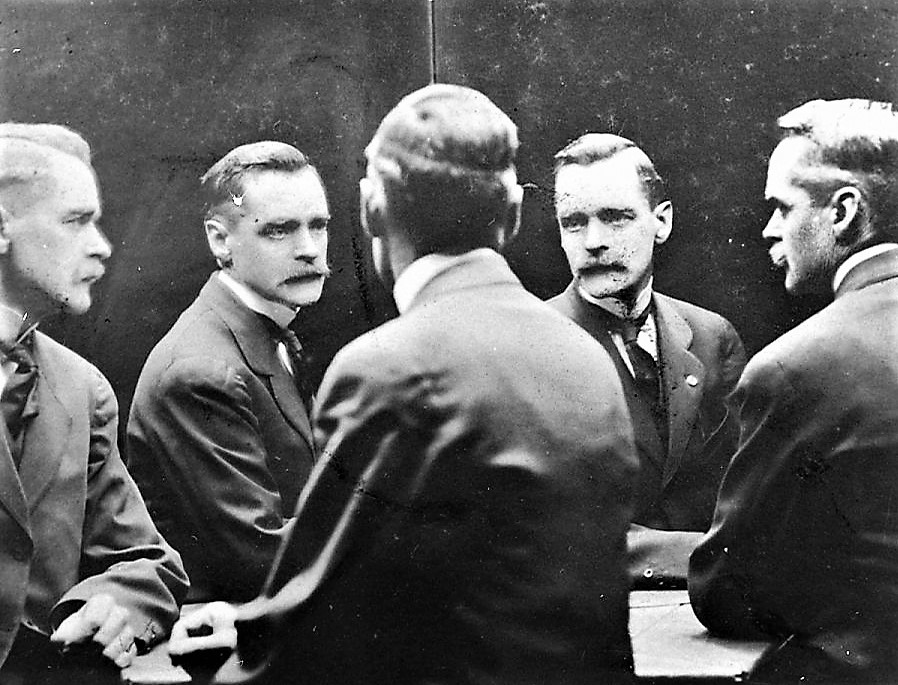
Week 9 Published by Andrew Capets - February 25, 2019
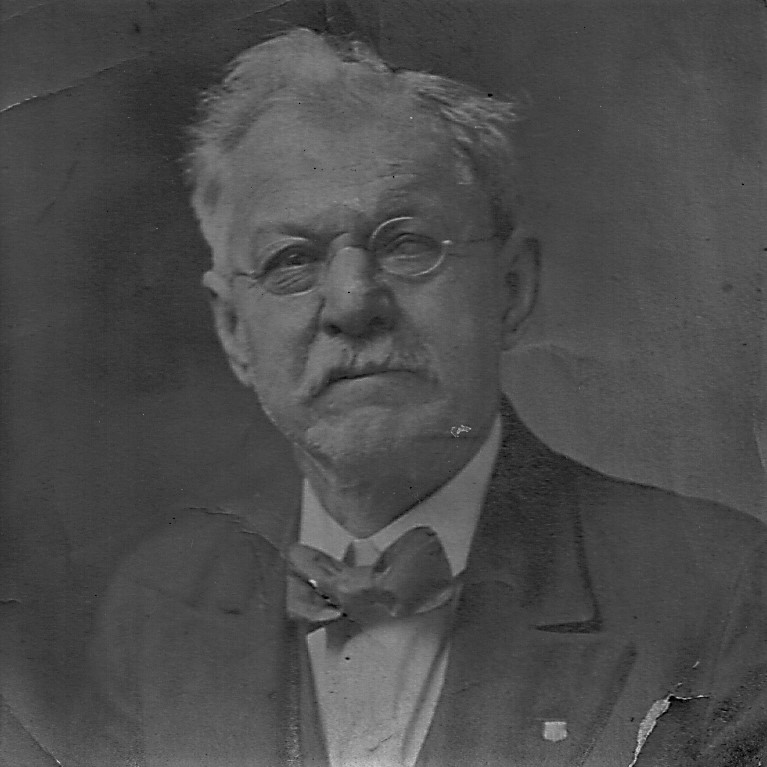 February 25, 1872, in Fredonia, New York, Devillo Otis Todd was born. To the people of Trafford, he would become known as Dr. D.O. Todd, MD, and would serve as a vital leader in Trafford’s early days. He graduated from Baltimore Medical College in 1896 and began practicing medicine in Armstrong Country. By 1910, he was living in the “Galey Flats,” (corner of 5th and Cavitt) with his wife and 3 children. Their fourth child was born in Trafford four years later. As a physician in Trafford, he would have been witness to some of the best and worst days a family could have could have experienced, ranging from the delivery of a newborn child, to having to sign the death certificate of a young infant, as in the case of Aaron W Clausell who died 100 years ago this month at only 3 months old, the son of Ada and Rev. James Clausell.
February 25, 1872, in Fredonia, New York, Devillo Otis Todd was born. To the people of Trafford, he would become known as Dr. D.O. Todd, MD, and would serve as a vital leader in Trafford’s early days. He graduated from Baltimore Medical College in 1896 and began practicing medicine in Armstrong Country. By 1910, he was living in the “Galey Flats,” (corner of 5th and Cavitt) with his wife and 3 children. Their fourth child was born in Trafford four years later. As a physician in Trafford, he would have been witness to some of the best and worst days a family could have could have experienced, ranging from the delivery of a newborn child, to having to sign the death certificate of a young infant, as in the case of Aaron W Clausell who died 100 years ago this month at only 3 months old, the son of Ada and Rev. James Clausell.
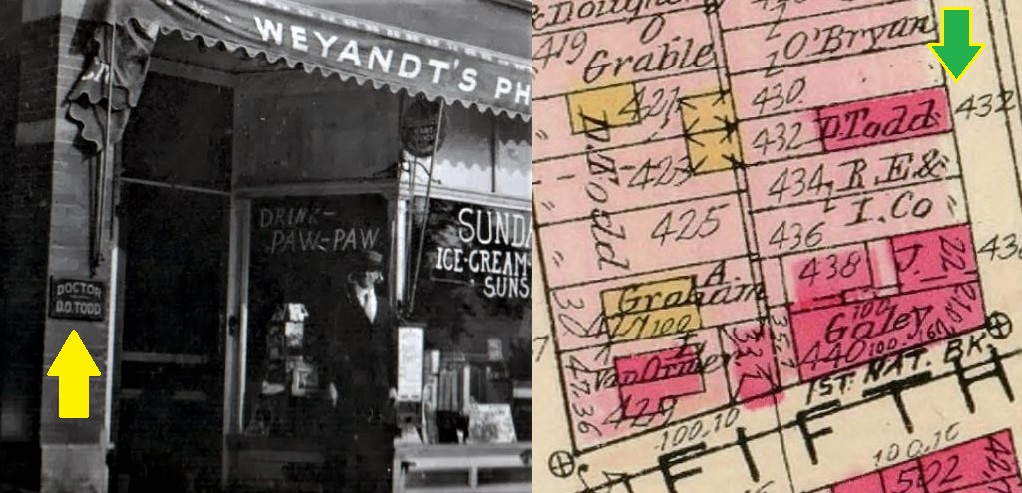
Dr. Todd practiced medicine from 432 Cavitt Ave, as well as his residence on Duquesne Ave. In addition to caring for the physical well-being of his neighbors, he took an active leadership role in the well-being of the community at large. This civic-minded physician held positions with the American Red Cross, the Trafford Board of Health, the Trafford Board of Trade, Trafford Rotary, and the local scouting group. In 1946, he was honored by the Medical Society of Pennsylvanian for over 50 years of practice.
Week 8 Published by Andrew Capets - February 20, 2019
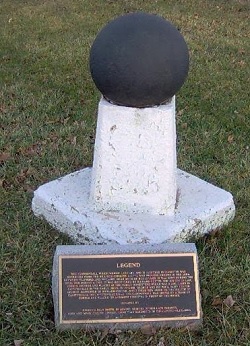 If you’ve been to Westmoreland Park in Trafford, you may have noticed a cannonball sitting at the corner of East Edgewood Ave and Bruce Street. This Civil War era relic was saved by a gentleman who once served as a Union Soldier in the Civil War, and made Trafford his home for many years. Richard Custer was born February 20, 1843, in Somerset County. He enlisted in the Pennsylvania 39th Infantry Regiment in June 1861 and served at least 3 years in the Union Army. He married Sophia Cavitt (early settlers of the area before Trafford was founded). The cannonball was recovered from the hillside opposite of present-day Cavittsville. Photo: Richard Custer 1843-1933 and Sophia Cavitt (Cavet) 1845-1932
If you’ve been to Westmoreland Park in Trafford, you may have noticed a cannonball sitting at the corner of East Edgewood Ave and Bruce Street. This Civil War era relic was saved by a gentleman who once served as a Union Soldier in the Civil War, and made Trafford his home for many years. Richard Custer was born February 20, 1843, in Somerset County. He enlisted in the Pennsylvania 39th Infantry Regiment in June 1861 and served at least 3 years in the Union Army. He married Sophia Cavitt (early settlers of the area before Trafford was founded). The cannonball was recovered from the hillside opposite of present-day Cavittsville. Photo: Richard Custer 1843-1933 and Sophia Cavitt (Cavet) 1845-1932
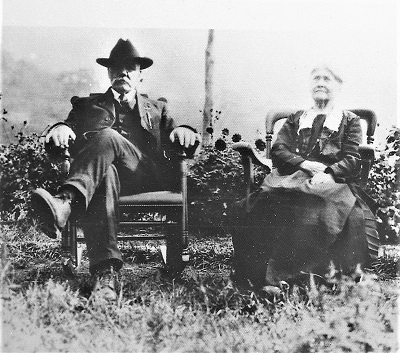
In the late 1800s, the US Army contracted with the Fort Pitt Foundry in Pittsburgh to manufacture and test their artillery (cannons). The cannon was transported by rail and usually unloaded at present-day Wall, PA. The Army tested the cannon by shooting a cannonball into the hillside near the present-day Mosside Bridge. In one instance they left the cannon on the rail car and shot the cannonball into the hillside near Mahaffey Hill Road. Richard Custer recovered this massive piece of iron in hopes of selling it back to the government. Fortunate for us, they didn't want it back, so he kept it at his home, and years later the family donated it to the community of Trafford where it stands as a physical reminder of our area's early history.
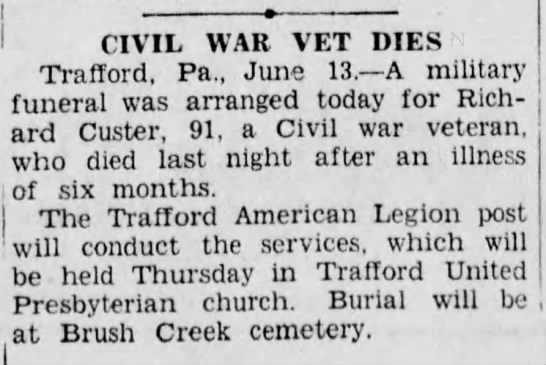
Week 7 Published by Andrew Capets - February 12, 2019
One hundred years ago in Trafford, while families anxiously awaited the return of their Doughboys from France, the community continued to fight the Spanish flu pandemic. A young minister named James Aaron Clausell moved his wife Ada, and their two children, Ruth and Walter from Monroeville, Alabama to help establish Trafford’s first African American congregation. The family lived in Wilmerding while Rev. Clausell organized the First Missionary Baptist Church in the “portable school” on Edgewood Avenue. The severe outbreak of influenza forced the congregation from using the building in order that it could be used as a hospital. The congregation later used a vacant storefront at 219 Brinton Ave for services.
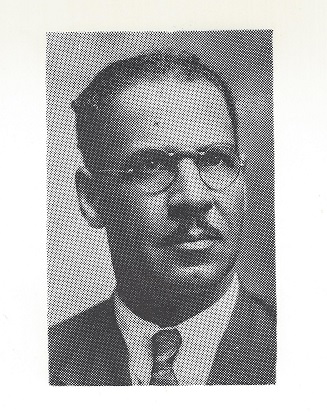
Before coming to Trafford, Clausell register for the draft in his hometown. Note how the registration card was clipped on the corner. The military was segregated during WWI, placing African American soldiers in separate units. While Rev. Clausell was not drafted, his brother John did serve in the Army with the 332nd Medical Detachment.
In February 1919, Rev. Clausell's 3-month-old son Aaron Whittier died from pneumonia. And then, only three months later, just before his brother John returned from the war, Rev. Clausell‘s three-year-old son Walter would also die from pneumonia. In July the mission was reorganized into the Mount Pleasant Baptist Church, and in the late 1940s, the congregation merged with Bethel Baptist Church.
This year marks the 100th Anniversary for Mount Bethel Baptist Church in Trafford. #52ancestors #blackhistorymonth #centennial
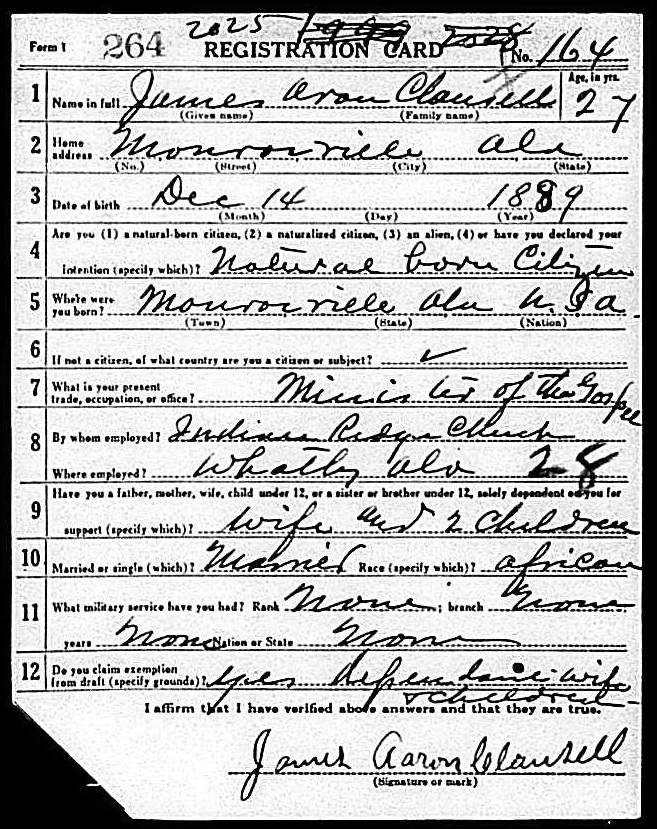
Week 6 Published by Andrew Capets - February 6, 2019
On this date, February 6, 1935, Trafford High School teacher and wrestling coach Ray Slick passed away in Trafford from pneumonia. He was only 25 years old at that time and left behind a wife and a 2-year-old son. Slick had recently graduated from Indiana State Teachers College in 1934 (present-day IUP), where he was Captain of the wrestling team, as well as a varsity player in both football and baseball.
Following the sudden death of Coach Slick, there was one young man in Trafford that pulled his team through that difficult time. As a high school senior, John ‘Apey’ Petrini took over the coaching responsibilities to allow his classmates to finish the rest of their season. Petrini lost only one match his senior year.
The young son that Ray Slick left behind, Roy Kessenich, would leave Trafford with his mother. Roy later served in the Korean War and followed in his father’s footsteps becoming a high school teacher and head coach. Two of Coach Slick’s grandsons also continued the legacy: Pace Kessenich was a high school wrestler, attended the United States Naval Academy, and also active in coaching. Quint Kessenich, attended Johns Hopkins University, was an All-American lacrosse goaltender and is an ESPN reporter who covers NCAA wrestling, among other sports.
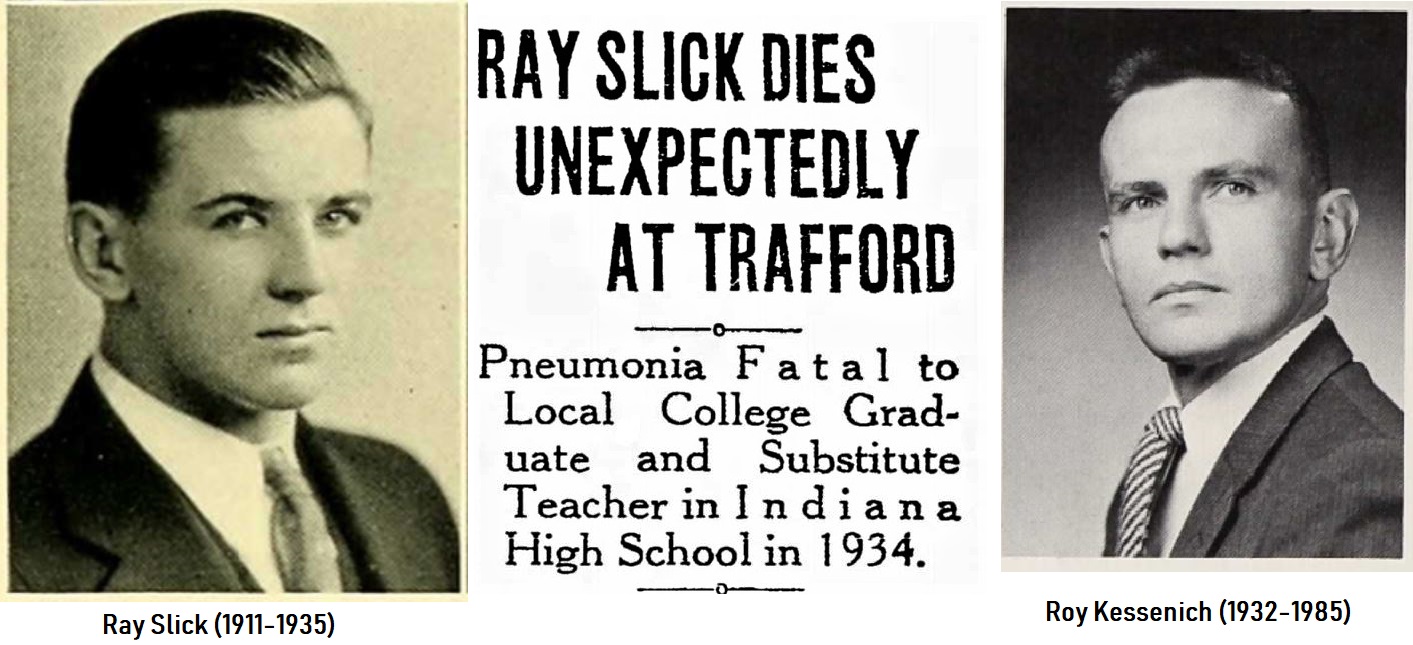
Week 5 Published by Andrew Capets - January 27, 2019
On this date, 1968, Ralph D. Wheeler III was killed in action while coming to the aid of wounded Marines under attack in the Quảng Trị Province during the Vietnam War. He was a Navy Corpsman attached to the 3rd Battalion, 4th Marine Brigade, 3rd Marines. For his actions, he was posthumously awarded the Bronze Star and Purple Heart. Wheeler was a 1966 graduate of Trafford High School. He enlisted in the Navy in September 1966 and arrived in Vietnam on Thanksgiving Day 1967. His body was returned to the United States and interred in Arlington National Cemetery.
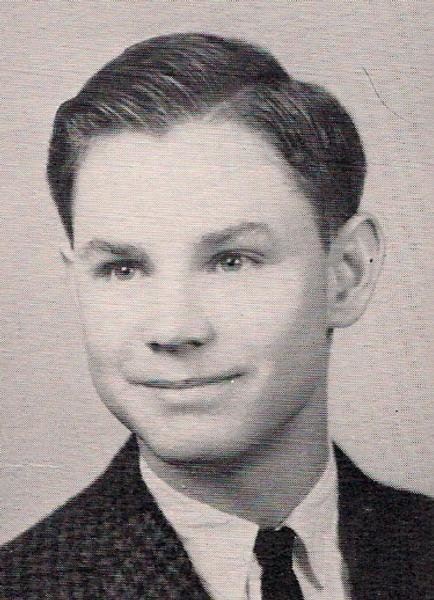
Ralph Drummond Wheeler III (1947-1968)
Week 5 Published by Andrew Capets - January 24, 2019
On this date, 95 years ago, James Joseph Mastroianni, affectionately known as “Chief,” was born in Trafford. If you were looking for an example of why Tom Brokaw coined the term the “Greatest Generation,” we simply have to look at our local history and include Mastroianni in this case study. 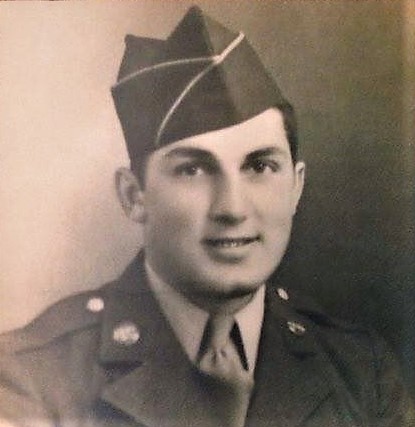 As an adolescent living through the Great Depression, he would have been witness to the daily economic struggles of a family just scraping by. It would become his primer to learning how to sacrifice or give up “things” in order to endure through hardships.
As an adolescent living through the Great Depression, he would have been witness to the daily economic struggles of a family just scraping by. It would become his primer to learning how to sacrifice or give up “things” in order to endure through hardships.
Mastroianni displayed leadership at a young age and was named the president of his Junior Class at Trafford High. Recall that the county, at that time, was deep into the war effort. The government was rationing food, fuel, and other necessities. Communities were asked to conserve just about everything. Mastroianni and his classmates even had to forgo the printing of their “Class of 1943” high school yearbook. This photo of the Junior Class of 1942 serves as yet another example of a generation that sacrificed what they must have viewed a luxury.
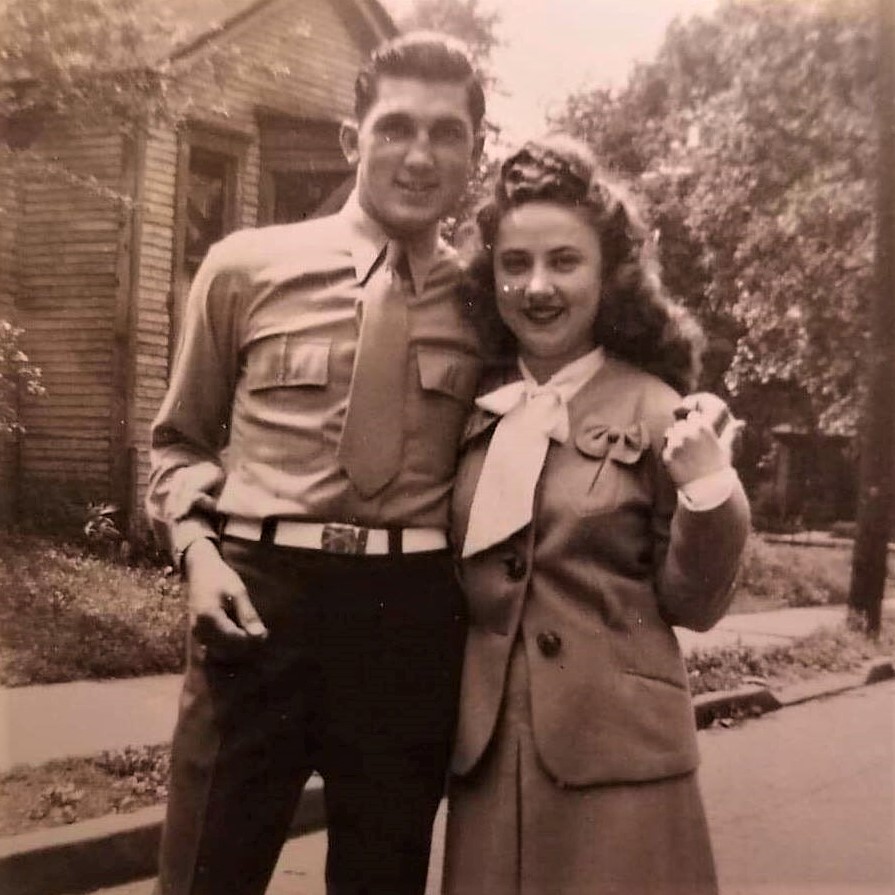 Following graduation in 1943, Mastroianni enlisted in the Army. This photo of Mastroianni and his classmate Virginia Drost was taken just before he was shipped to Europe. Two years later, Mastroianni was wounded while fighting in the Battle of Saint-Lô and would spend his 21st birthday in a German camp being held as a Prisoner of War.
Following graduation in 1943, Mastroianni enlisted in the Army. This photo of Mastroianni and his classmate Virginia Drost was taken just before he was shipped to Europe. Two years later, Mastroianni was wounded while fighting in the Battle of Saint-Lô and would spend his 21st birthday in a German camp being held as a Prisoner of War.
When the war ended, and Mastroianni was released, he returned to his beloved Trafford. He continued to display leadership and served his community for 37 years as a police officer, and then as Chief of Police for the Trafford Borough. Mastroianni passed away in 2010 at the age of 86.
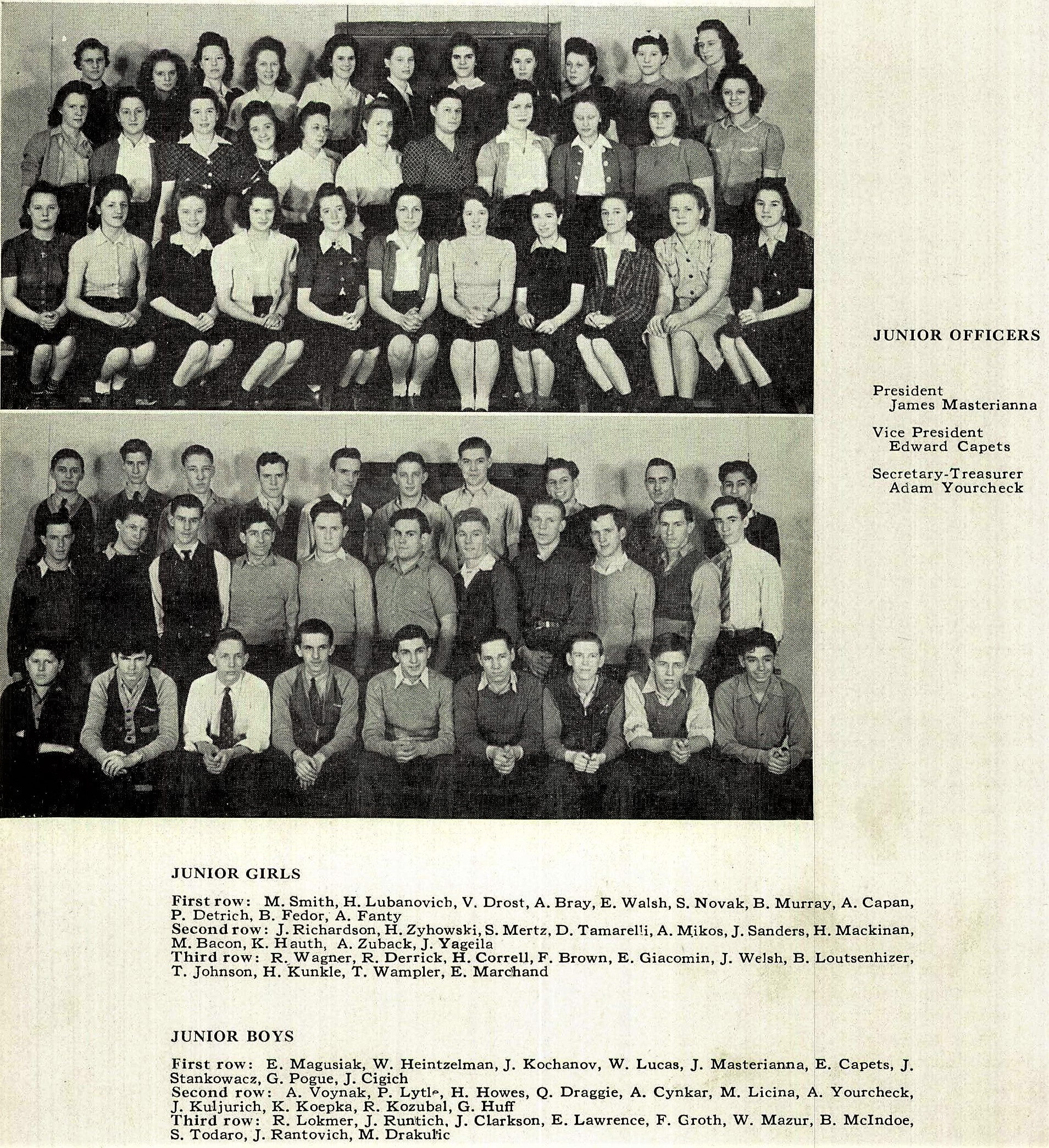
Week 4 Published by Andrew Capets - January 22, 2019
On January 22, 1951, Carl F. Foster was killed while serving in the Korean War. He was living with his parents Frank & Charlotte Foster at 1 Stewart Street in Trafford when Carl entered service for the first time in January 1943 during World War II.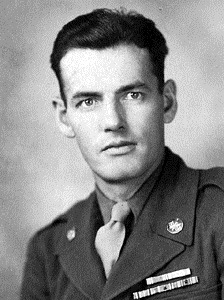 While serving his country during the Korean War, Foster was married and had three children. This photo of his daughter Betty (age 7) appeared in newspapers across the country. She was reading a birthday letter that she received from her father who wrote, "I hope you have many more birthdays and that daddy and mother can share the occasion in peace and security of a free home and country." Foster was killed in action just two days after he wrote that letter.
While serving his country during the Korean War, Foster was married and had three children. This photo of his daughter Betty (age 7) appeared in newspapers across the country. She was reading a birthday letter that she received from her father who wrote, "I hope you have many more birthdays and that daddy and mother can share the occasion in peace and security of a free home and country." Foster was killed in action just two days after he wrote that letter.
The recipient of the Silver Star and Purple Heart, his body was returned to Pennsylvania and was interred at Cross Roads Cemetery in Monroeville. His Gold Star Parents remained in Trafford until their deaths in the 1960s and were also buried in Cross Roads Cemetery. His daughter Betty passed away in 2004 at the age of 60. #52ancestors
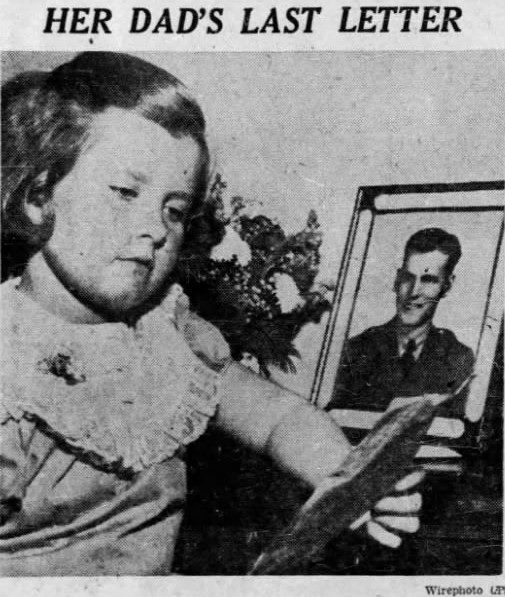
Week 3 Published by Andrew Capets - January 14, 2019
This week will mark five years since the passing of one of Trafford’s most beloved citizens, Dr. Jackson S. Pogue. He was born in Trafford on January 17, 1914, and passed away on his 100th Birthday, January 17, 2014. He graduated from Allegheny College at age 19, and completed Medical School at the University of Pittsburgh at age 24. He married Dolerus McMillen, a nurse, and the couple married in 1941. He practiced medicine in Portland, Maine, where he also served in the U.S. Public Health Service during World War II. When his father, Dr. Frank M. Pogue, retired, he asked his son to consider taking over the local practice. It was Trafford’s great fortune to have Dr. Jackson Pogue return to his hometown and serve the community for 46 years until his retirement in 1996. #52ancestors
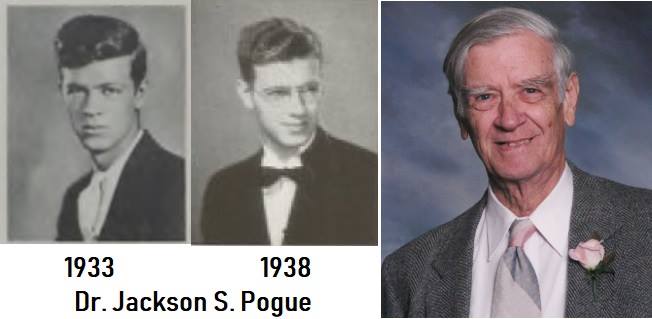
Source: dspace.allegheny.edu; digital.library.pitt.edu;triblive.com/news/allegheny/5446728-74/pogue-doctor-family
Week 2 Published by Andrew Capets · January 12, 2019
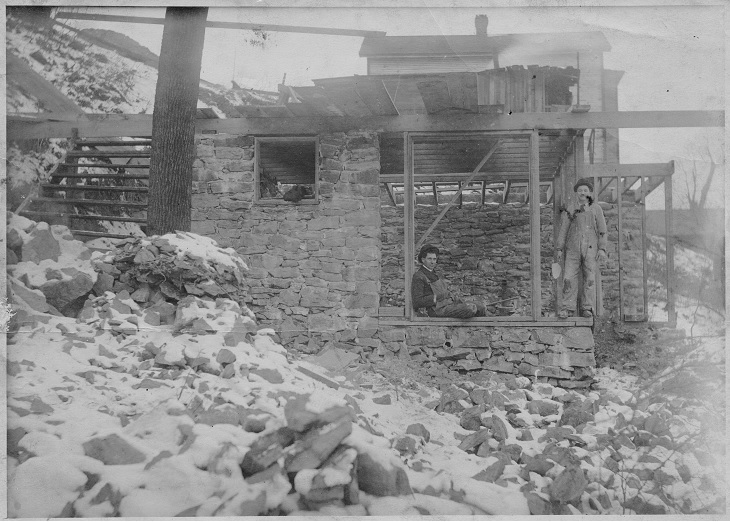
Charles J. Vitous Sr. constructed his home at 865 8th Street, Trafford, around 1915. It was built into the side of the hill and overlooked the Blackburn Wye (today known as the B.Y. Park). Vitous took a photo of the B.Y. that illustrates a steam engine heading toward Trafford with the Turtle Creek stream to the right of the tracks, the B.Y. pond on the left of the tracks, and several 8th Street homes at the top of the photo. The Vitous home, marked with the arrow, was razed in the early 1970s.
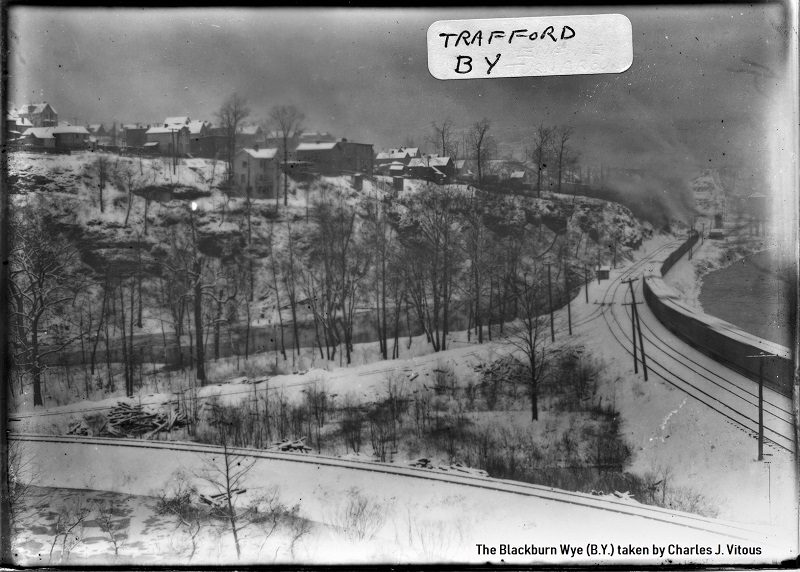
Photos courtesy: Donald Vitous
Week 2 Published by Andrew Capets · January 7, 2019
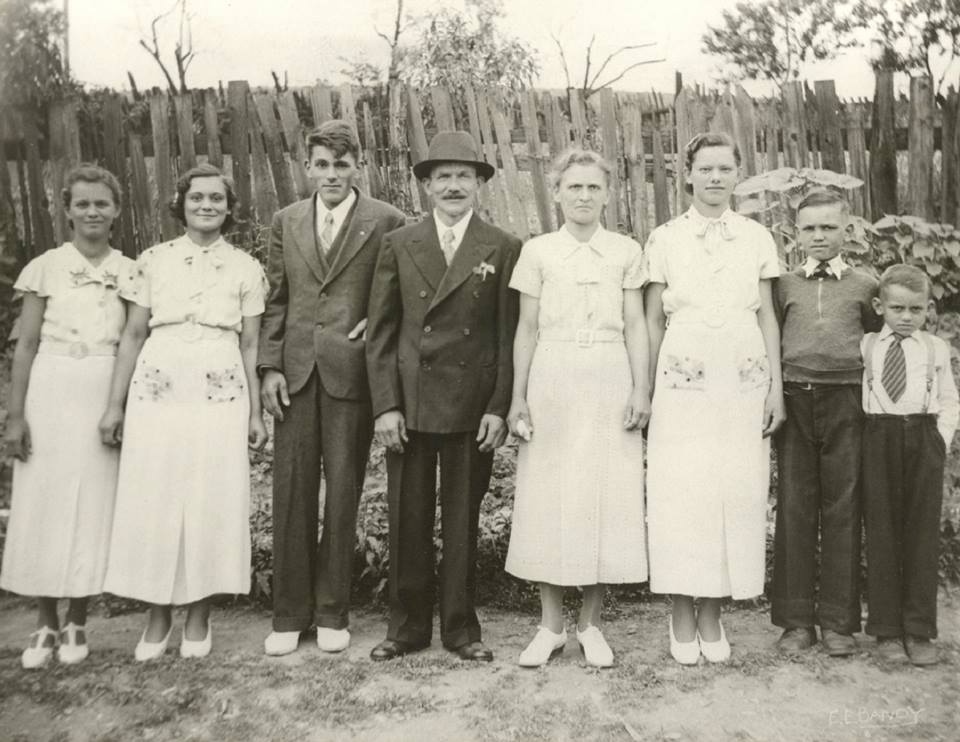
Godich Family: (L-R) Dorothy, Ann, John, Marko, Danica, Mildred, Miller, and Daniel.
This photo shows the Trafford Gold Star Family of Marko & Danica Godich, who lived at 103 First Street, Trafford, PA. The Godich family lost two of their boys while they were serving our Nation during WWII.
John Godich, the eldest son, was electrocuted on January 5, 1943, while lowering a radio aerial antenna during a training exercise at Camp Crowder, Missouri. His body was returned to Pennsylvania and services held on January 10, 1943, at Saint Michael’s Serbian Church.
Miller M. Godich died almost two years later while serving overseas with the US 5th Army. He died on December 16, 1944, from wounds he received while fighting in Italy. His body was returned to Pennsylvania and services were held on August 1, 1948, at Saint Nicholas Serbian Orthodox Church. Both men were buried at Grandview Cemetery in North Versailles.
Photo source: Mark Godich Ancestry.com
Week 1 Published by Andrew Capets · January 5, 2019
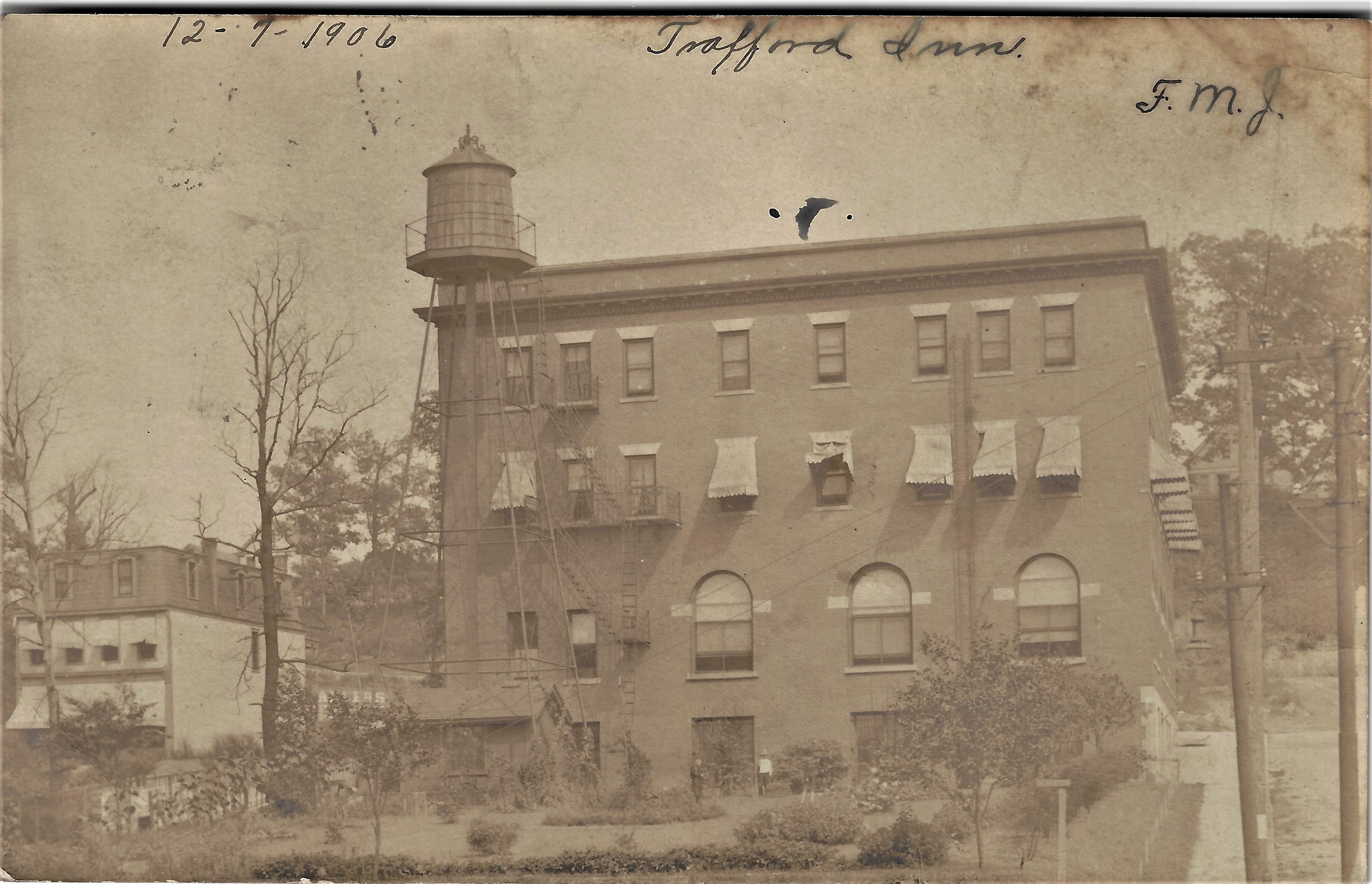 One of the earliest picture postcards taken in Trafford City in 1906 was recently donated to the Trafford Historical Society. There are several interesting items to note about this card. The postmark shows it was mailed from Stewart Station. Trafford City did not have an official post office yet. The Trafford City P.O. opened in May 1907.
One of the earliest picture postcards taken in Trafford City in 1906 was recently donated to the Trafford Historical Society. There are several interesting items to note about this card. The postmark shows it was mailed from Stewart Station. Trafford City did not have an official post office yet. The Trafford City P.O. opened in May 1907.
I wondered who might have mailed the postcard (the initials F.M.J. are on the front), and who received it? Surprisingly, a simple online newspaper archive search of the recipient's name “Viola Anderson of Parnassus PA” returned a Society Page entry from 1907 where Viola was visiting Florence Jones of Trafford City. Could Florence Jones be FMJ? Probably - there was a Florence May Jones who lived locally during that era (between Irwin and Greensburg). She could have worked or shopped in the new booming town of Trafford City.
A closer look at the postcard shows the old Trafford Inn with those wonderful awnings that surely dressed up the new building at the time. Note the fire escape and water tower, and the details on top of the water tower.
The building in the background is 512 Cavitt Avenue. At the time of this postcard, it was a grocery store and newsstand owned by John Oliver Blackburn. Most people today would remember that building as the location of the former DiRinaldo shoe repair. Thank you Kathleen McBride Gavlak for donating this photo to the THS in honor of your mom, Jane Behe McBride - Trafford High Class of 1952.
Week 1 Published by Andrew Capets · January 2, 2019
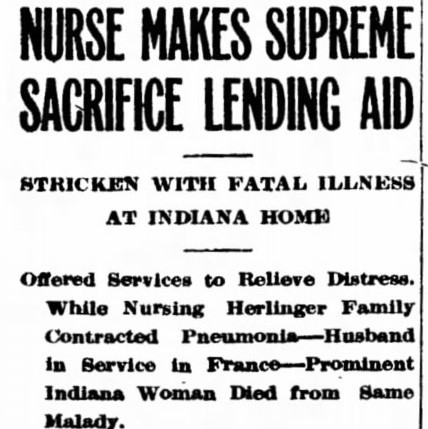
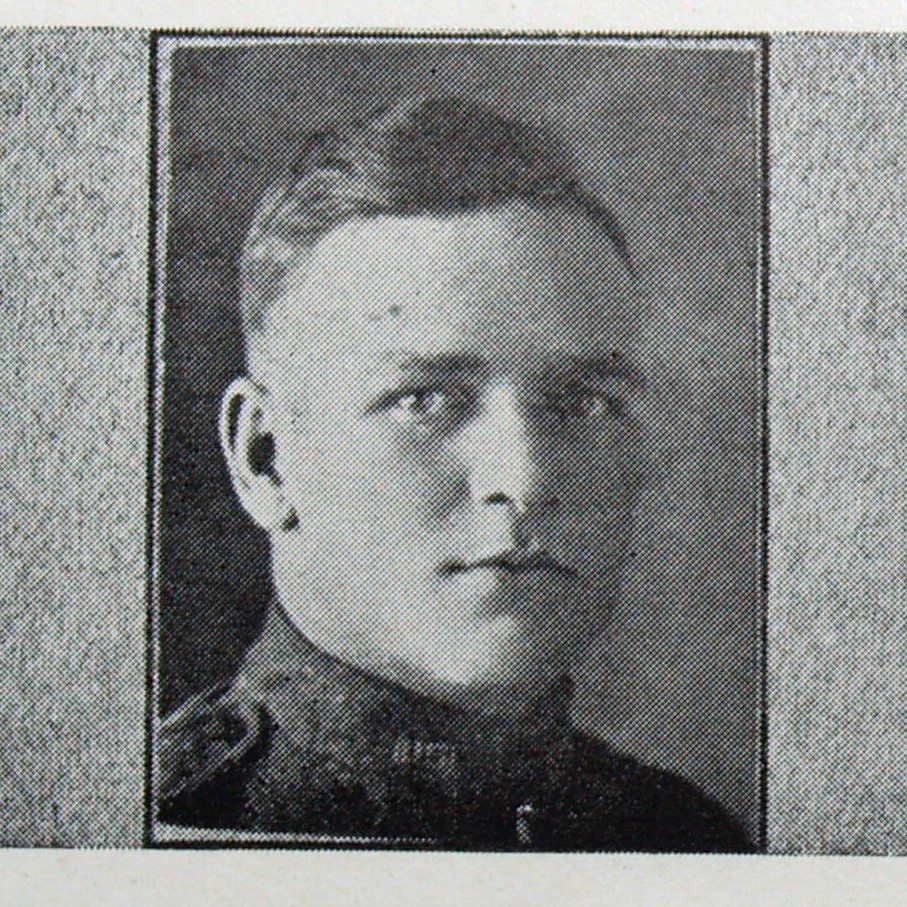
During the Centennial of the Great War, it is important that we remember those in our communities who were fighting another war on the Home-front. In particular, the doctors and nurses who came to the aid of the sick during the Spanish Flu pandemic of 1918-1919. More people died of the flu pandemic (50 million) compared to those who died during the war (16 million). Sarah Rosser Fulton died January 28, 1919, at the age of 26 after she contracted the flu while helping those in her hometown near Indiana PA. She was living in Trafford and working as a nurse in Pittsburgh. Her husband David M. Fulton of Trafford was serving overseas with the 26th Engineers when his wife died. A photo of Sarah was not available.
Source: The Indiana Progress, Indiana, Pennsylvania, Wed, Jan 29, 1919. Photo: Westmoreland Towns in the World War, 1919.
The following entries received a lot of attention on our Facebook site, and so they have been included here as a "warm-up" to the 2019 #52ancestors challenge.
2018 pre-challenge Published by Andrew Capets · December 28, 2018
Imagine floating in a hot air balloon at the edge of a battlefield. Your job was to relay enemy activity observed from this elevated platform. Through the shelling and the smoke, you need to identify enemy troop positions or report on the location of enemy artillery. This job came with great risk. Floating in an unprotected basket, filled with highly flammable hydrogen gas, you were susceptible to being hit from enemy ground fire, or worse, shot out of the air by enemy aircraft.
In 1918, this was the job of Trafford’s WWI veteran Norman B. Detrick. In 1917, Detrick was only 23 years old, working as a pattern maker in the Westinghouse foundry, when he was drafted into the Army. He saw action in the Great War while attached to the 5th Balloon Company. The balloon photos shown here are actual photos from his unit. Detrick was fortunate to have survived the war and he returned to the United States in 1919. This wonderful telegram was received by his family when they were living on Fairmont Avenue. Any parent at the time would have cherished receiving this message, “Well happy.”
Detrick returned to Trafford, and Westinghouse, to eventually work his way up to becoming a draftsman in the foundry. He married Elizabeth Gibson, and the couple had two children. He helped establish the Trafford Legion Post 331. In February 1934, Detrick applied for his WWI service compensation with the State of Pennsylvania. Unfortunately, he died just four months later at the age of 40 in the VA Hospital in Aspinwall.
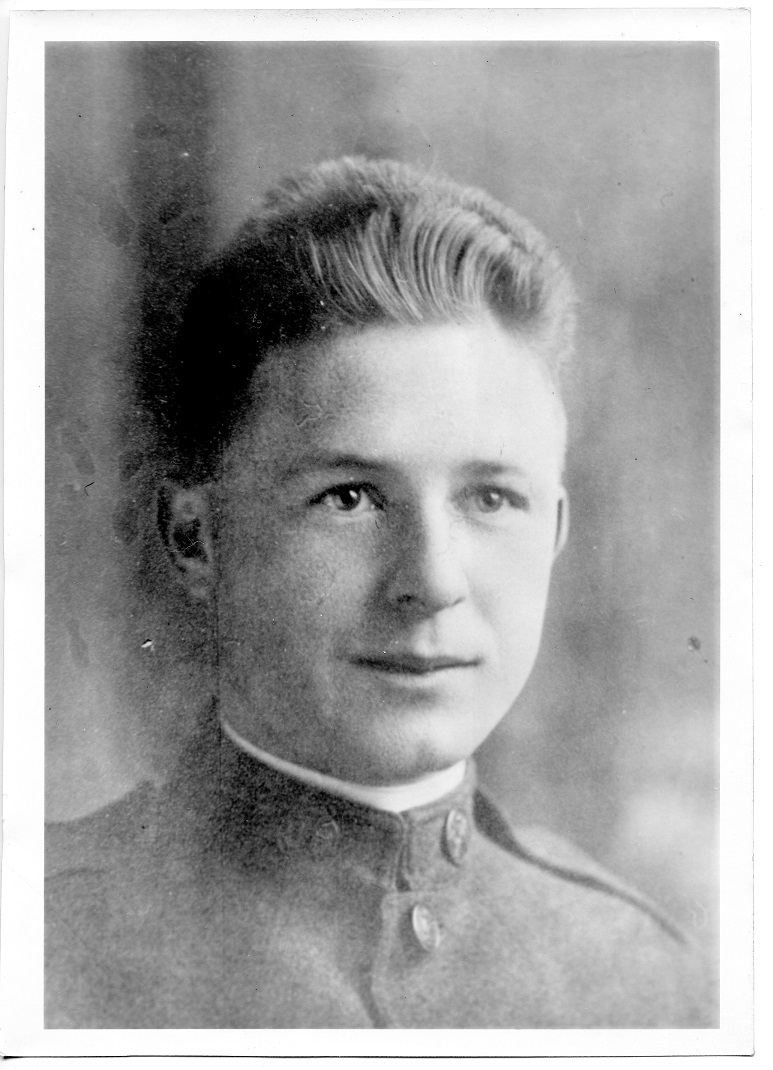
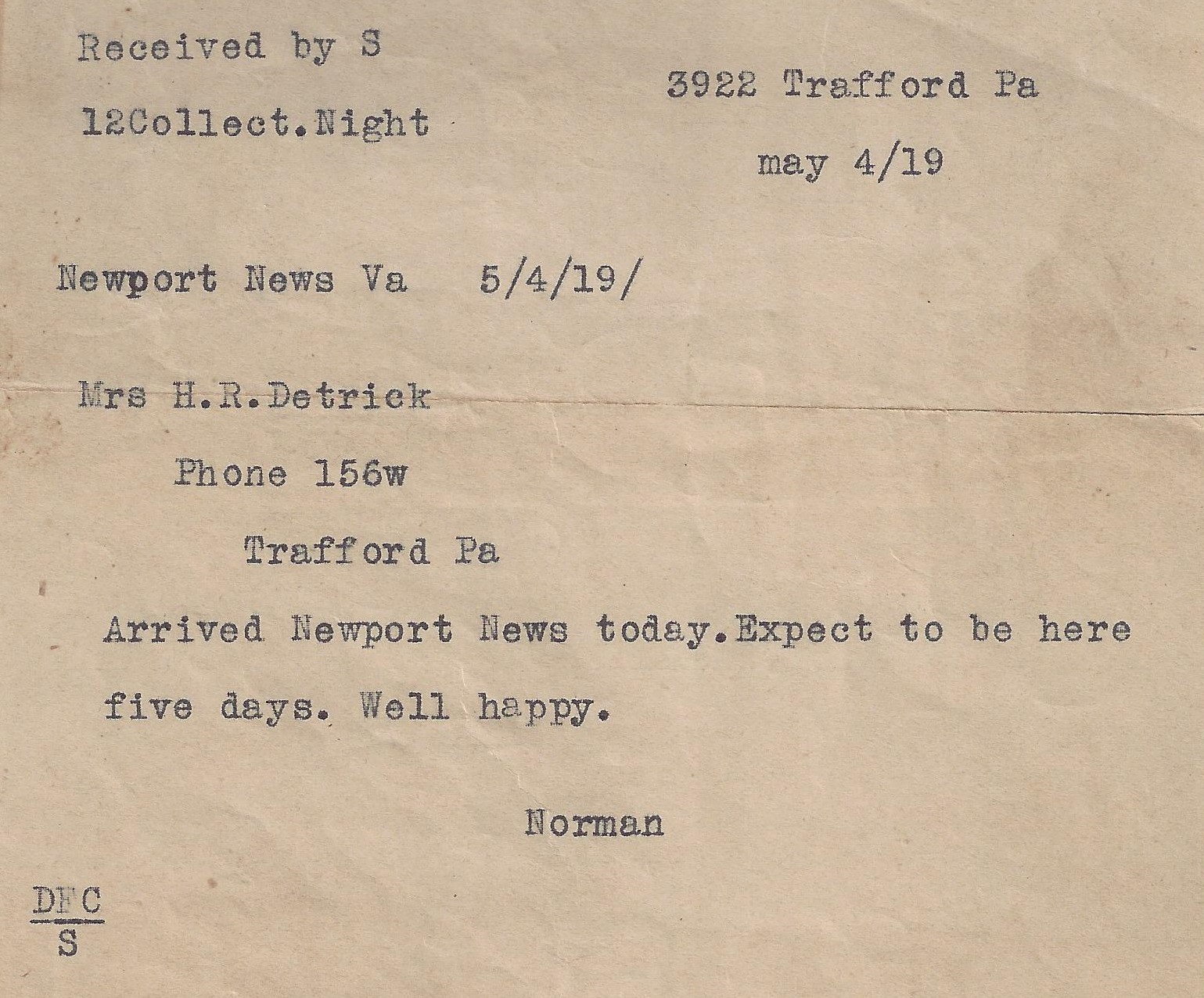
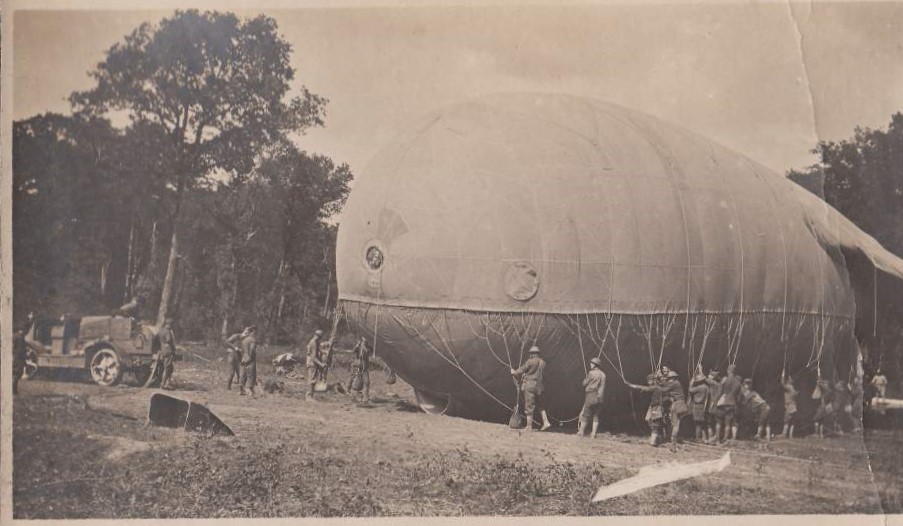
2018 pre-challenge Published by Andrew Capets · December 28, 2018
Jesse Walker Sr was born in Trafford in 1921. During WWII, he served in the US Navy from August 1942 to April 1946. Boxing aboard a ship in those days was a common form of recreation, and it was likely the genesis to Jesse Walker’s boxing days on the Pittsburgh circuit. Walker boxed at venues like the Zivic Arena in Millvale and the Duquesne Gardens in Pittsburgh. Walker’s debut match occurred four months after being discharged from the Navy. He was asked to substitute for another boxer and was matched up against veteran boxer Johnny “Red” Cregan, who already had 32 fights under his belt. It was Cregan’s first fight since being discharged from the Army and he defeated Walker in a six-round decision at the Zivic Arena. Walker was a welterweight fighter, and his first professional win came just 40 days after he was married to Martha Vire. It was March 27, 1947, when Walker defeated Nate Smith in a six-round decision at the Aragon Gardens on Penn Avenue in Pittsburgh. Walker has a record of 8 professional fights, and his “official” boxing record is 2-6 according to BoxRec, an online forum for recording professional bouts. However, the website does not account for other fights Walker participated in, such as the local Dapper Dan Charity boxing matches. As for local Trafford History, it is also important to note that Jesse Walker had eight children, was a member of Trafford Borough Council, and was once the Chairman of the Deacon’s Board at Mount Bethel Baptist Church in Trafford. Jesse Walker Sr passed away on January 30, 1979.
He was asked to substitute for another boxer and was matched up against veteran boxer Johnny “Red” Cregan, who already had 32 fights under his belt. It was Cregan’s first fight since being discharged from the Army and he defeated Walker in a six-round decision at the Zivic Arena. Walker was a welterweight fighter, and his first professional win came just 40 days after he was married to Martha Vire. It was March 27, 1947, when Walker defeated Nate Smith in a six-round decision at the Aragon Gardens on Penn Avenue in Pittsburgh. Walker has a record of 8 professional fights, and his “official” boxing record is 2-6 according to BoxRec, an online forum for recording professional bouts. However, the website does not account for other fights Walker participated in, such as the local Dapper Dan Charity boxing matches. As for local Trafford History, it is also important to note that Jesse Walker had eight children, was a member of Trafford Borough Council, and was once the Chairman of the Deacon’s Board at Mount Bethel Baptist Church in Trafford. Jesse Walker Sr passed away on January 30, 1979.



